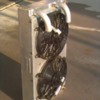Hi Tom,
Thanks. No, I didn't make any such mods to the sway bar mounts. I only heated them to square up the studs, as they were going all directions. The bolt on e-brake bracket sounds like a good idea.
Hi Gary,
Thanks for posting the pics/ideas. The trunk upgrades look fantastic, nice finished off look. I love the clean look.
Side frame rails mods are a great idea, and I like the gussets you have added. I was talking with Kirk about ideas in this area too. While I like them all in principle, not sure I'm going to cut open the frame only for this. I may include some mods inside the front radiator support when I have that open.
I checked out other pages on your site. Nice metal work!
Thanks again.
OK, so I've been able to spend about an hour each night over the past few days in the shop. I finished welding and grinding the jacking pad, and made the tin cover. I'm going to hold off on welding it on, as I'm thinking I'm going to pick up a cheapo spot welder considering the pending rocker panel work.
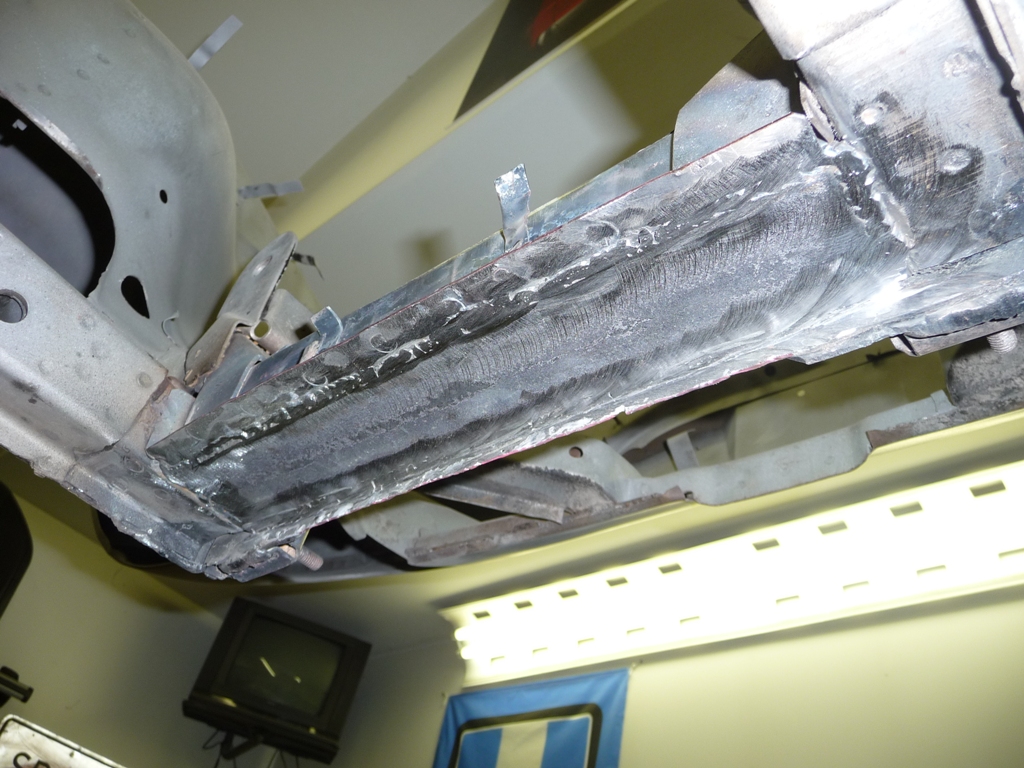
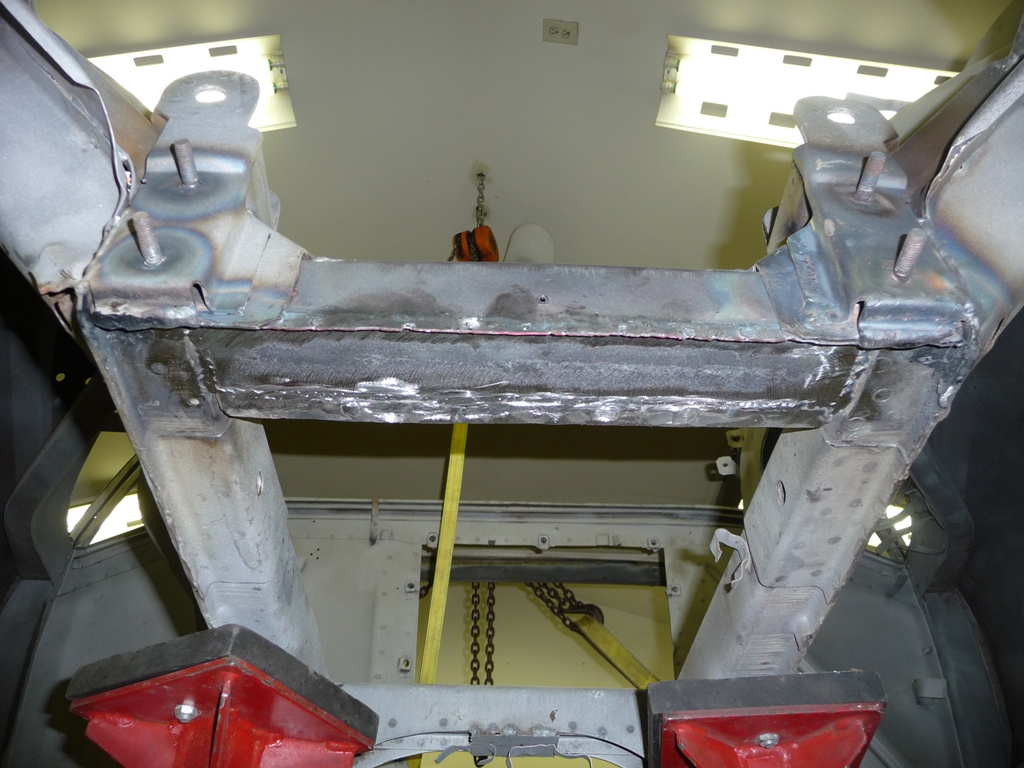
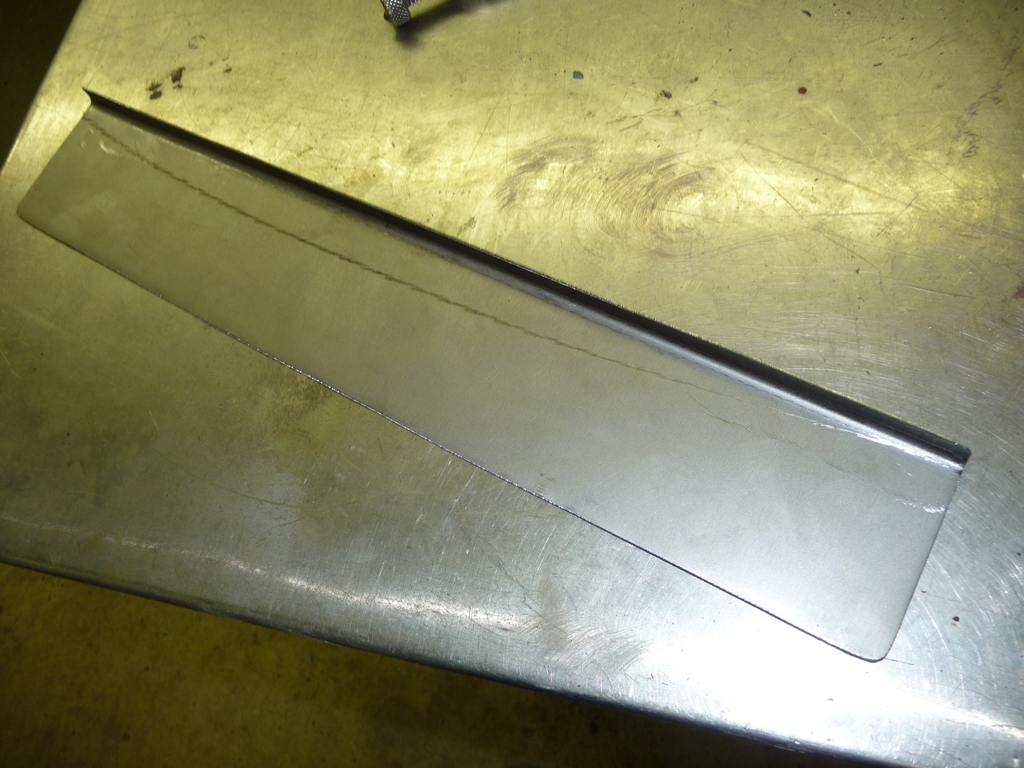
Next was to repair the torn hole by the cross member.
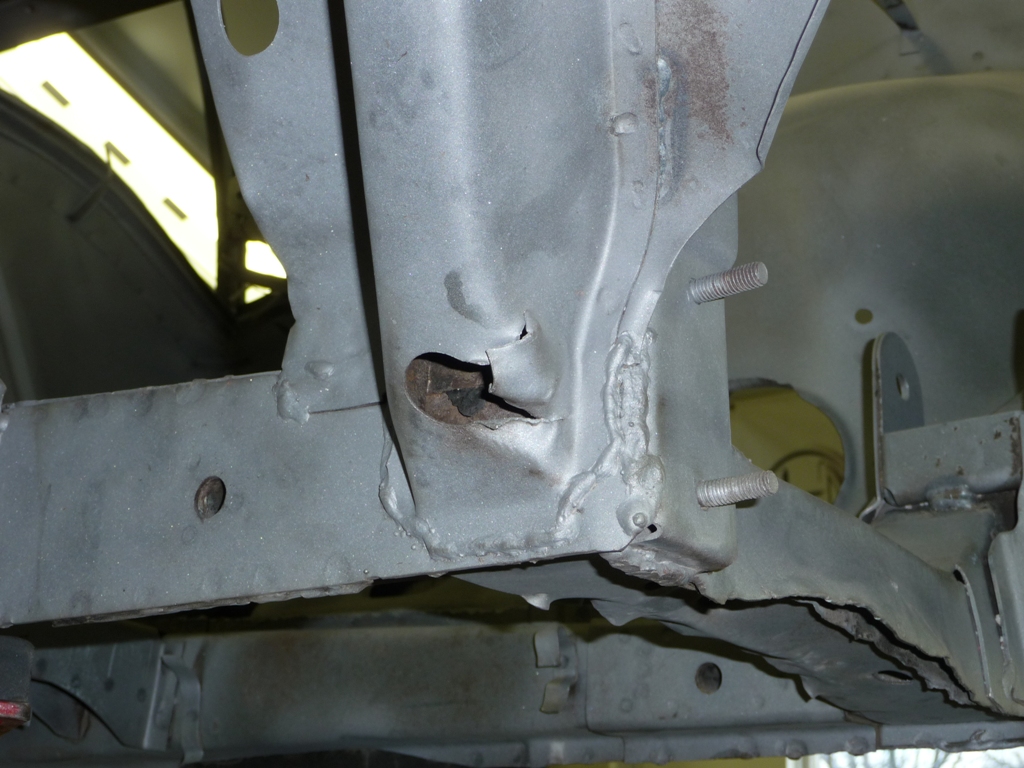
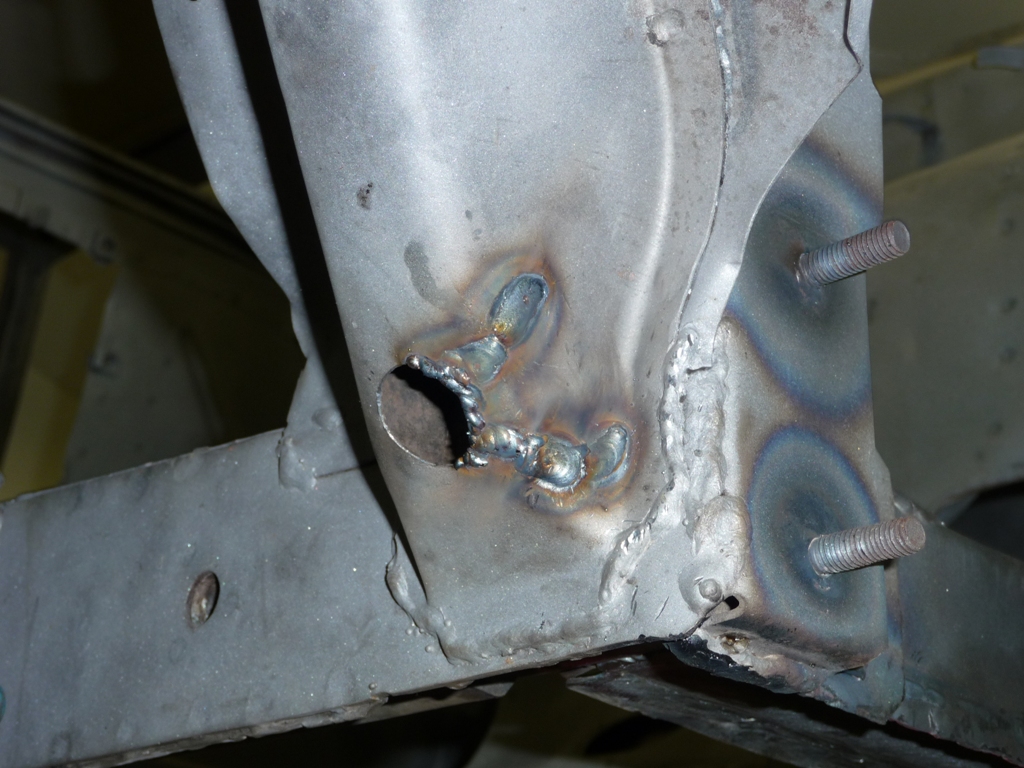
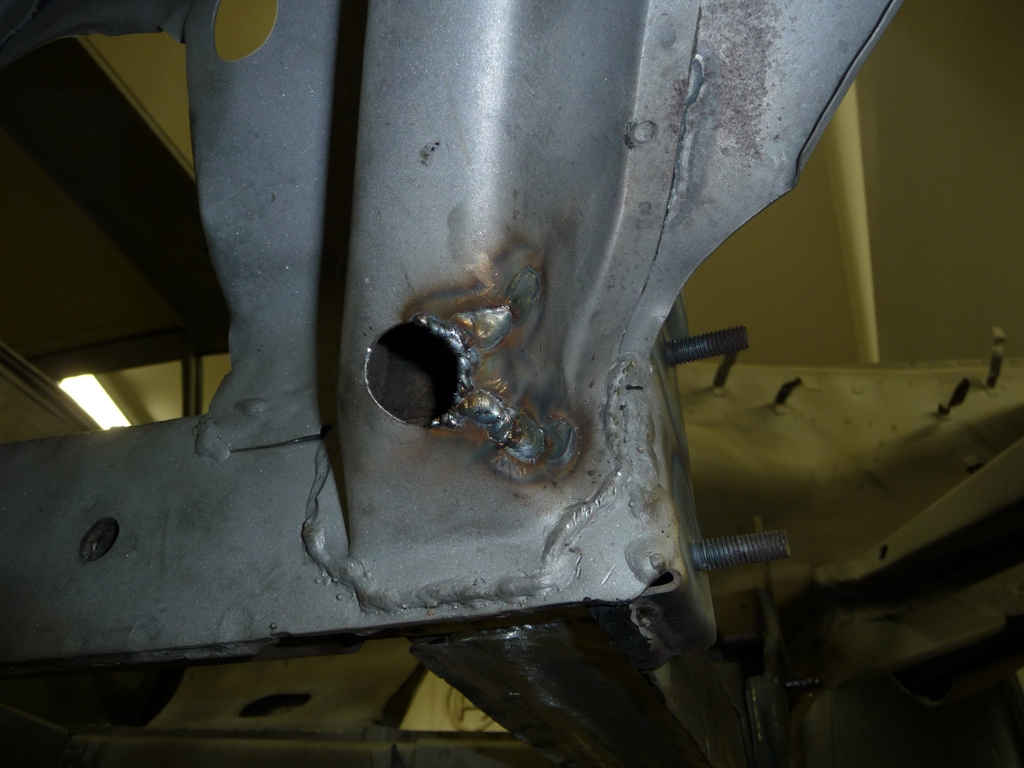
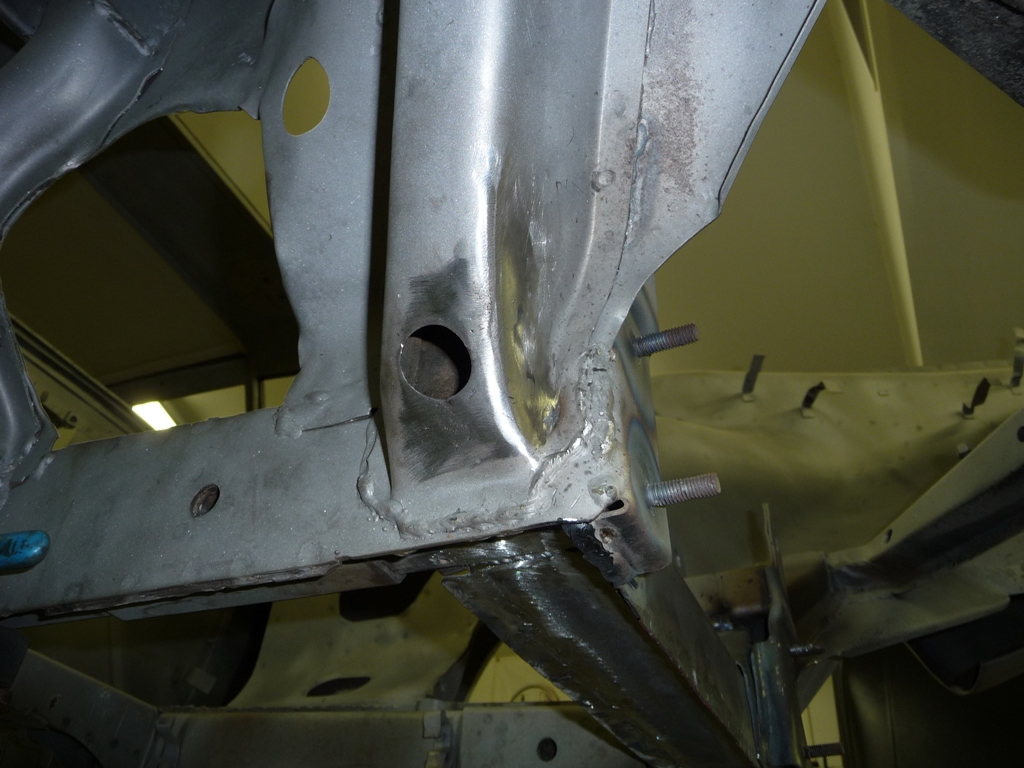
Then I hammered out a dent in the frame rail just above the hole repair. I drilled a hole on the front side, and used a punch as a dolly and took my time with the hammer.
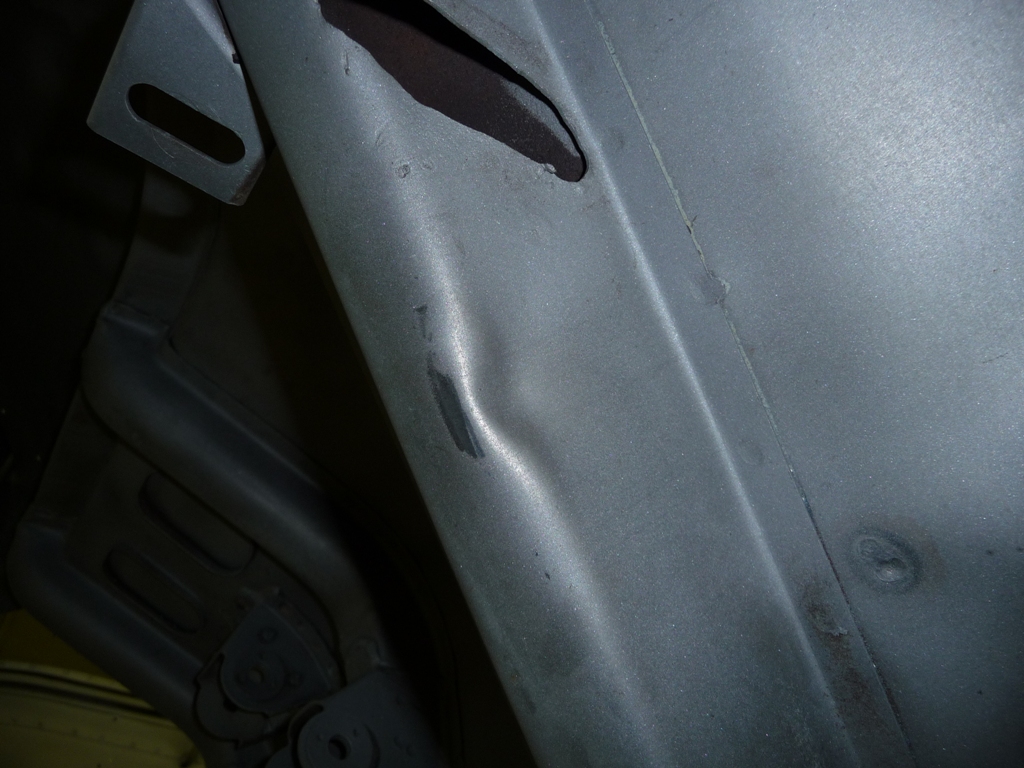
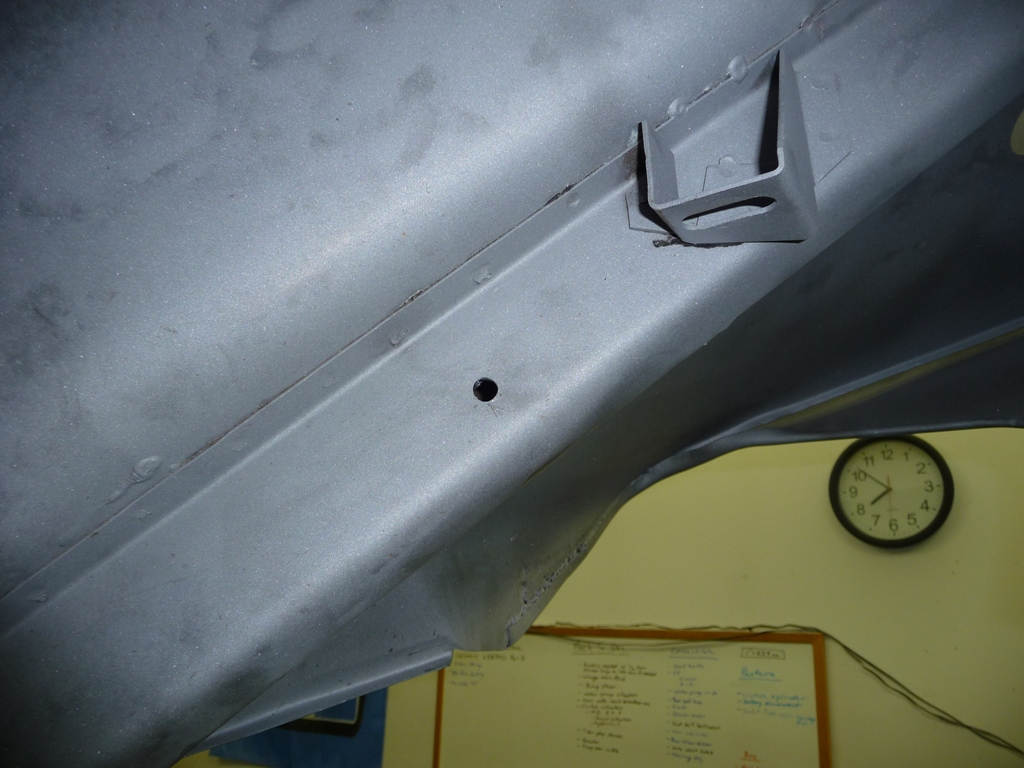
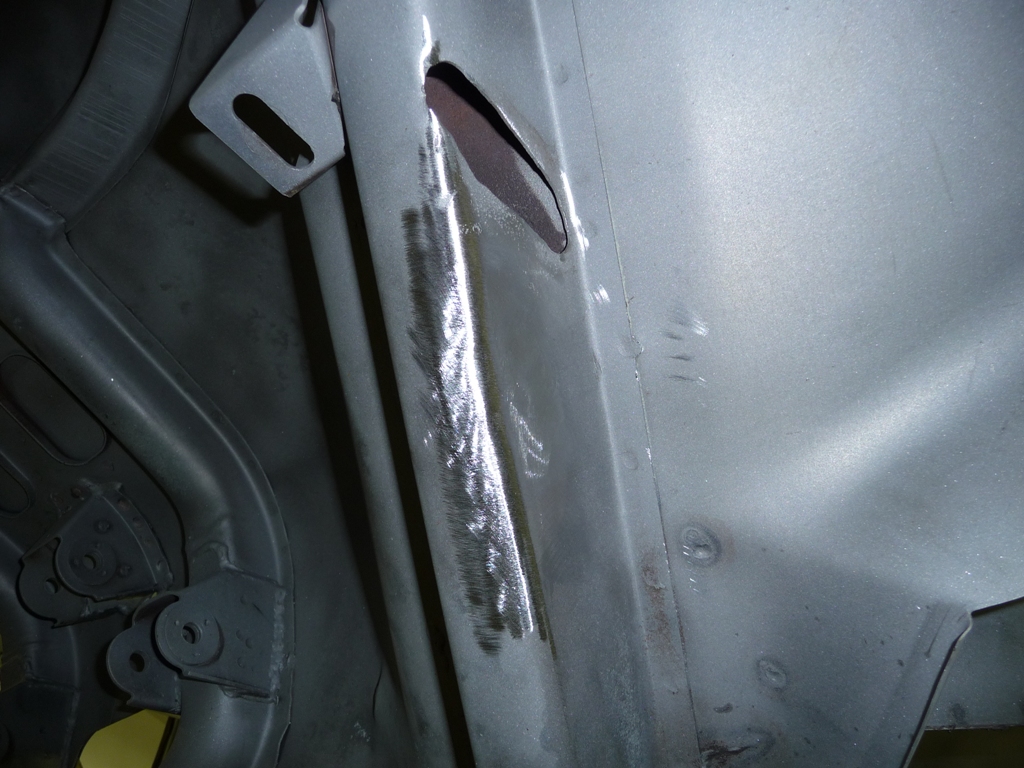
Next project will be to fill in the hole of unknown purpose above the dent repair.
Ta ta for now...
Next was to repair the torn hole by the cross member.
Then I hammered out a dent in the frame rail just above the hole repair. I drilled a hole on the front side, and used a punch as a dolly and took my time with the hammer.
Next project will be to fill in the hole of unknown purpose above the dent repair.
Ta ta for now...
Hi Rob,
Looking great! Really enjoyed my trip up last week even though the drive was a bit snow-nasty. I loved your shop location with drive time to hobby cars less than 50 steps---yes a beautiful home with the garage/shop combo attached---can't beat it.
To all---Rob has allot of history in Mustangs with numerous restorations under his belt and a successful parts development background he may wish to explain in the future.
Keep up the good work my friend.
Kirk
Looking great! Really enjoyed my trip up last week even though the drive was a bit snow-nasty. I loved your shop location with drive time to hobby cars less than 50 steps---yes a beautiful home with the garage/shop combo attached---can't beat it.
To all---Rob has allot of history in Mustangs with numerous restorations under his belt and a successful parts development background he may wish to explain in the future.
Keep up the good work my friend.
Kirk
Very impressive work, but even more impressive progress. I'm starting to wonder if your wife is away on holidays with the kids! It's fun to follow the work and thanks for posting the details and pics Rob.
Mark
Mark
Thanks guys...
Kirk, It was great meeting and chatting with you. You have a wealth of knowledge trapped in your grey matter... I'm glad you made it home OK. For those that don't know, we had a couple weeks of wicked "real" winter weather in the region. Kirk decided to test his driving skills and come up at the front end of that stuff. I'd be happy to share whatever info is of interest to anyone. I've restored quite a few vintage stangs, mostly 69s. My personal 69 Mach was a 3yr journey of extensive modifications. If interested, you can view the build here: Rob's Mach I I'd be happy to share any nuggets of "wisdom" I've accumulated if anyone is doing one.
I'm glad you made it home OK. For those that don't know, we had a couple weeks of wicked "real" winter weather in the region. Kirk decided to test his driving skills and come up at the front end of that stuff. I'd be happy to share whatever info is of interest to anyone. I've restored quite a few vintage stangs, mostly 69s. My personal 69 Mach was a 3yr journey of extensive modifications. If interested, you can view the build here: Rob's Mach I I'd be happy to share any nuggets of "wisdom" I've accumulated if anyone is doing one.
Mark...are you implying that I might be neglecting my family responsibilities.... um...well...
um...well...
Regarding progress:
I managed to get up early both sat and sun and get a few hours in each day prior to the family emerging from their tombs. Got a few more small projects hammered out. Even tried out the new spot welder. I'll try and get an update posted tonight.
Kirk, It was great meeting and chatting with you. You have a wealth of knowledge trapped in your grey matter...
Mark...are you implying that I might be neglecting my family responsibilities....
Regarding progress:
I managed to get up early both sat and sun and get a few hours in each day prior to the family emerging from their tombs. Got a few more small projects hammered out. Even tried out the new spot welder. I'll try and get an update posted tonight.
OK, so here's what I got done over the weekend.
Made filler patches for the holes of unknown purpose. My method in this type of situation is to make my patch an exact duplicate of the hole. Weld them and ground them clean. The wire is just a handle so I could hold them in place to shape and weld them. (both sides were the same project, so only showing the one)
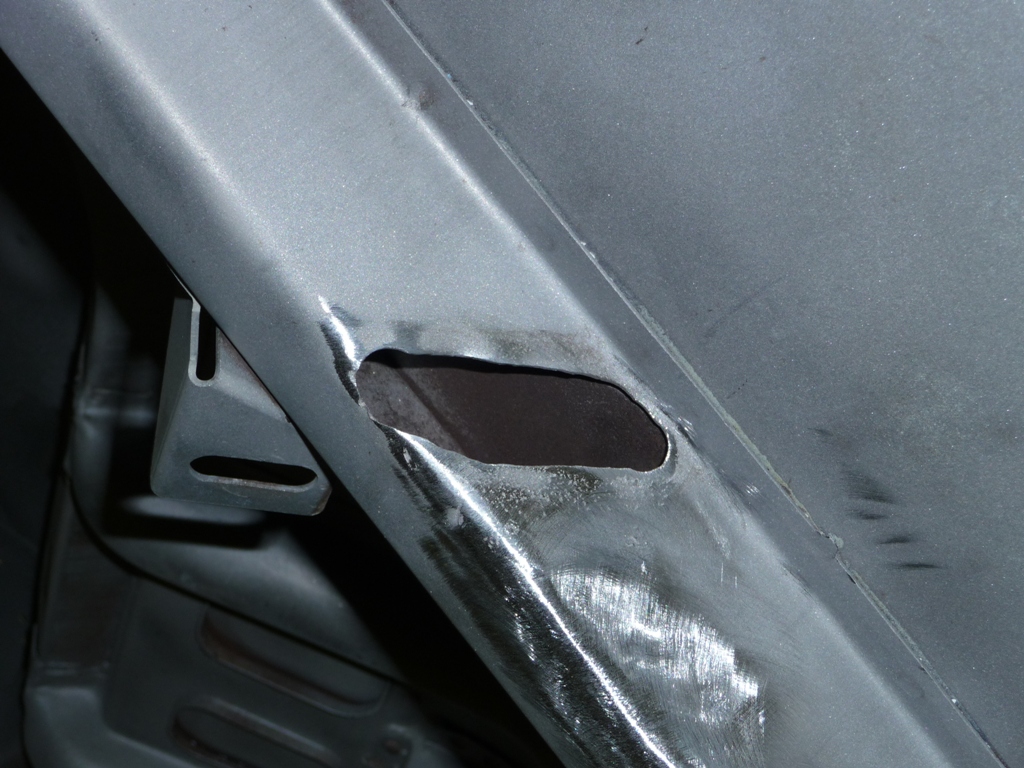
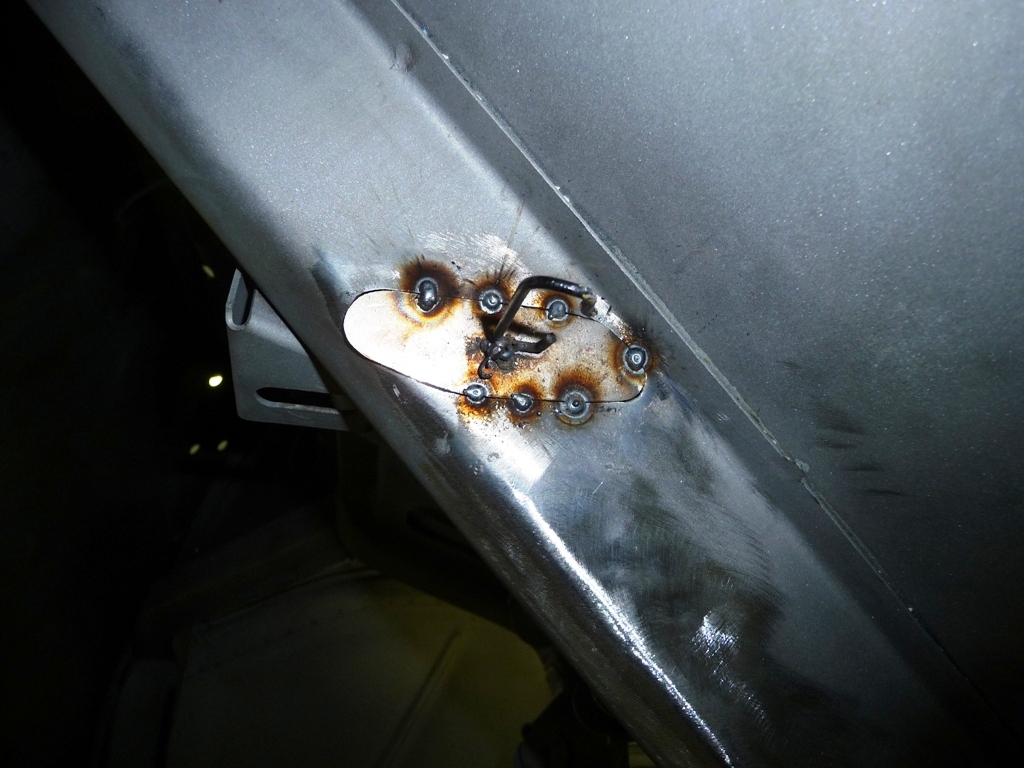
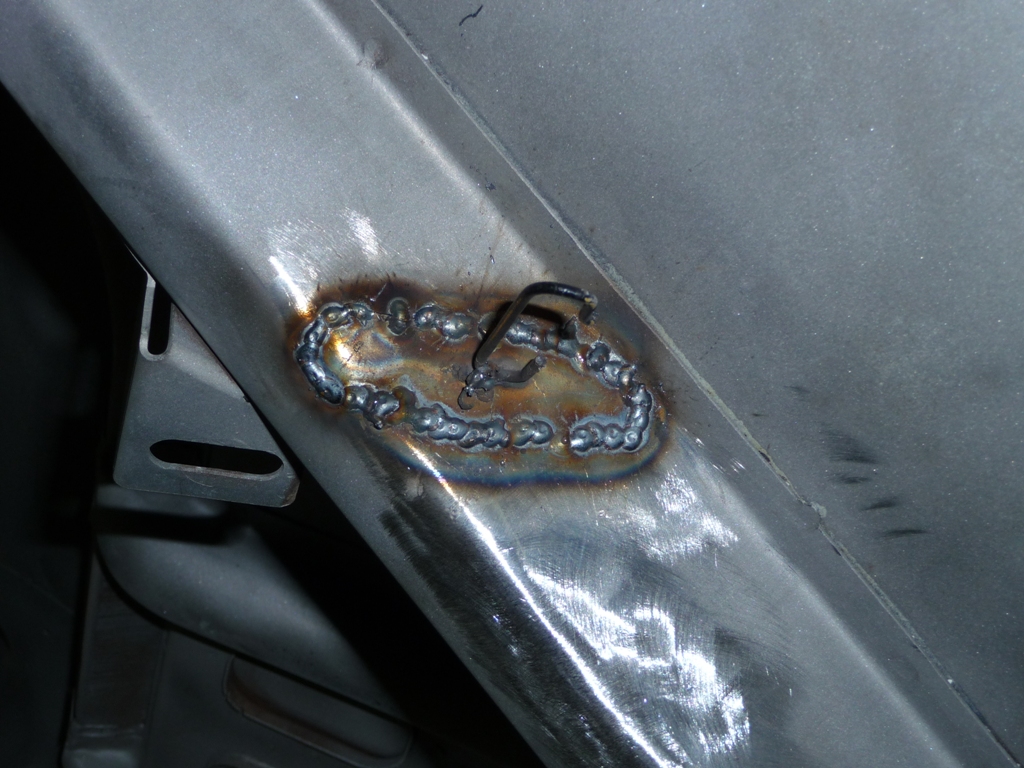
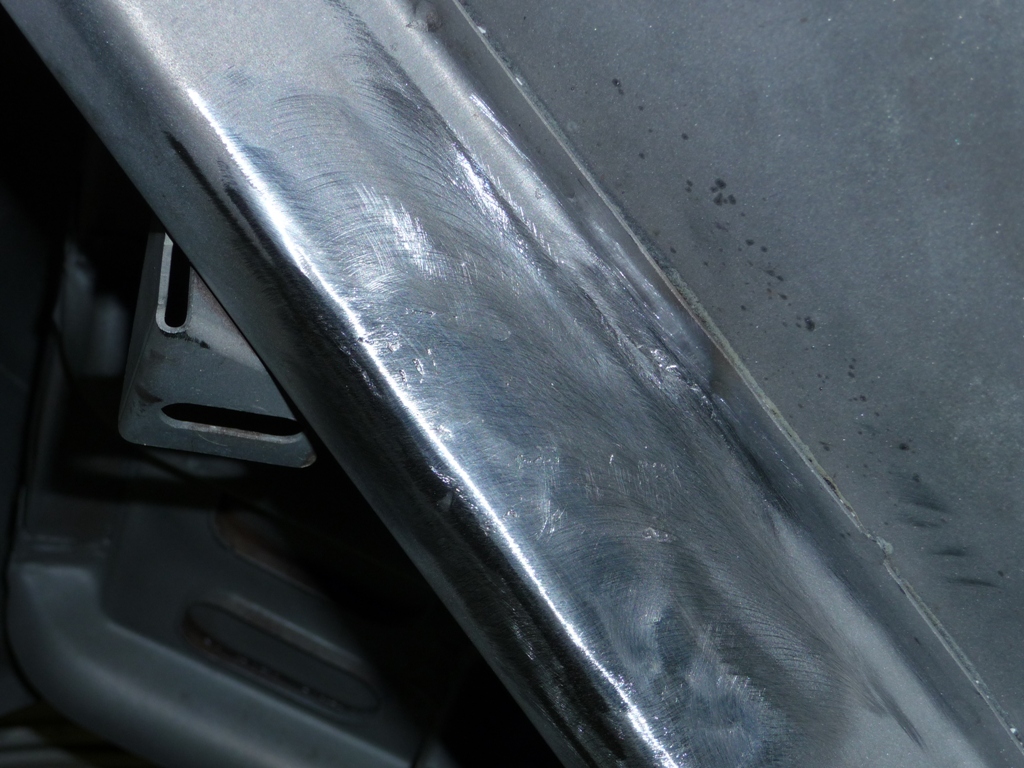
Then a knocked out the E-brake reaction bracket. Cut the crappy welds off, ground it clean, welded up the holes and dents and remounted.
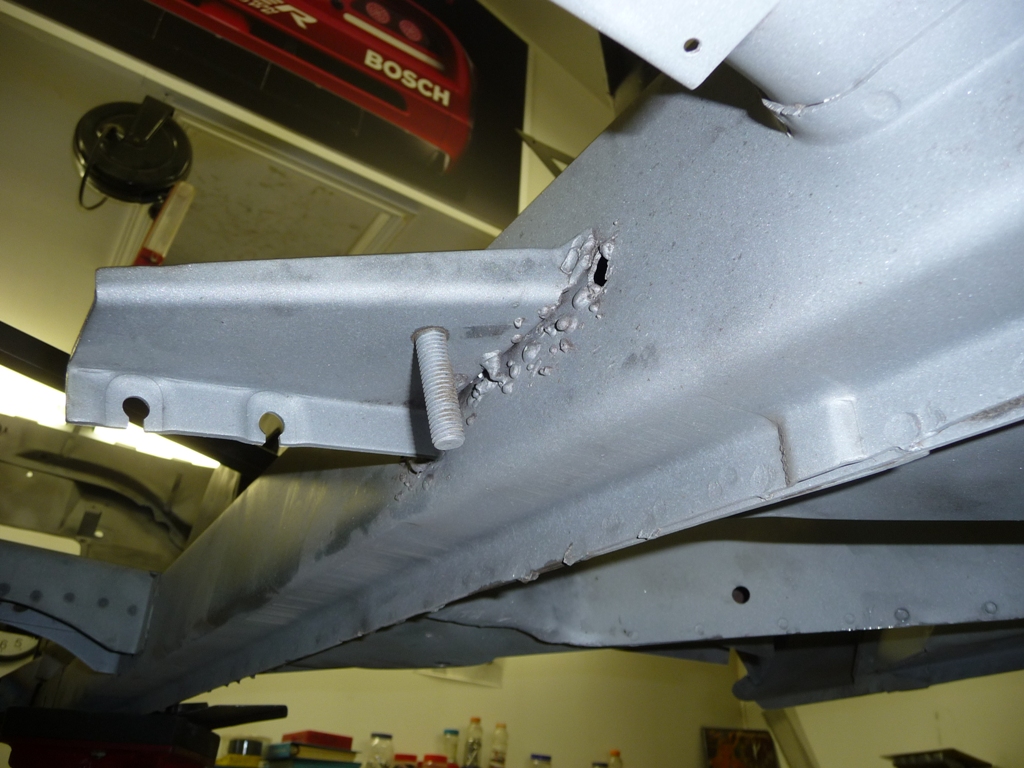
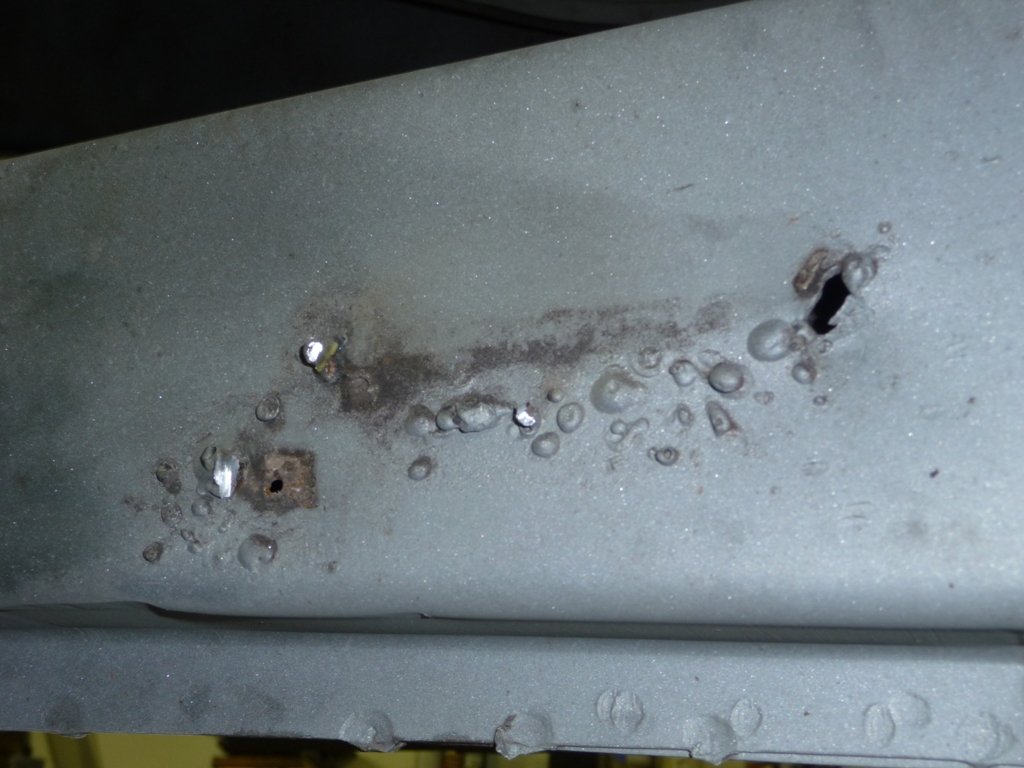
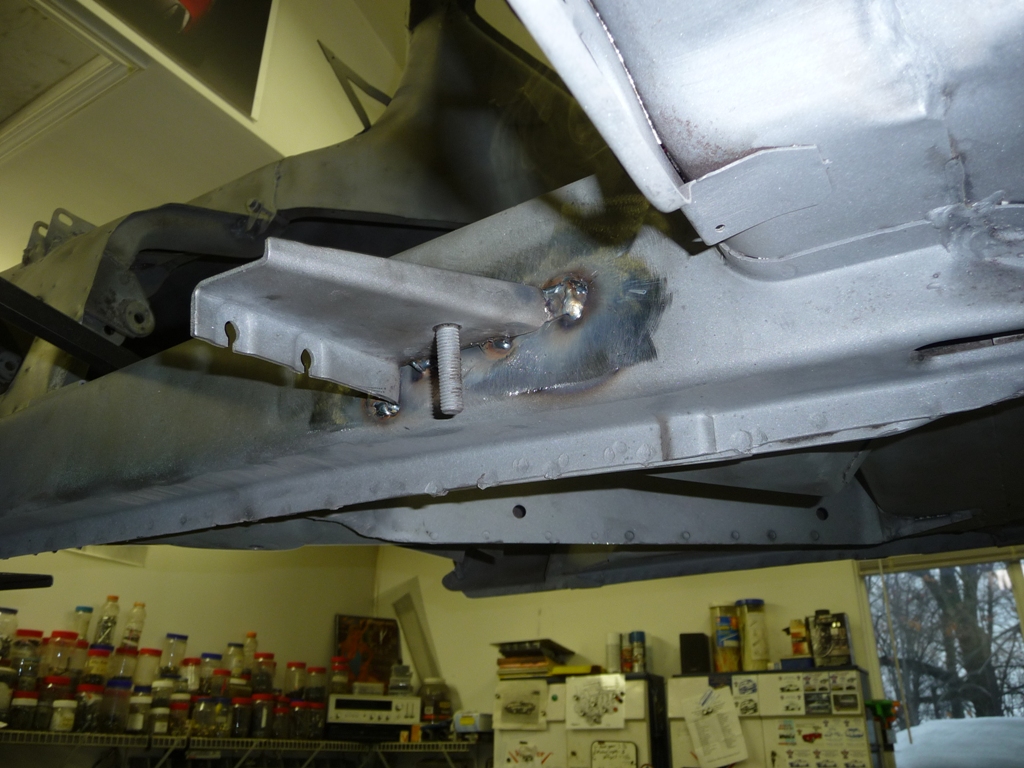
Then took on the frame under the driver's side engine mount. It was badly bent. Looks like a large rock was hit or something like that. I think this car spent more time in ditches...than on the road.. I hammered the lip back, separated the joint, hammered the bottom panel down with a slide hammer, then shaped the bottom by using a punch through a drilled hole again.
I hammered the lip back, separated the joint, hammered the bottom panel down with a slide hammer, then shaped the bottom by using a punch through a drilled hole again.
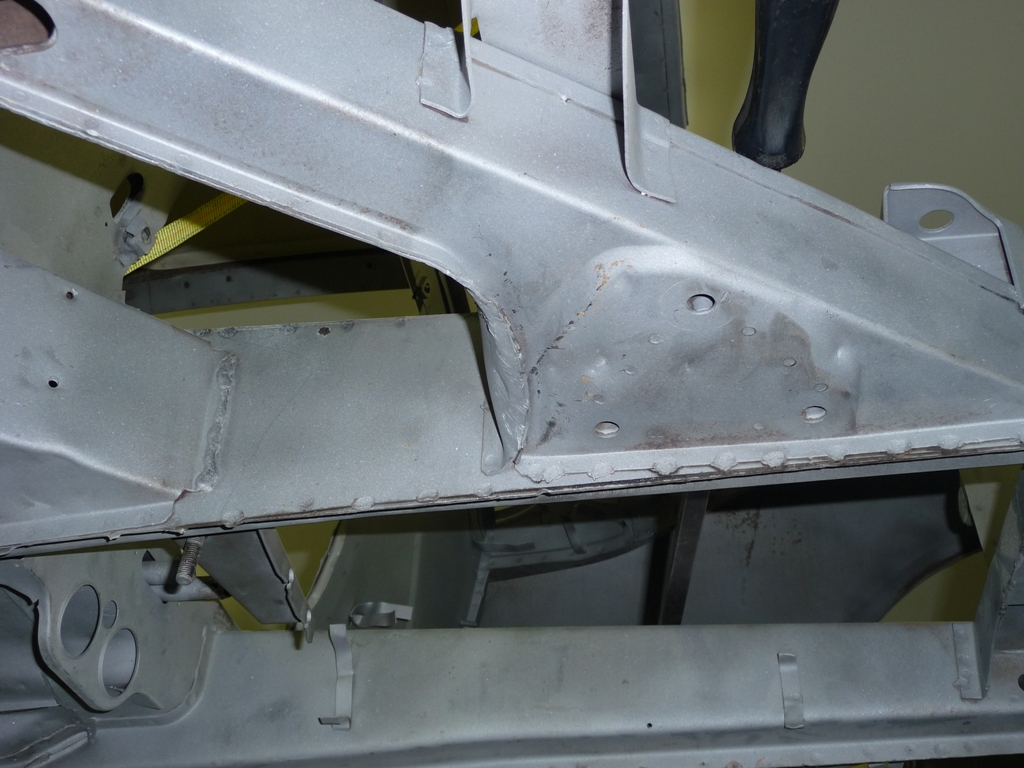
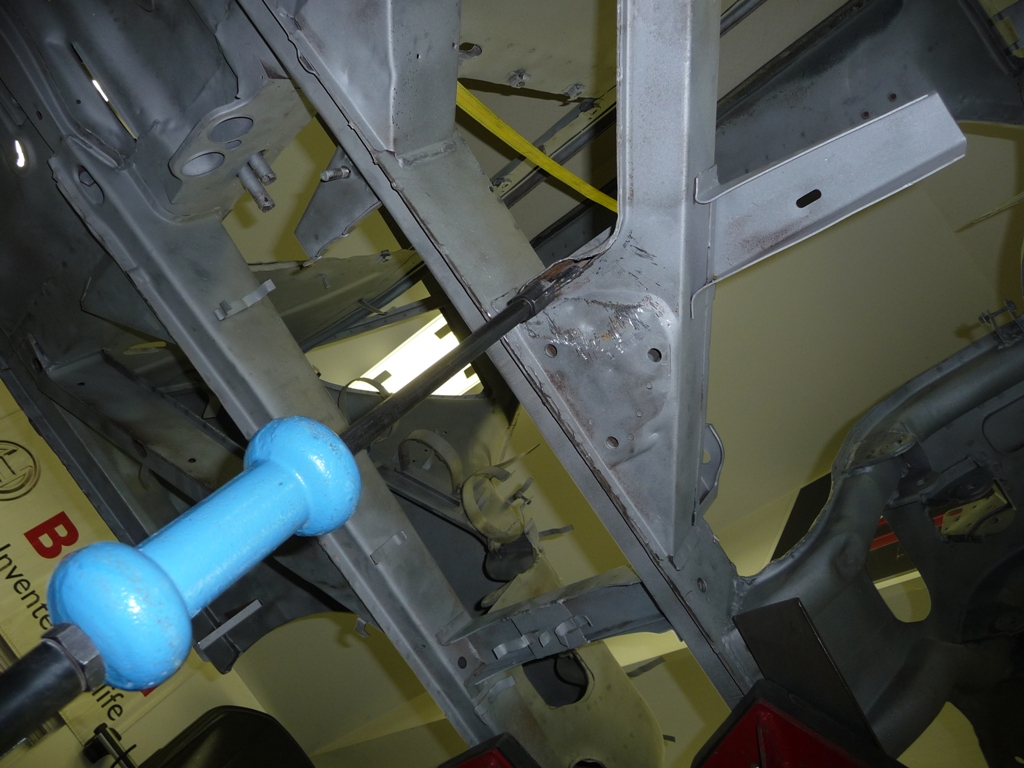
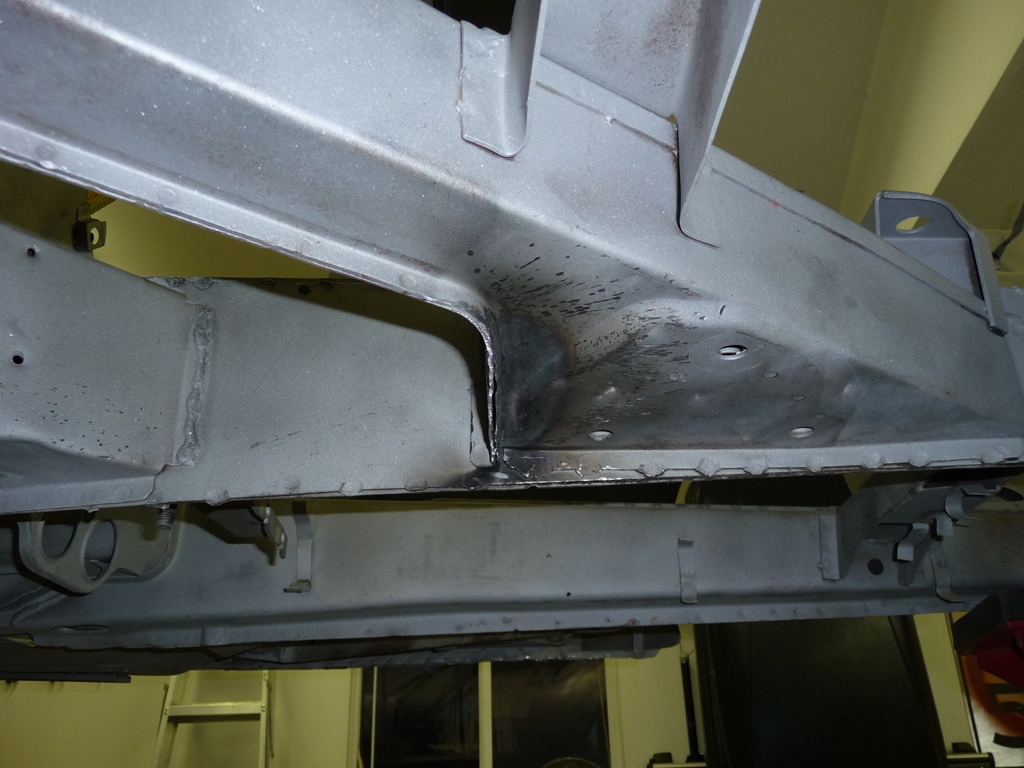
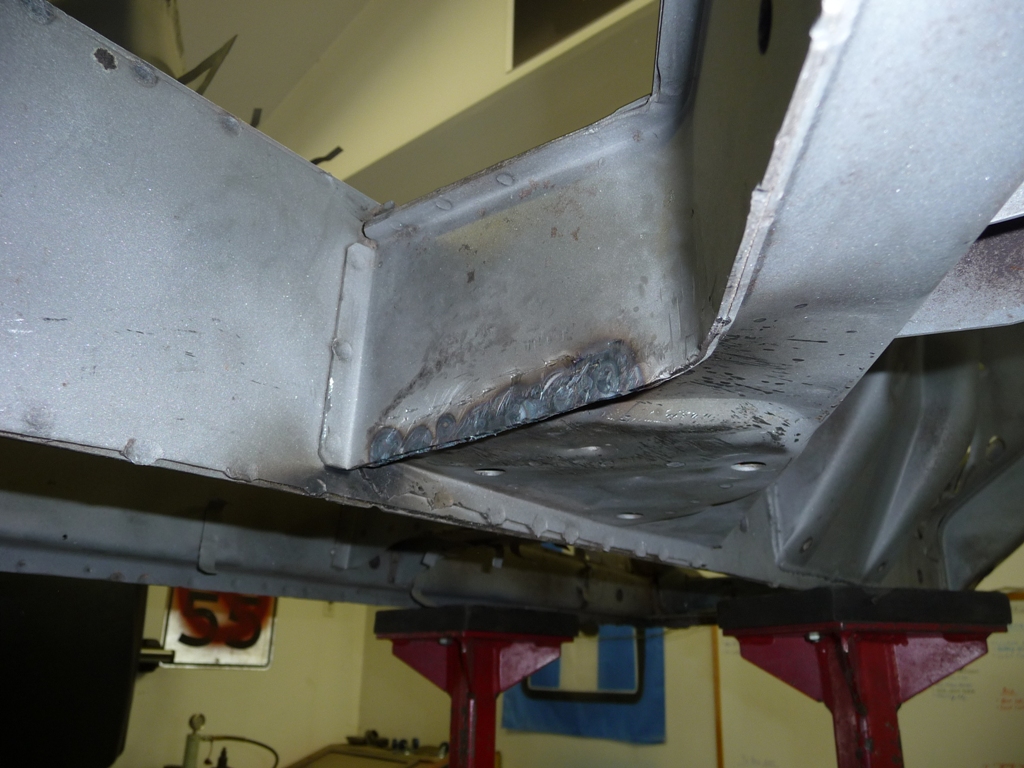
Then, I tried my first project with the new spot welder and hot glued the bottom panel on the rear cross member.
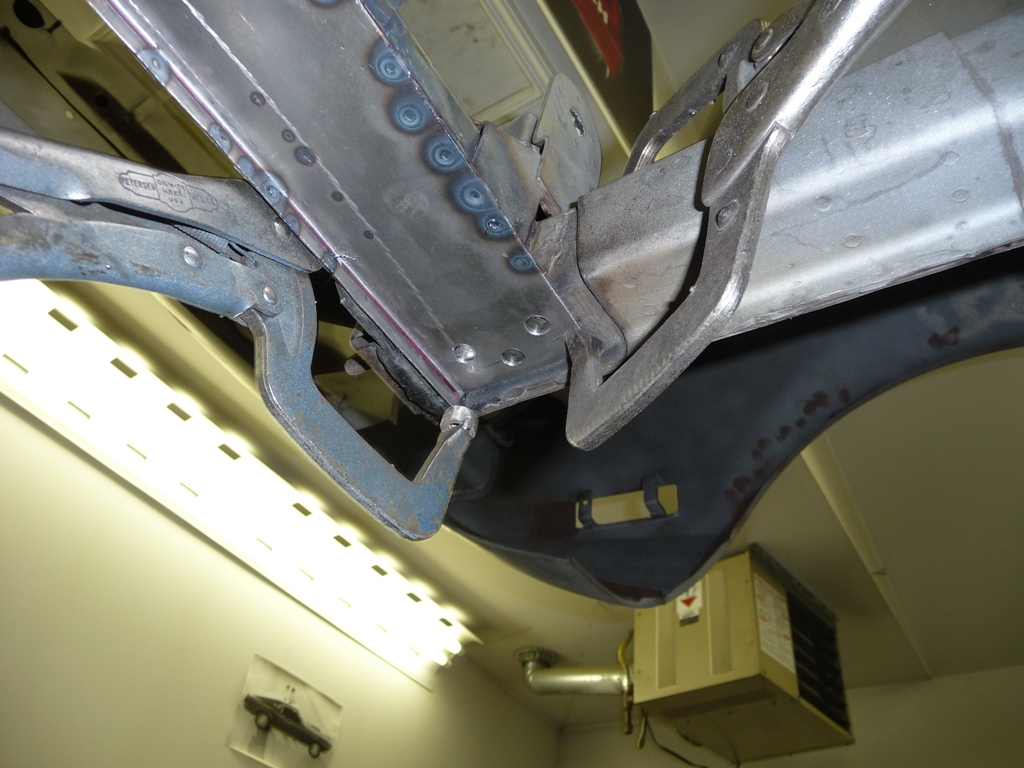
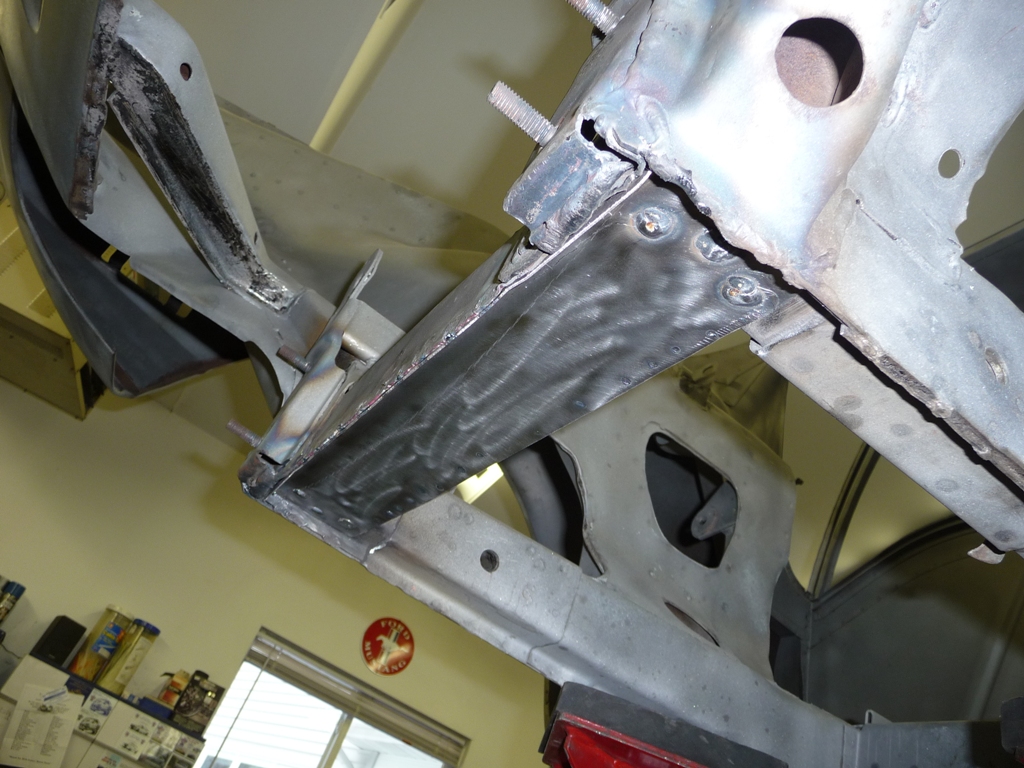
As a refresher...here was the before...
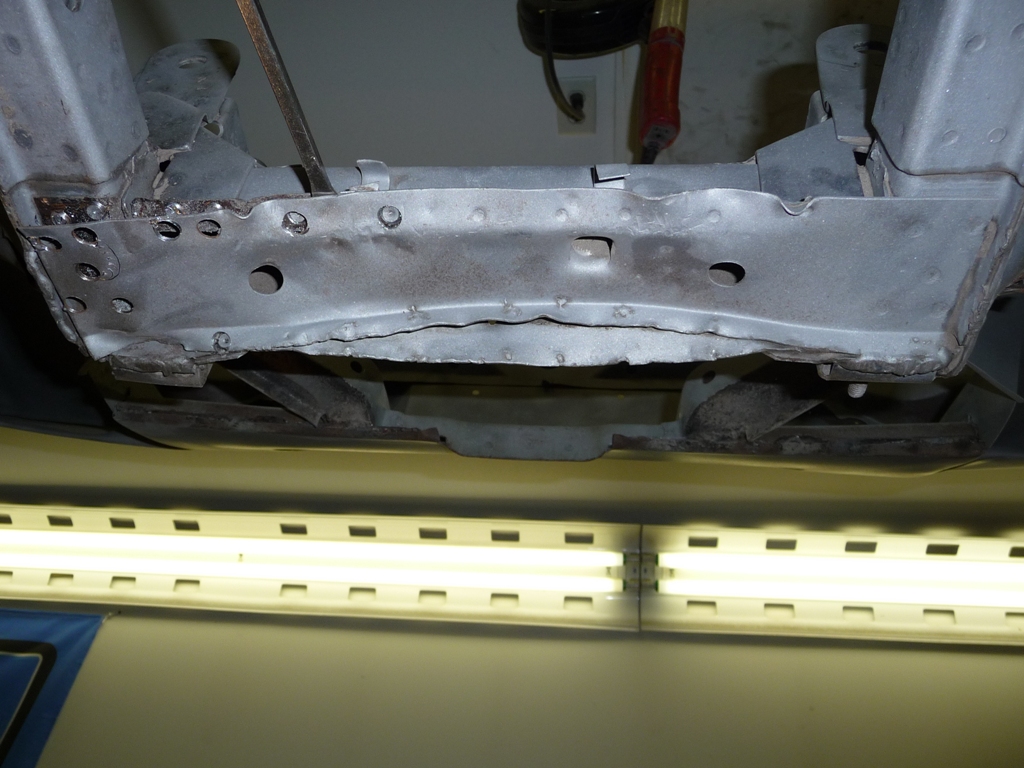
Next projects will be continuing to straighten all the "off road" damage... A few more, then I'll likely pull the front valence. Ciao for now...
Made filler patches for the holes of unknown purpose. My method in this type of situation is to make my patch an exact duplicate of the hole. Weld them and ground them clean. The wire is just a handle so I could hold them in place to shape and weld them. (both sides were the same project, so only showing the one)
Then a knocked out the E-brake reaction bracket. Cut the crappy welds off, ground it clean, welded up the holes and dents and remounted.
Then took on the frame under the driver's side engine mount. It was badly bent. Looks like a large rock was hit or something like that. I think this car spent more time in ditches...than on the road..
Then, I tried my first project with the new spot welder and hot glued the bottom panel on the rear cross member.
As a refresher...here was the before...
Next projects will be continuing to straighten all the "off road" damage... A few more, then I'll likely pull the front valence. Ciao for now...
Keep up the great work, Rob.
Lots of good stuff showing up on this board recently.
Rocky
Lots of good stuff showing up on this board recently.
Rocky
Thanks Rocky, appreciate that.
OK, so I was out of commission last weekend due to a minor eye surgery. No biggy, but had to sit on the couch all weekend. Managed to sneak in about two hours yesterday, and today the house was empty...so I got to rock a roll a little bit before the girls showed back up at about 4pm. I spent quite a bit of time finishing up repairs on the torn/damaged frame holes...
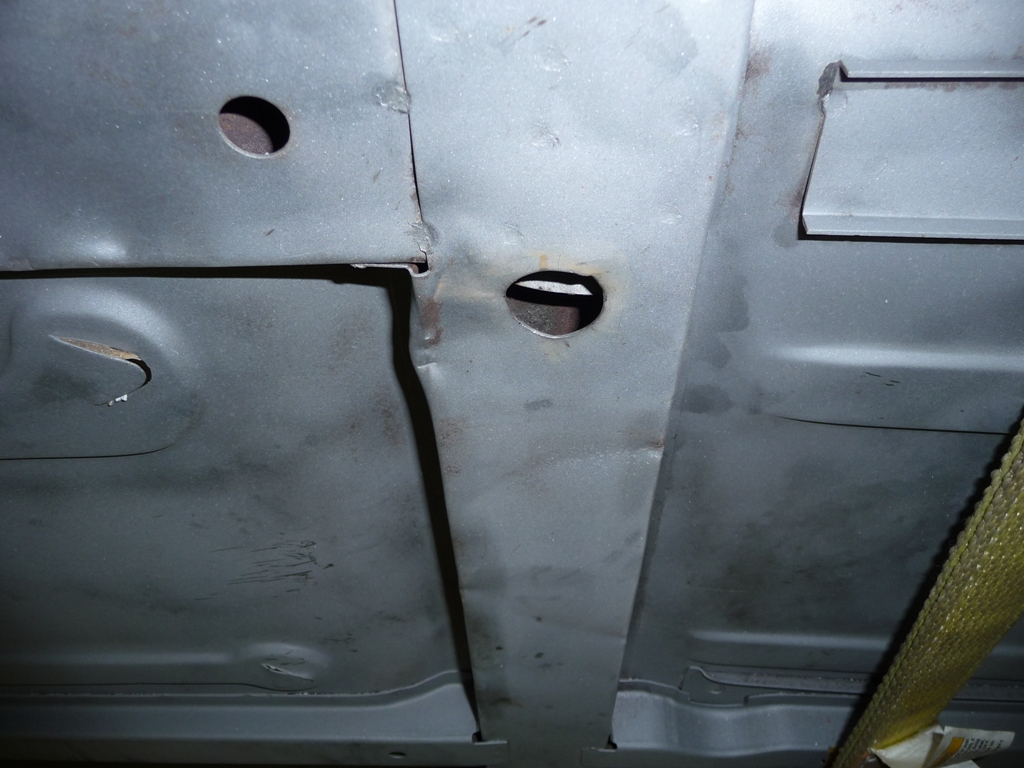
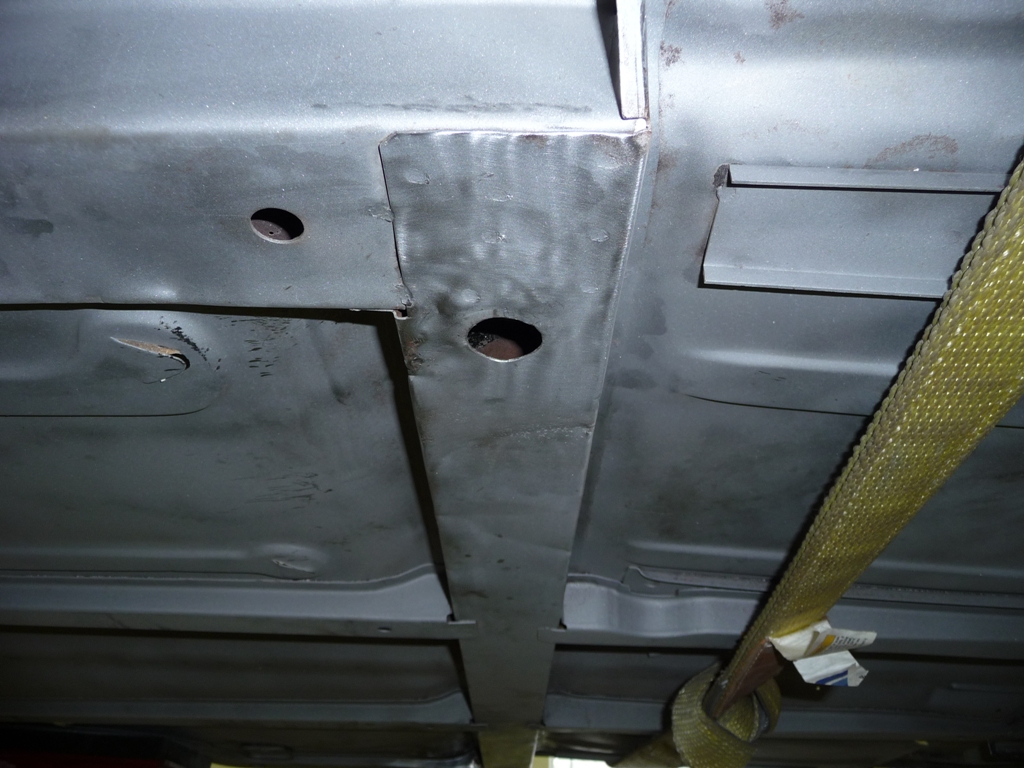
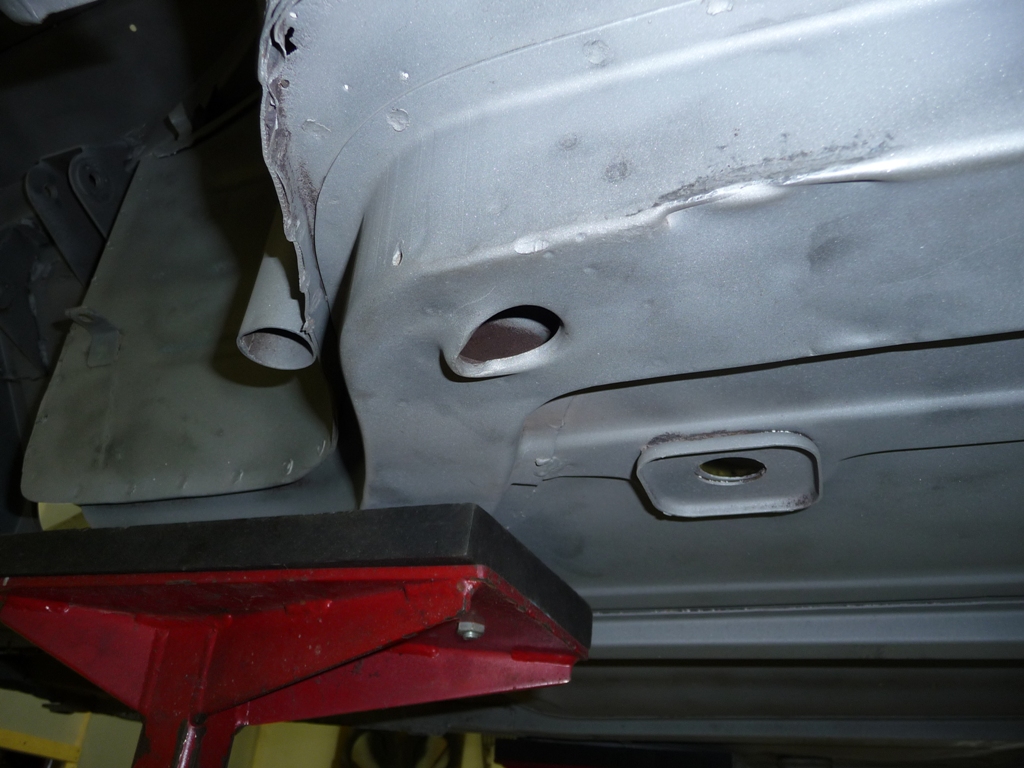
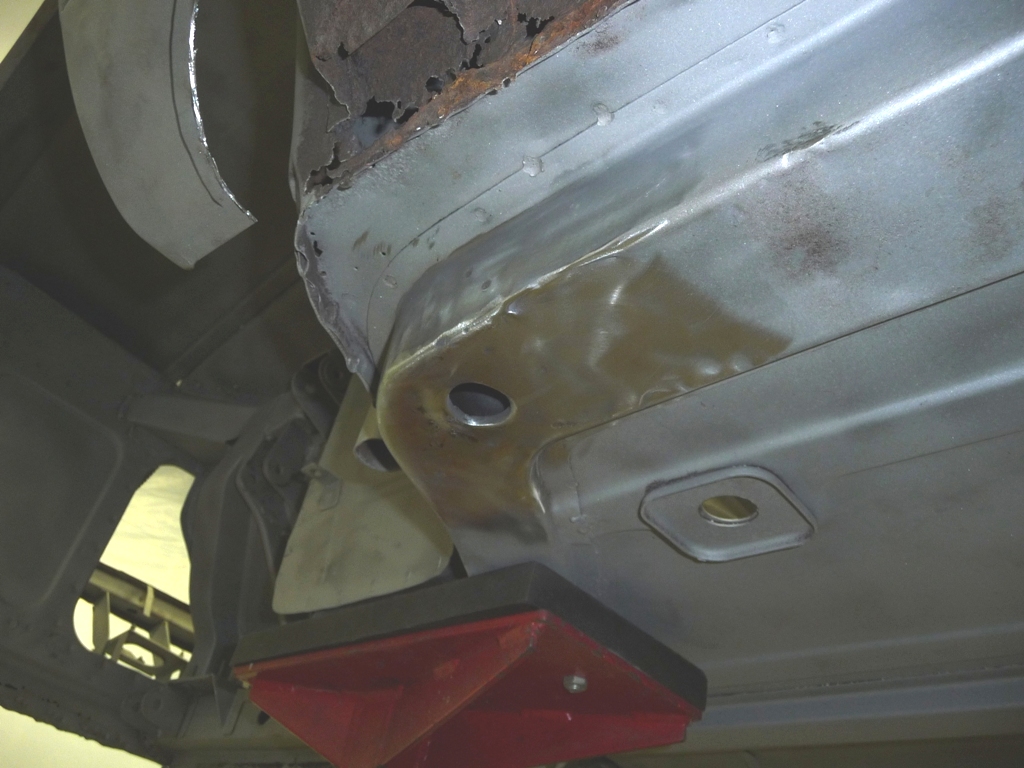
Both front frame holes looked like this...
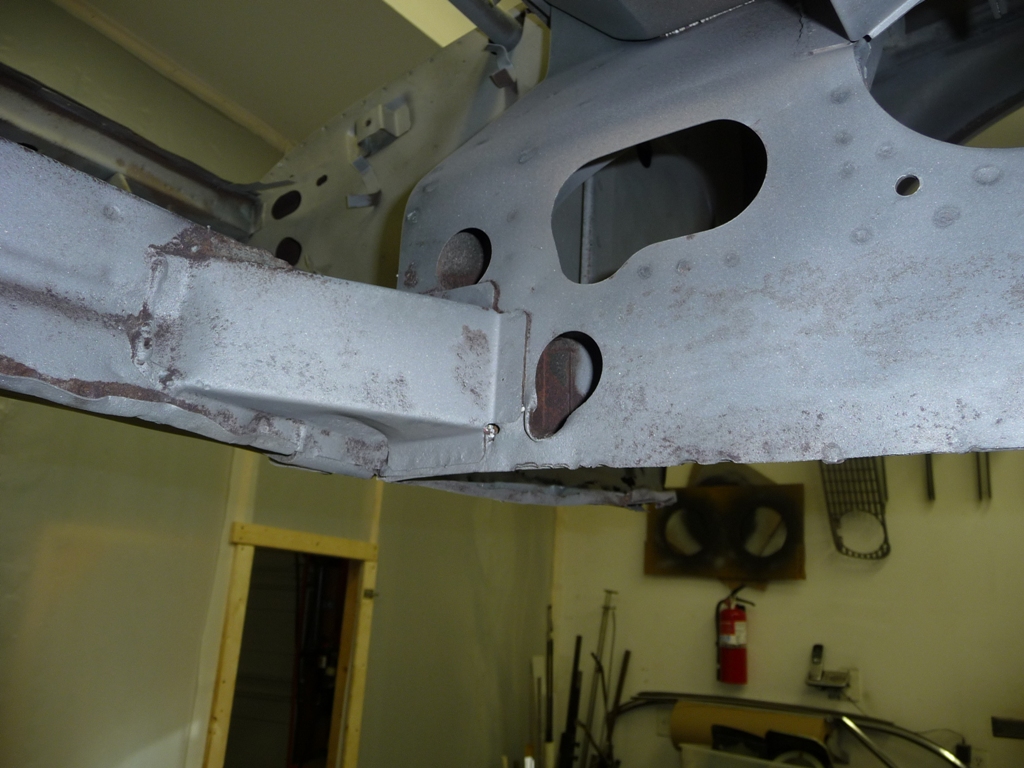
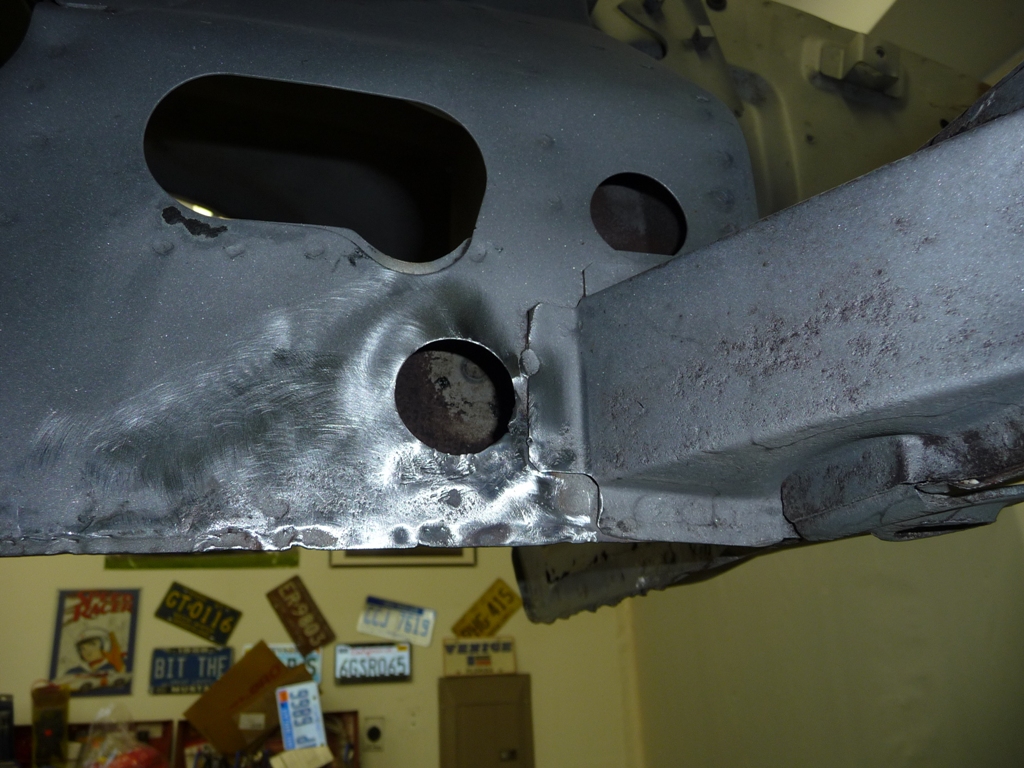
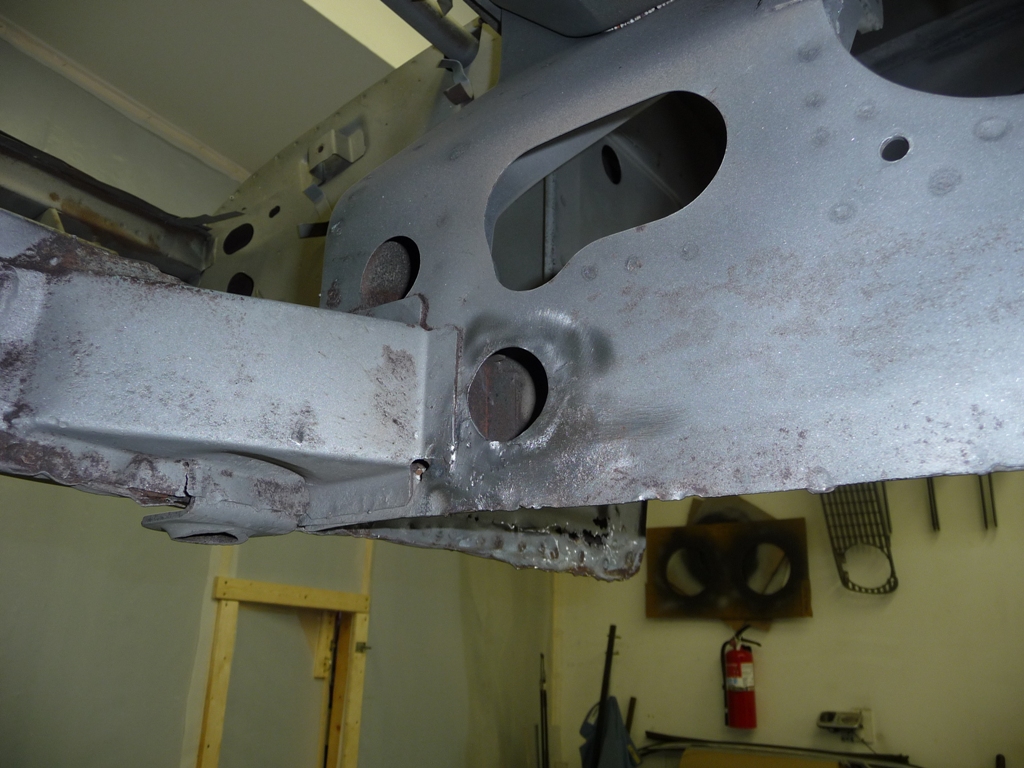
These repairs concluded the underbody work, so I lowered the car down on the stands to get started on the rocker repairs.
After contemplating it for a while...I made the tough decision to cut off more 1/4 panel in order to get to the spot welds.
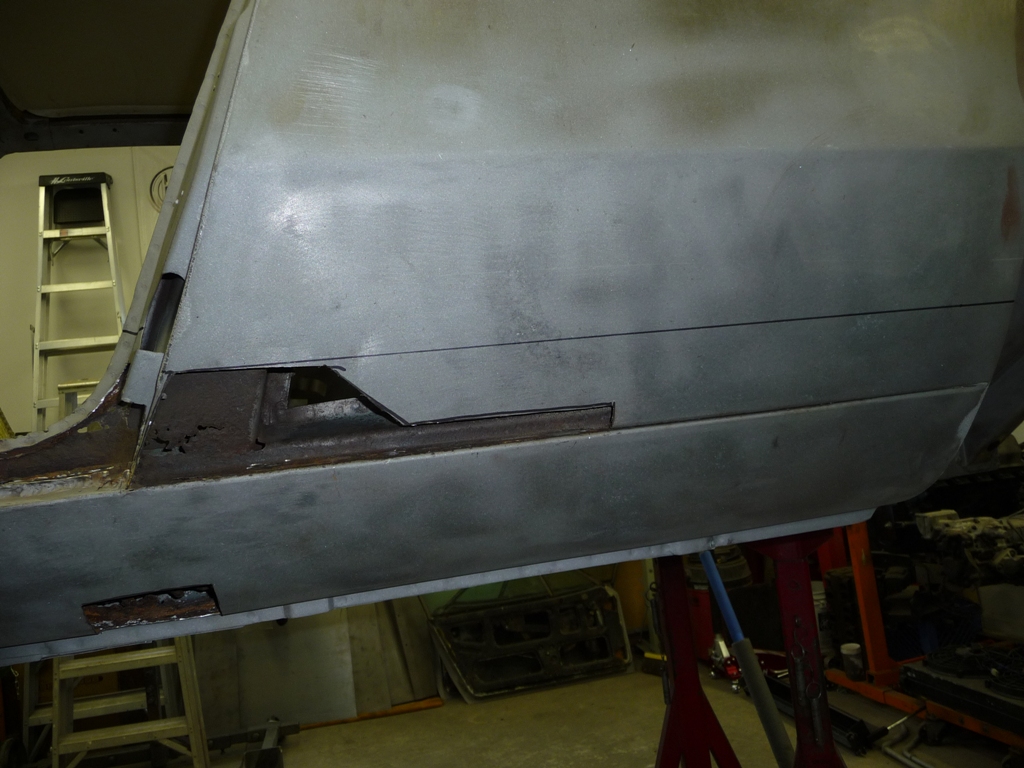
Oh crap....no turning back now.....
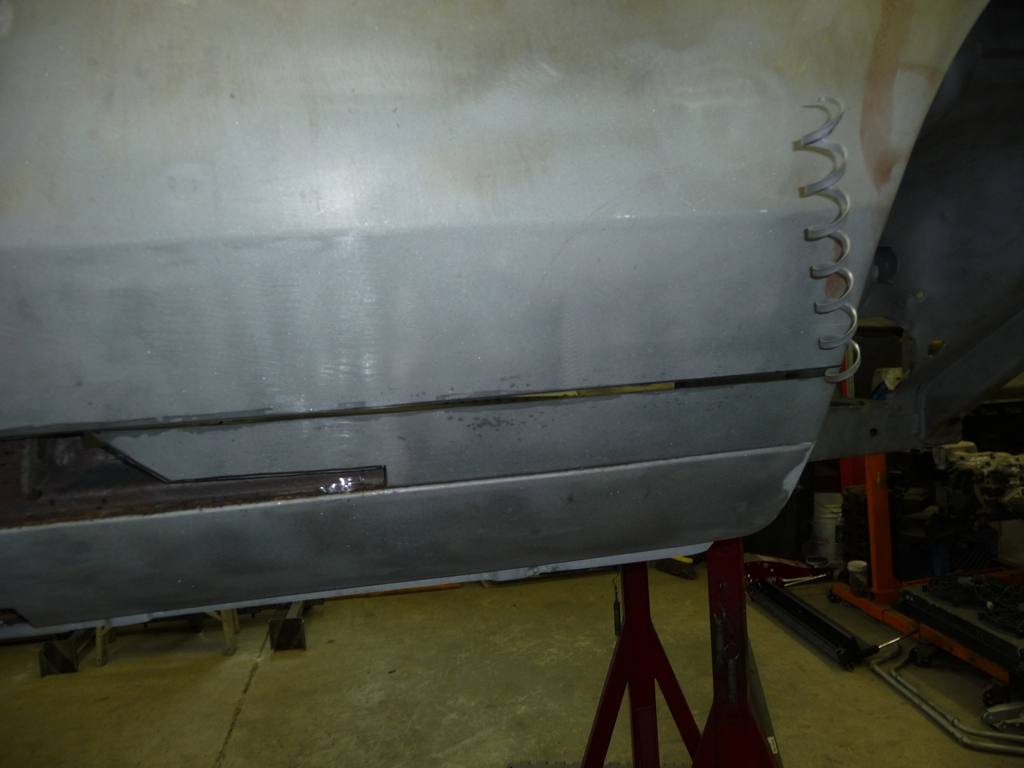
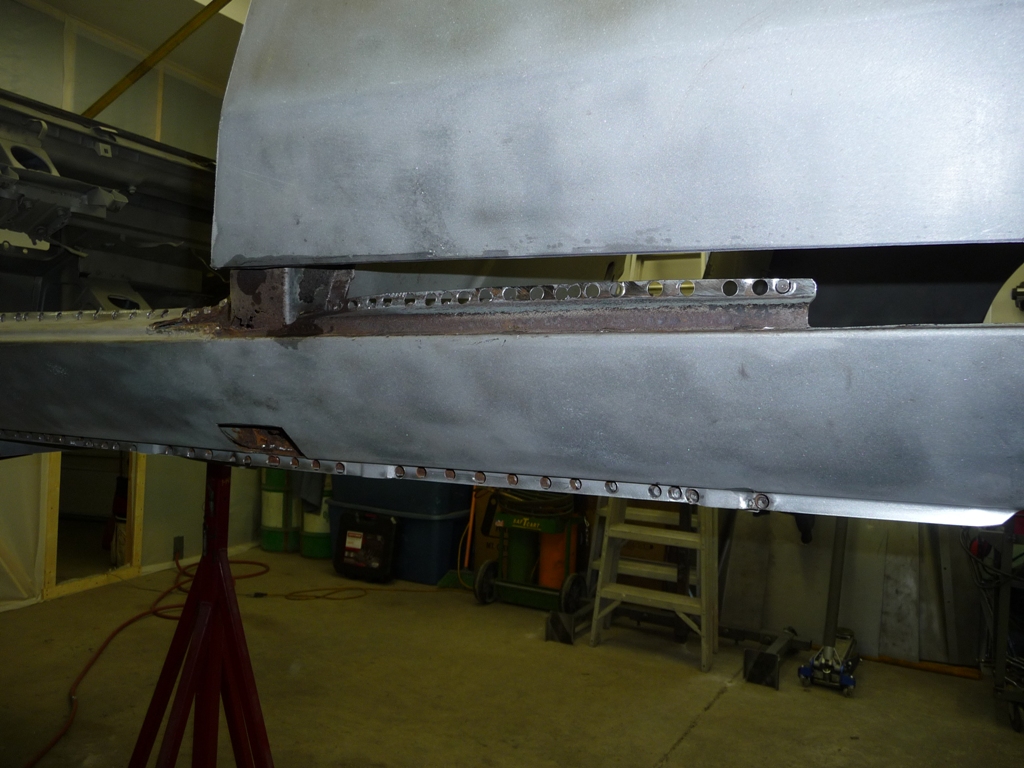
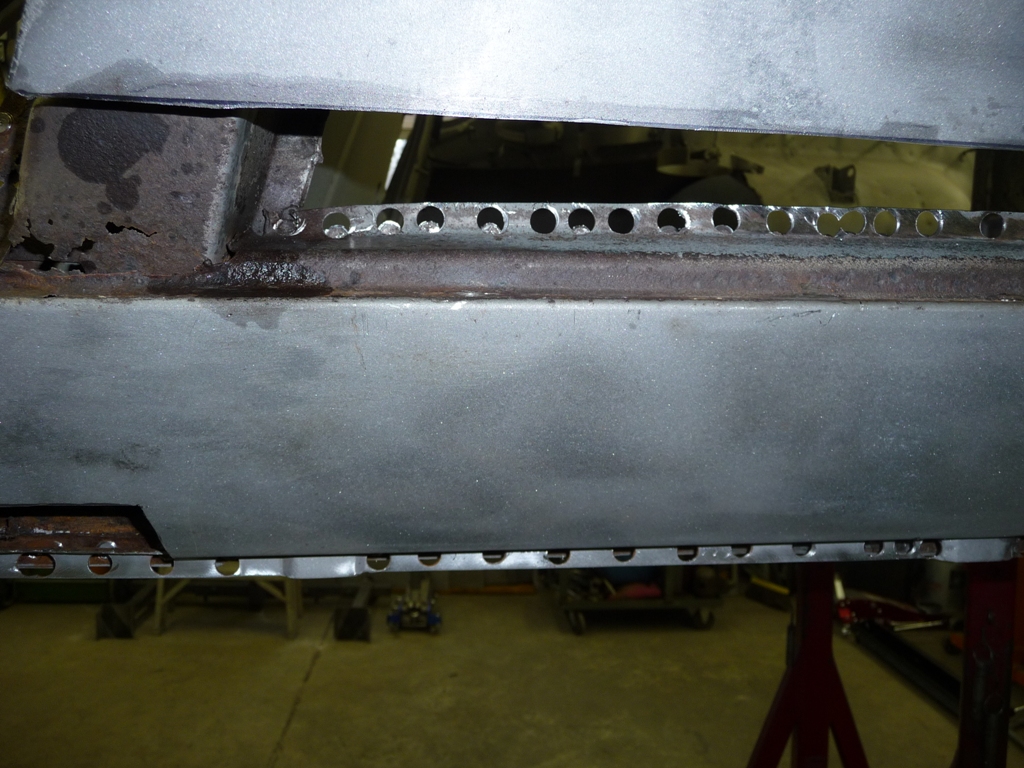
With all the welds cut or ground off, the rocker was removed to expose the ugliness in full light.
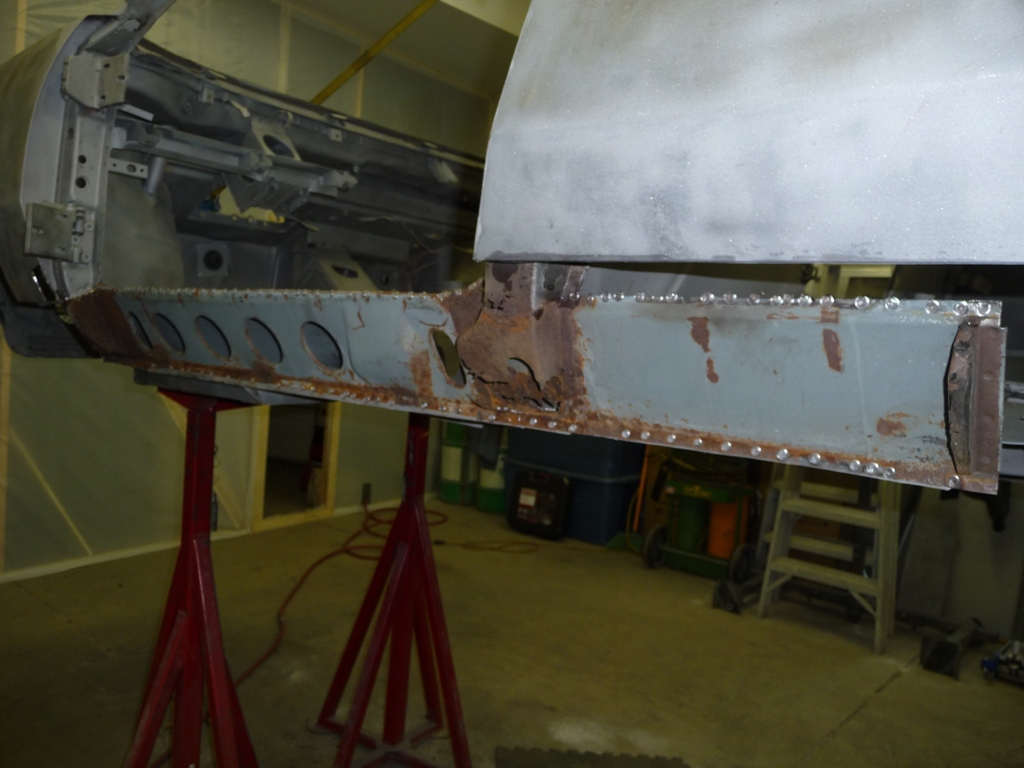
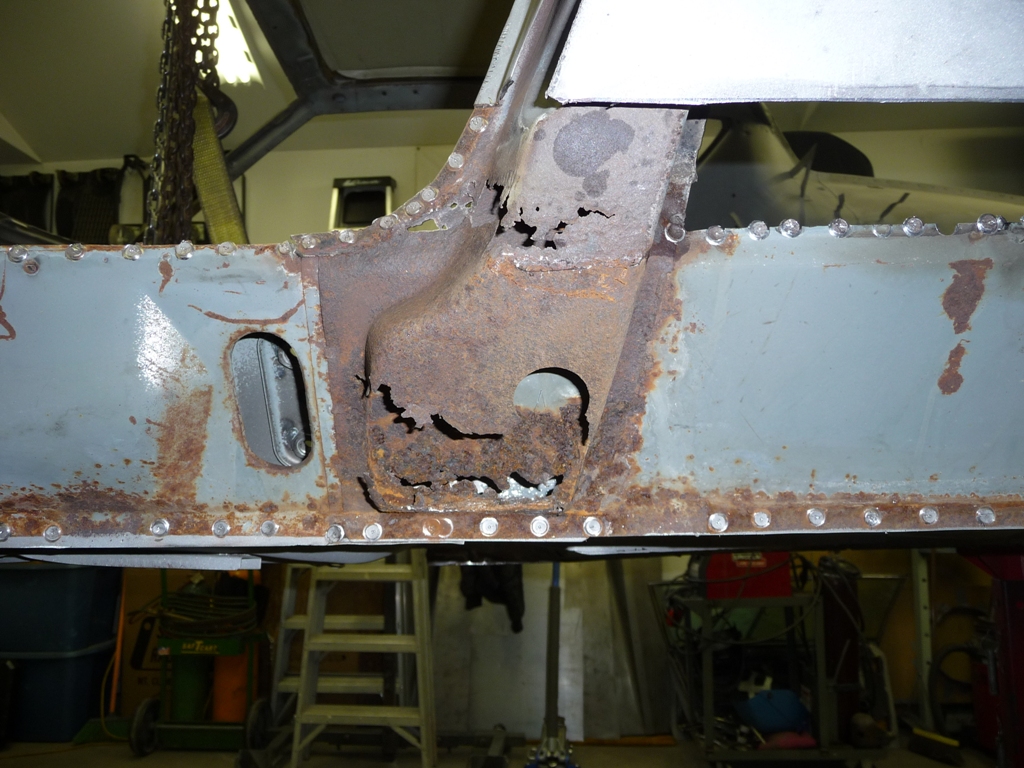
Here is what's left of the bottom of the "B" pillar....
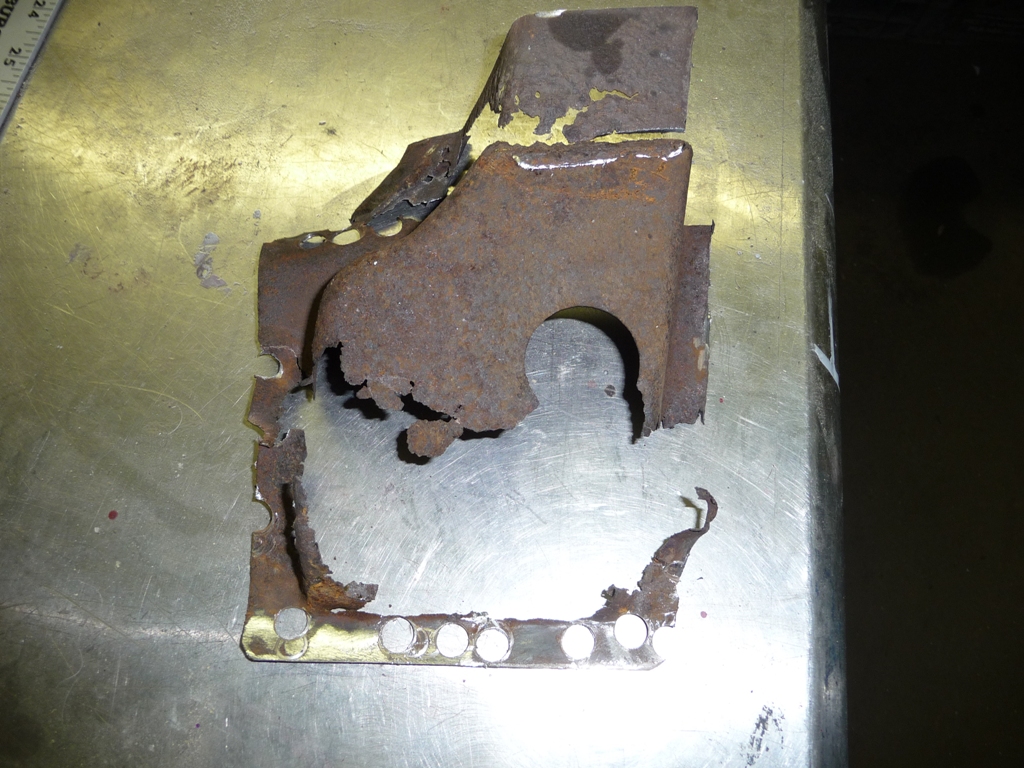
The inner rocker isn't all too bad. The section under the nastiness had to be removed though.
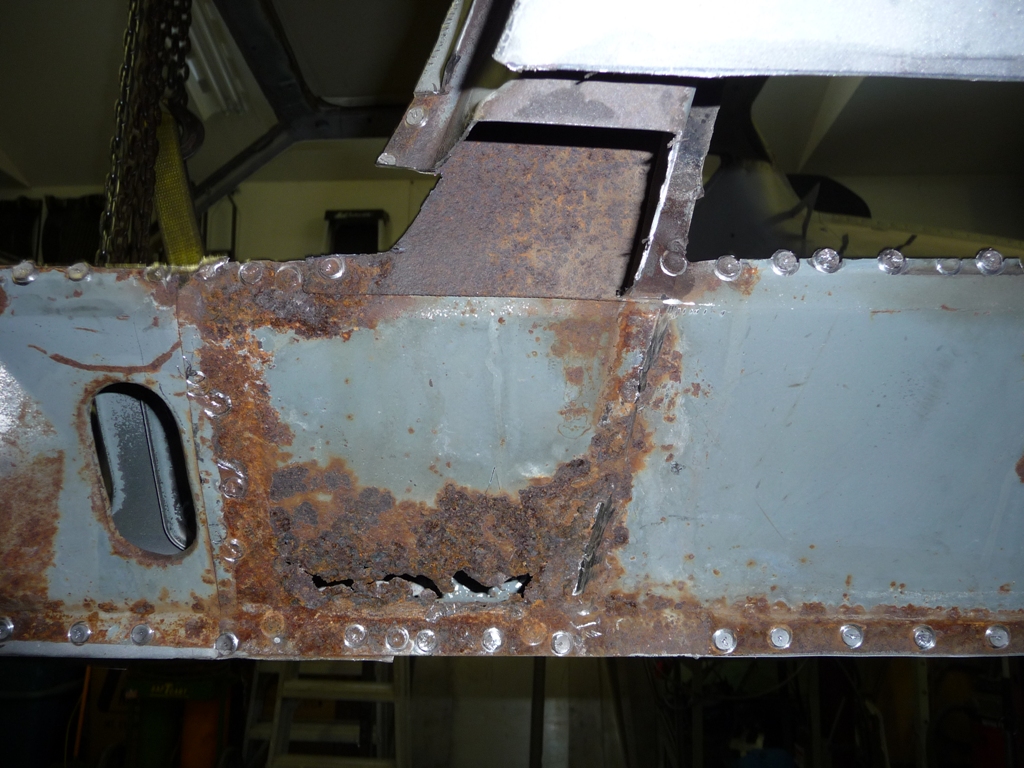
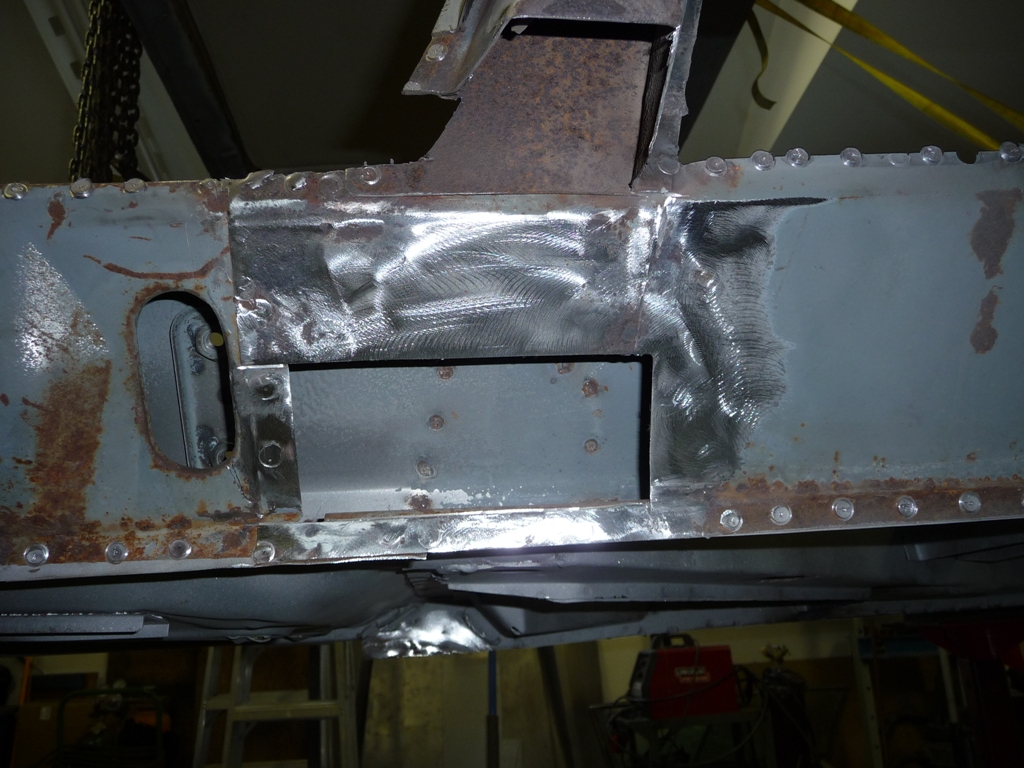
Then did basically the same procedure on bottom of the "A" pillar.
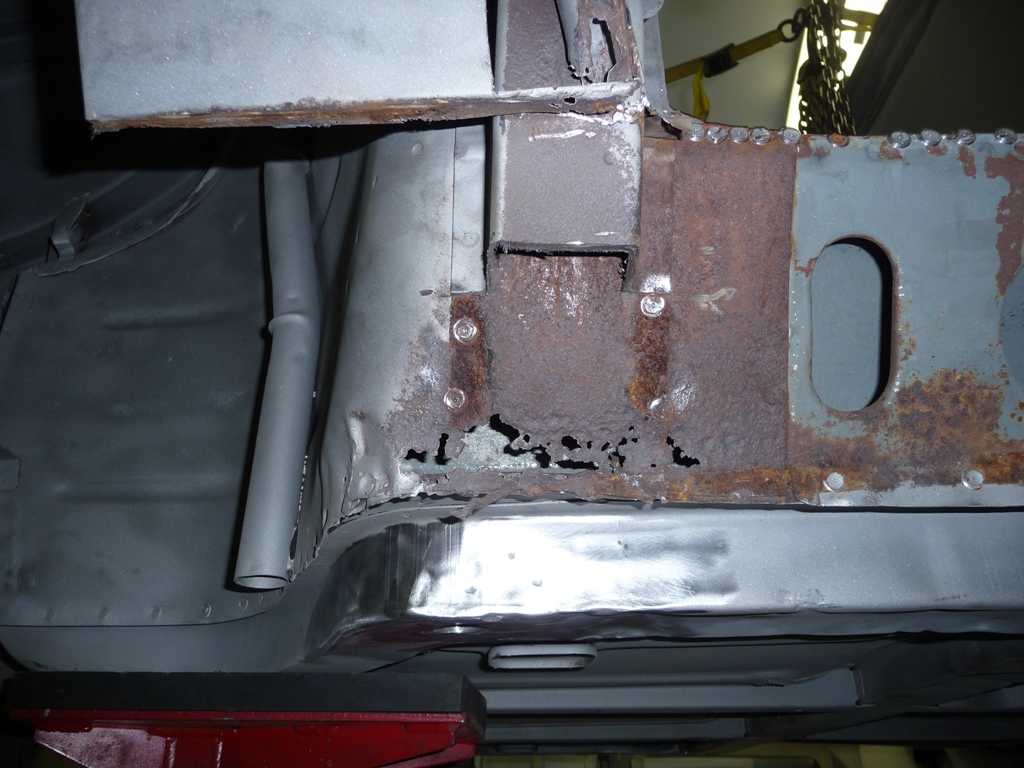
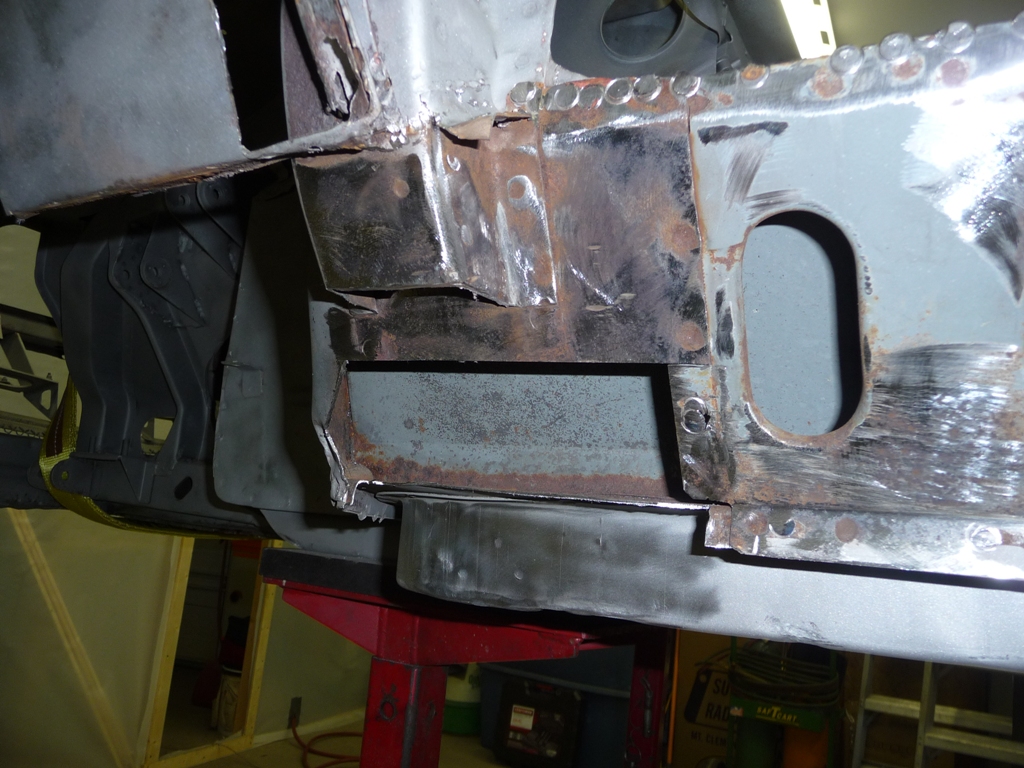
So...here's the total damage at the end of the day.
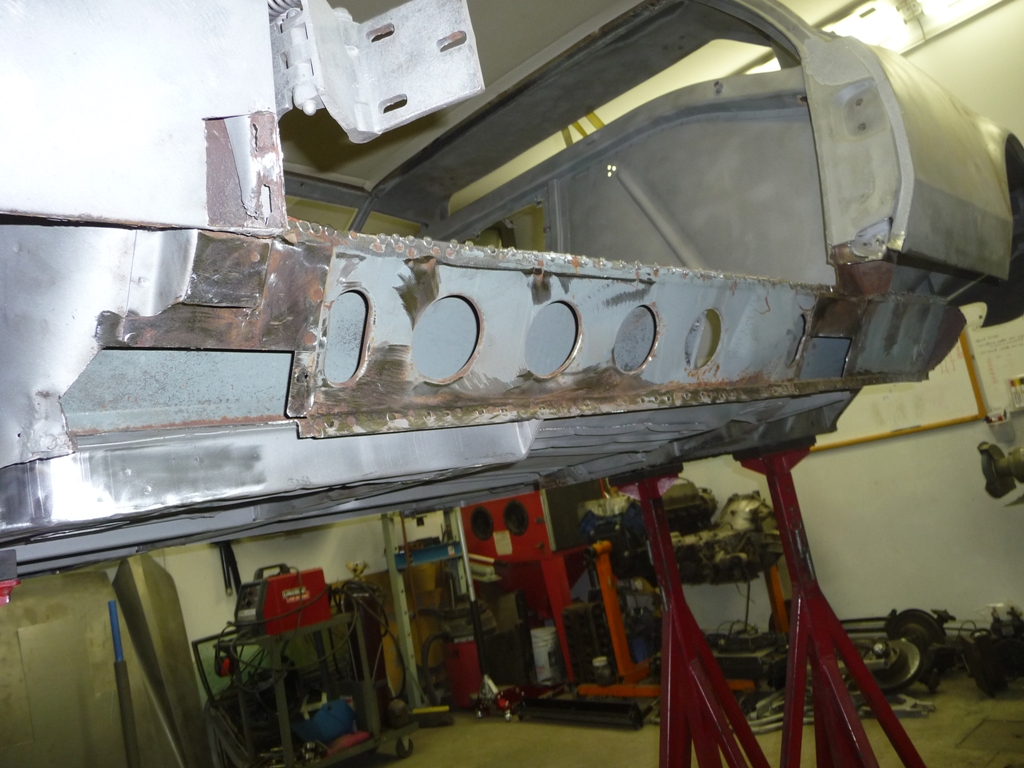
Unfortunately I will need to break out the sand blaster next weekend to clean up all the rust before I can proceed. Then, it's time to start fabricating some panels.
OK, so I was out of commission last weekend due to a minor eye surgery. No biggy, but had to sit on the couch all weekend. Managed to sneak in about two hours yesterday, and today the house was empty...so I got to rock a roll a little bit before the girls showed back up at about 4pm. I spent quite a bit of time finishing up repairs on the torn/damaged frame holes...
Both front frame holes looked like this...
These repairs concluded the underbody work, so I lowered the car down on the stands to get started on the rocker repairs.
After contemplating it for a while...I made the tough decision to cut off more 1/4 panel in order to get to the spot welds.
Oh crap....no turning back now.....
With all the welds cut or ground off, the rocker was removed to expose the ugliness in full light.
Here is what's left of the bottom of the "B" pillar....
The inner rocker isn't all too bad. The section under the nastiness had to be removed though.
Then did basically the same procedure on bottom of the "A" pillar.
So...here's the total damage at the end of the day.
Unfortunately I will need to break out the sand blaster next weekend to clean up all the rust before I can proceed. Then, it's time to start fabricating some panels.
Real impressive work, Rob. I love your confidence on the disassembly. I thought your underbody frame rails look better than many I have seen. Thanks for taking the extra time to document your process.
Thanks JT... but a monkey can take things apart....let's see how well I do going back together... 
Nice work and very timely. I am doing almost the exact same work on my car right now, and seeing much of the same damage.
Looking at the first 4 pics of your last post - how did you get the jacking dents & crushing out of those underbody stiffeners? Mine has this damage too, and I have to decide should I straighten them out or cut off the damaged sections and make new. Rodney
Looking at the first 4 pics of your last post - how did you get the jacking dents & crushing out of those underbody stiffeners? Mine has this damage too, and I have to decide should I straighten them out or cut off the damaged sections and make new. Rodney
Thanks Rodney. Great..glad I could be your ginny pig..uh.. I mean help out. 
Regarding the frame rail damage, I use a combination of slide hammer with a variety of different head attachments, hand hammering to keep areas of distortion in check, and some heat applied in specific areas to assist with making a specific area more ductile during shaping. i.e. if I'm slide hammering here and it's distorting over there (in a way I can't control different with hand hammer)then I'll warm up the area here a little where I want to movement, and hopefully to overall distortion is reduced.
I did the same assessment as you. Ultimately, I decided to try and straighten...worst case...I'd then cut it out and rebuilt it if I failed.
Hopefully I've adequately answered your question.... Rob
Regarding the frame rail damage, I use a combination of slide hammer with a variety of different head attachments, hand hammering to keep areas of distortion in check, and some heat applied in specific areas to assist with making a specific area more ductile during shaping. i.e. if I'm slide hammering here and it's distorting over there (in a way I can't control different with hand hammer)then I'll warm up the area here a little where I want to movement, and hopefully to overall distortion is reduced.
I did the same assessment as you. Ultimately, I decided to try and straighten...worst case...I'd then cut it out and rebuilt it if I failed.
Hopefully I've adequately answered your question.... Rob
Thanks. That is helpful. I hadn't used heat yet so I will try that. I also drilled a hole opposite the damage and used an air hammer with a blunt tool, which worked Ok. In some places that is not possible. I'm a novice when it comes to body / sheet metal work, so I learn as I go. Just trying to learn in the less visible spots. 
UFO, keep in mind if heat is used the metal oxidizes very easily after and must be coated. The air hammer works, but I find it a bit uncontrollable, so usually do it by hand. Takes longer, but I personally get a smoother result with less stretched metal.
So... I managed a couple hrs this past Saturday and had an empty house for about 5 hrs on Sunday. Being the procrastinator that I am...I tackled the easy one first.
Cardboard template
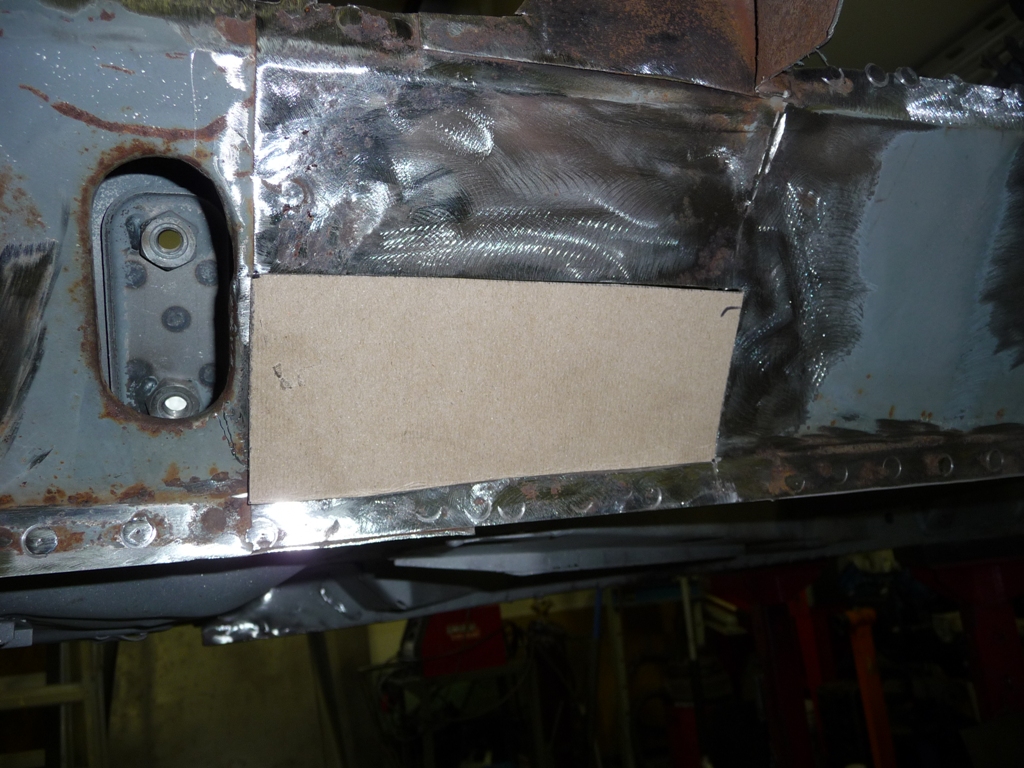
Final fitment of patch
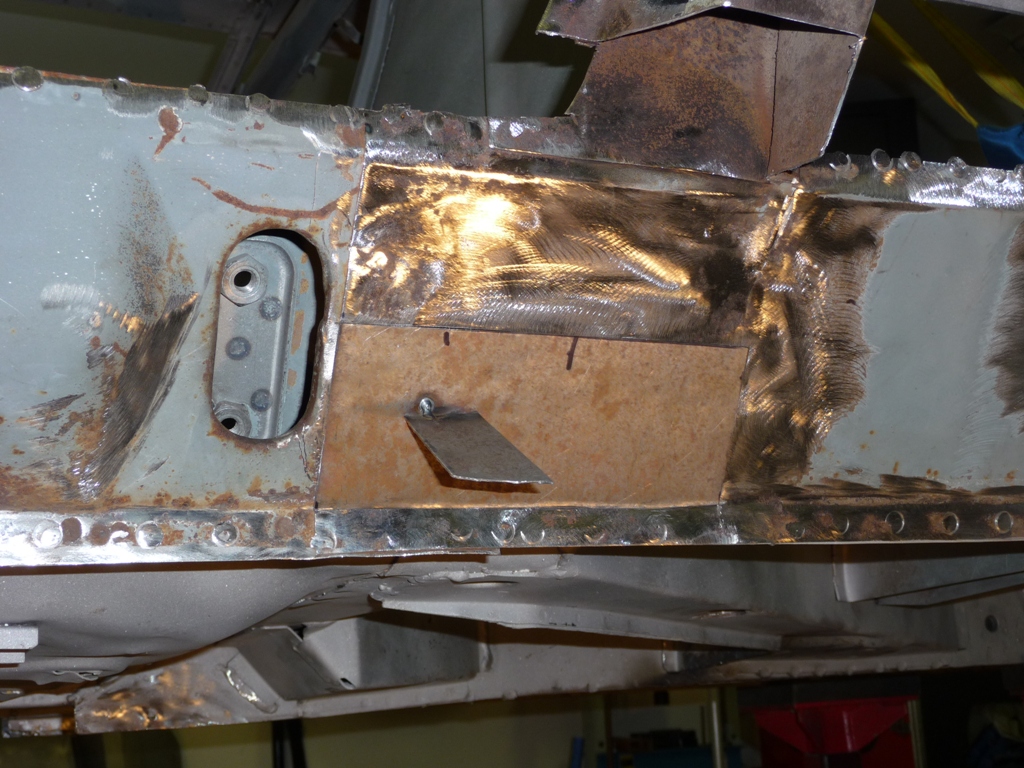
Tack welded, then I work around from each tack weld and add one more with each pass. I do this to try and avoid getting too much heat in the panel.
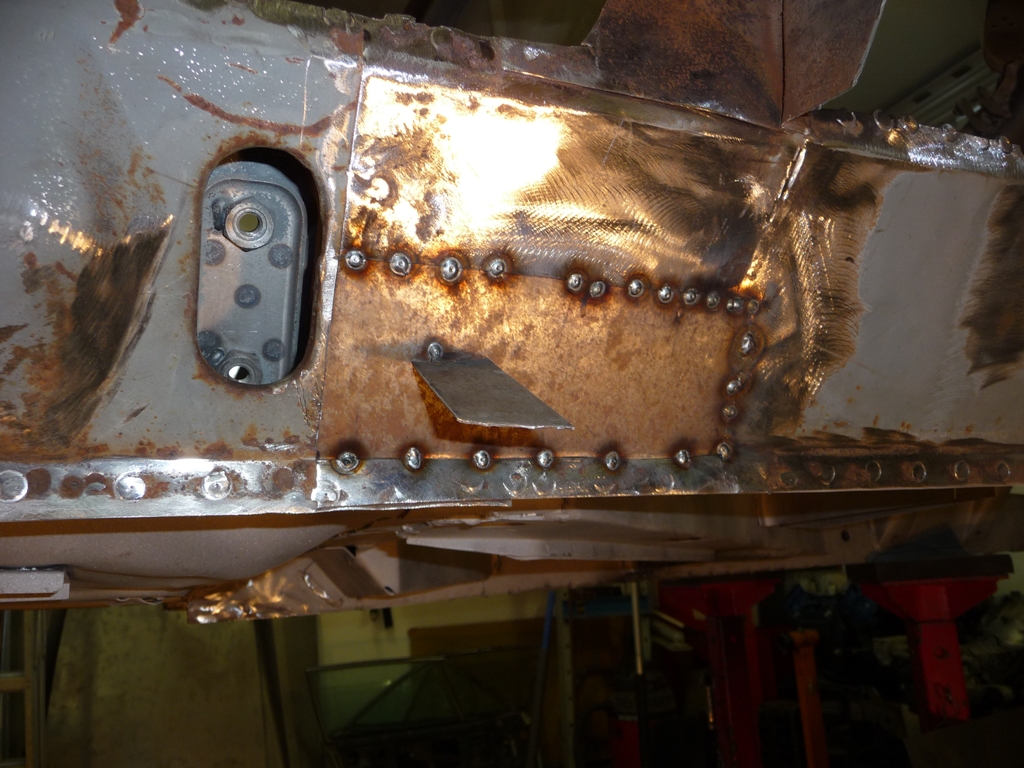
With all the gaps between the initial tack welds filled, I grind it clean.
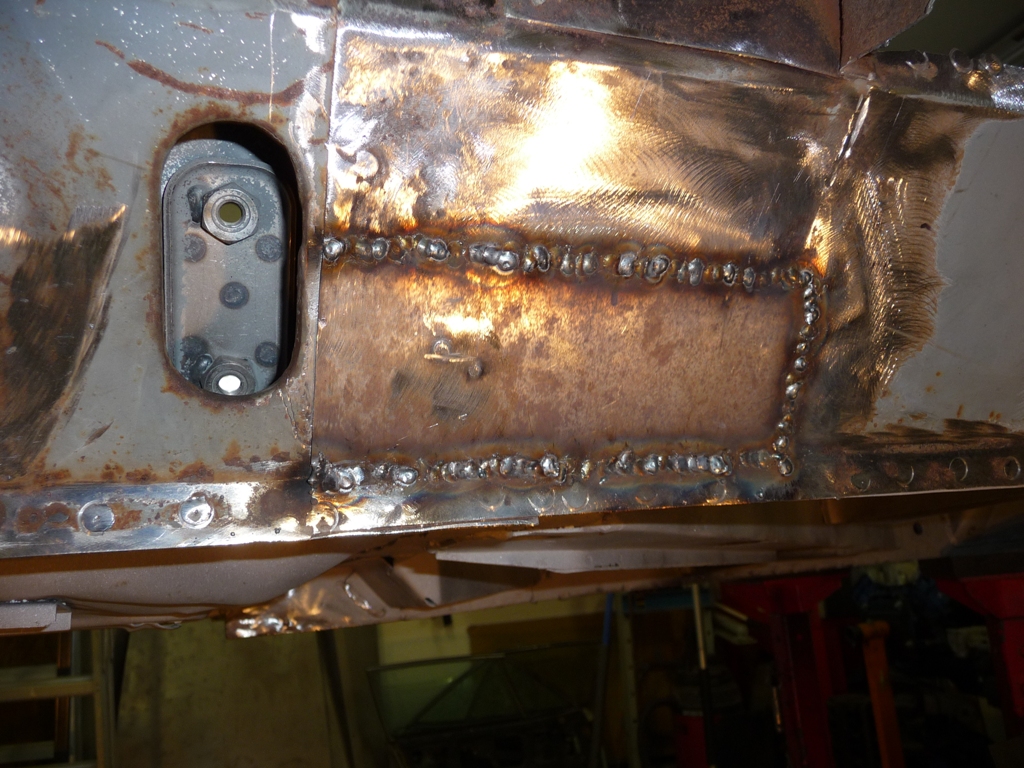
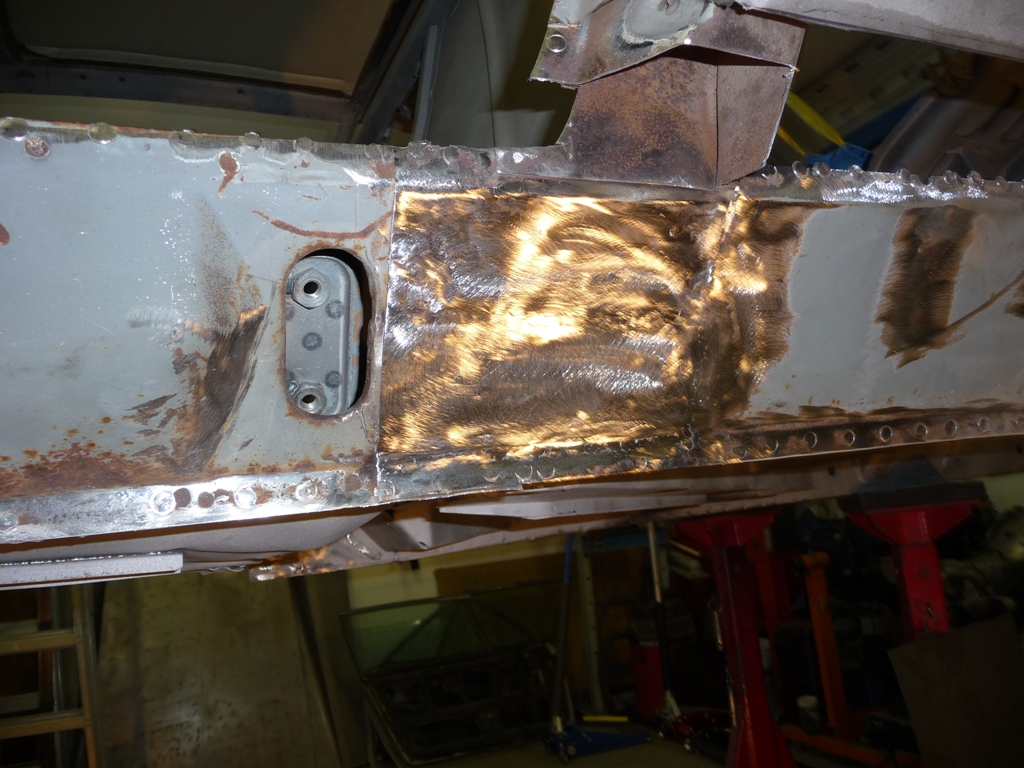
Here is what it looks like from the inside of the rocker
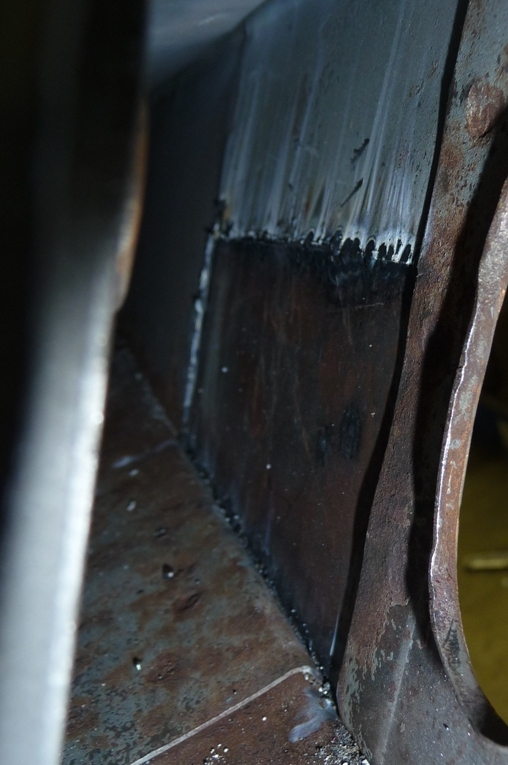
Then the front piece....
same process...
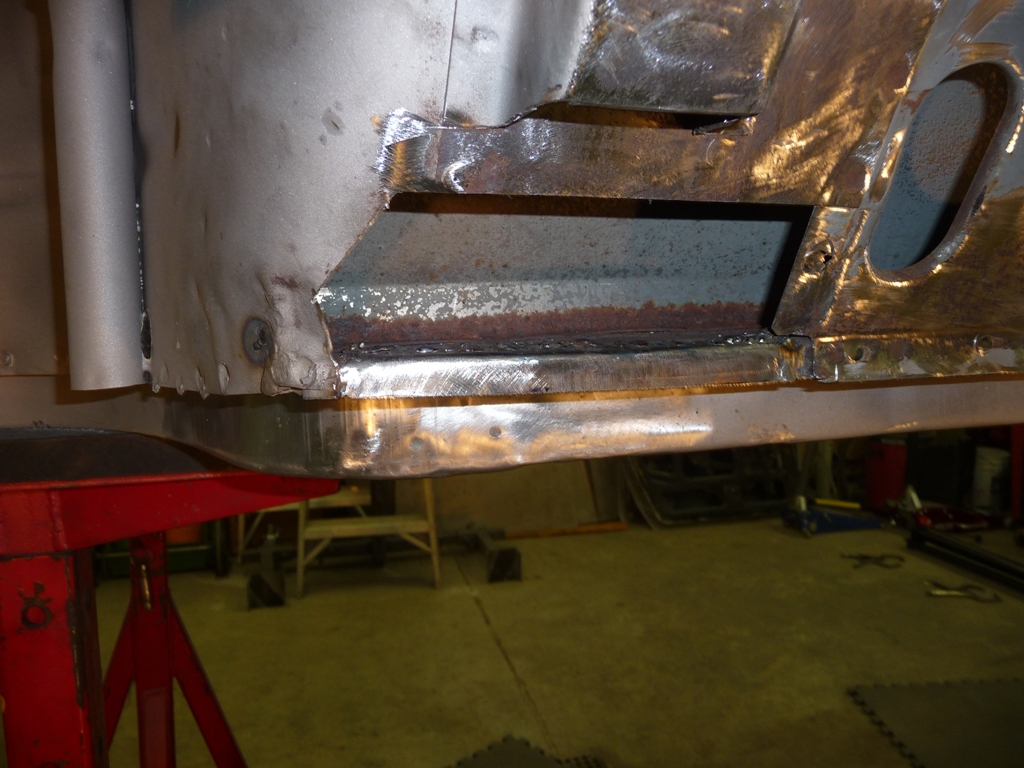
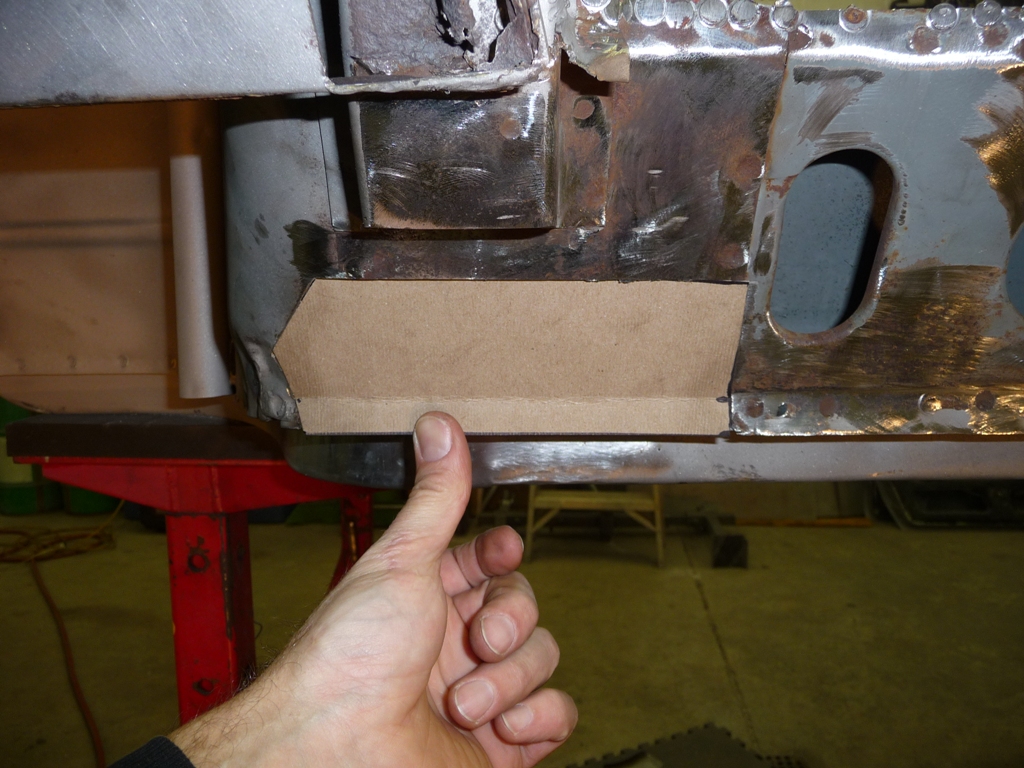
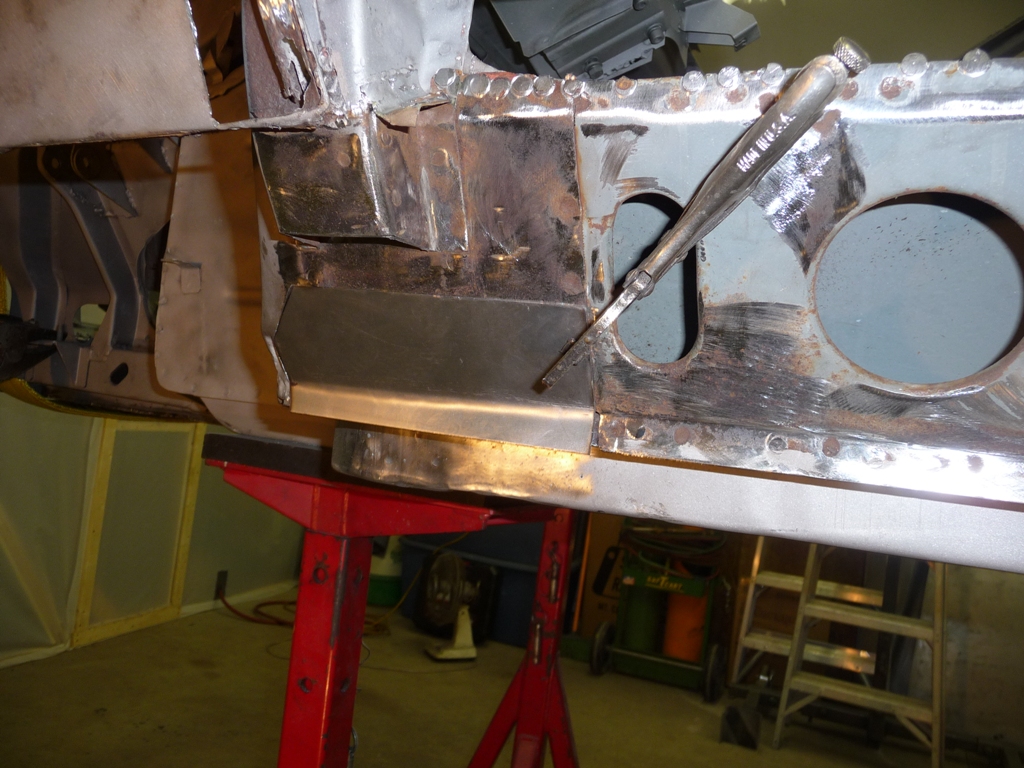
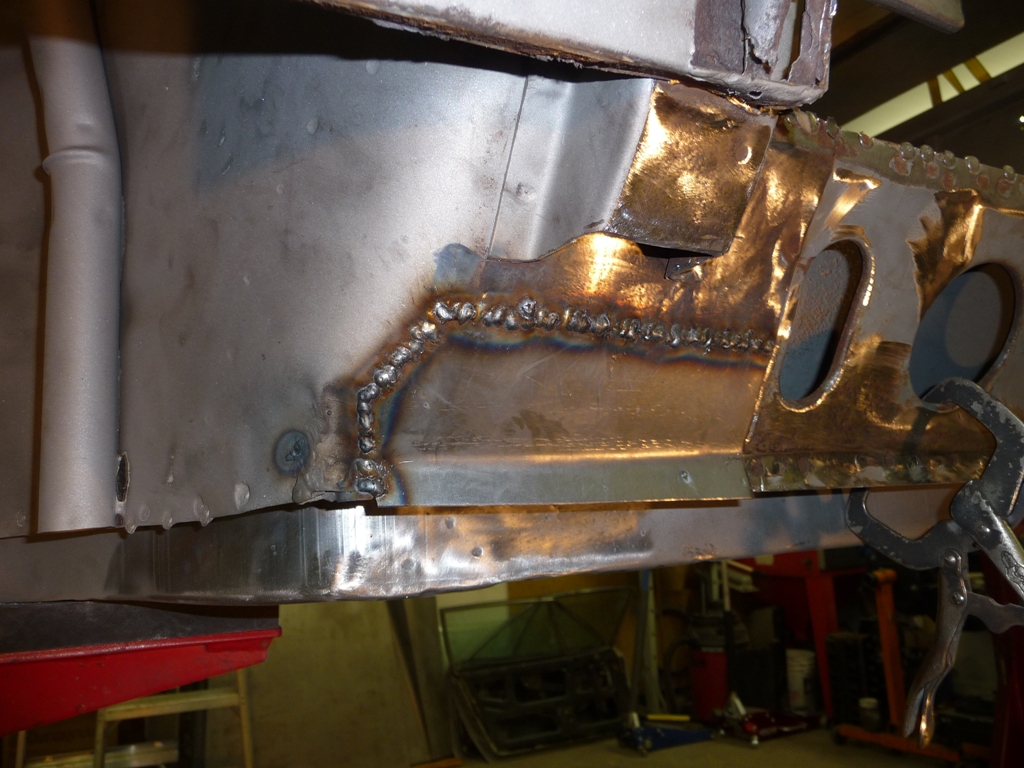
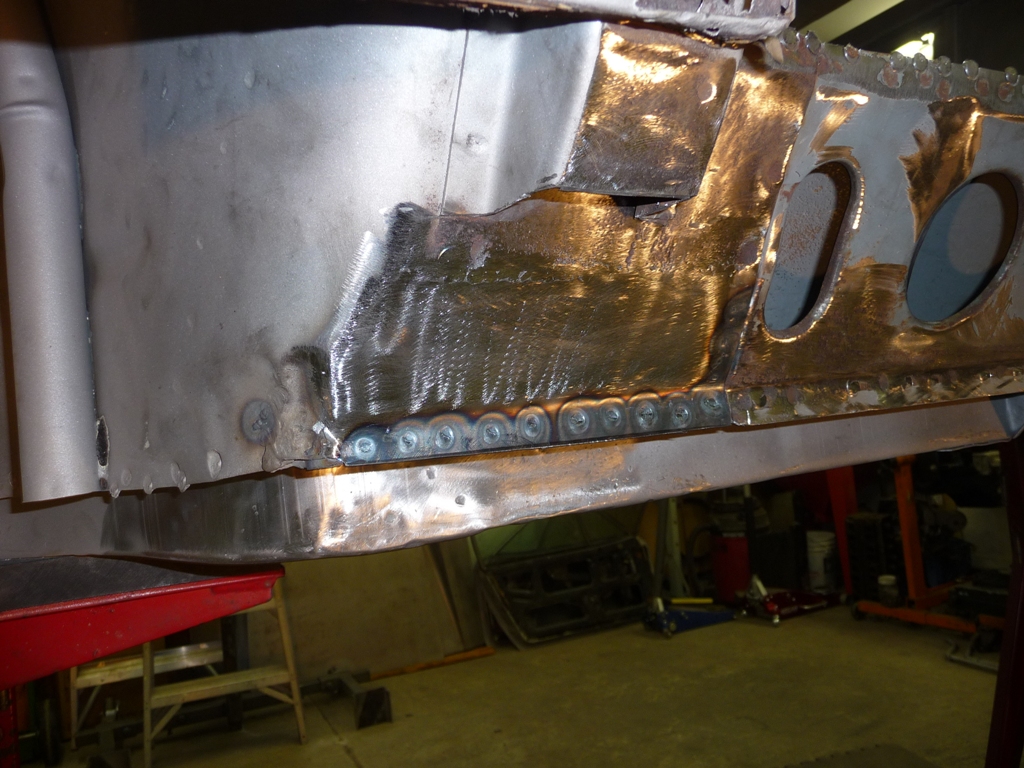
Then...the hard one...
I decided the best approach would be to make a form, so I screwed a couple of 4x4s together and hogged out a form to hammer the metal into to try and get a near net piece to work with. It took the better part of Sunday...with OK/acceptable result for a sub structure.
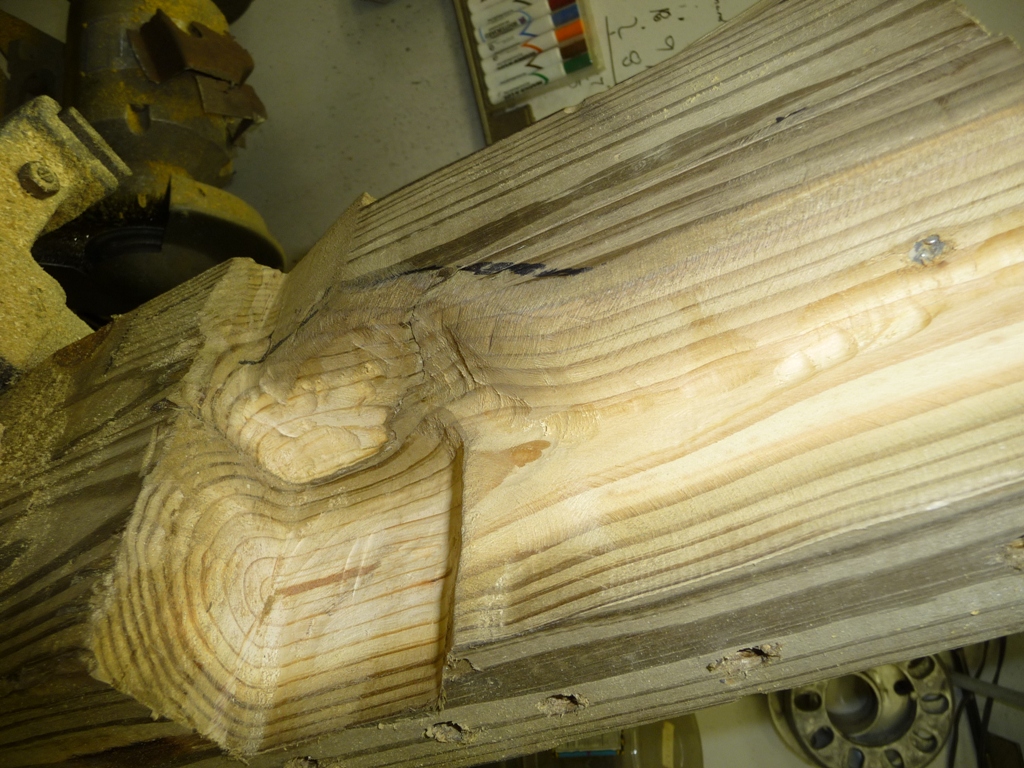
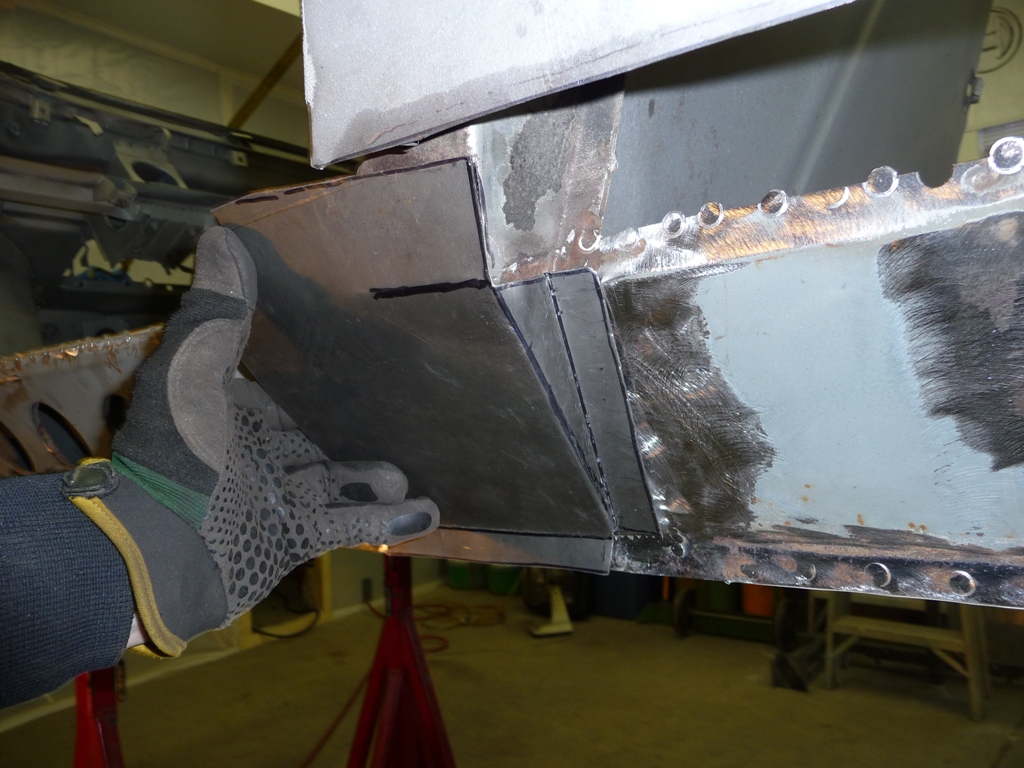
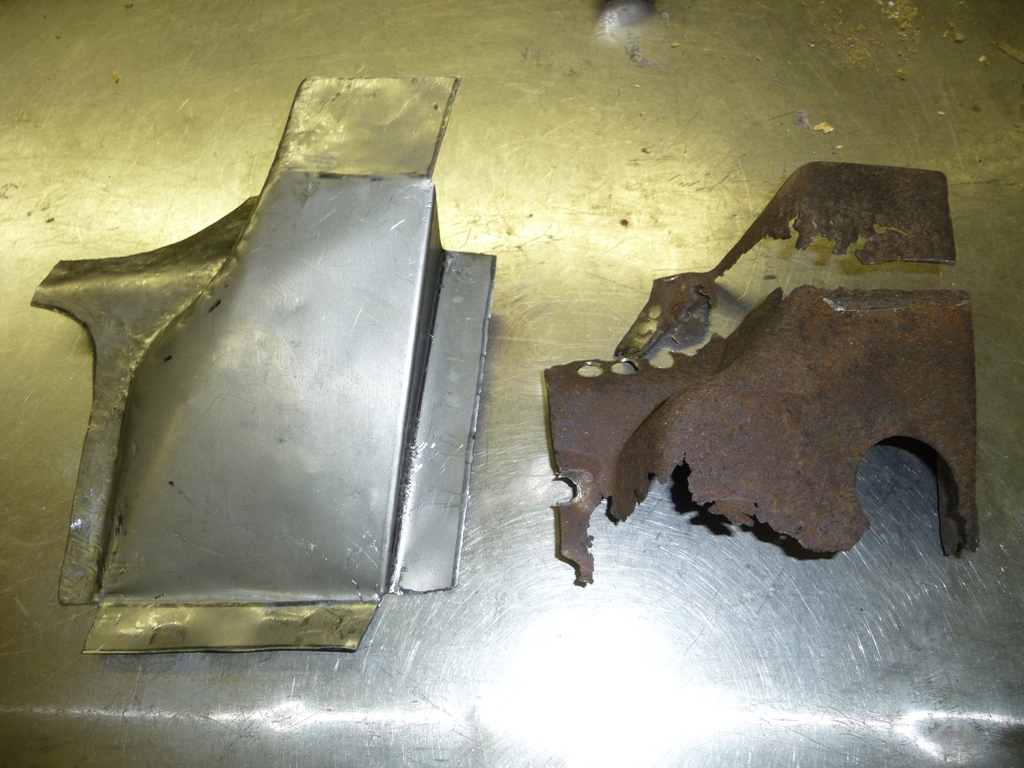
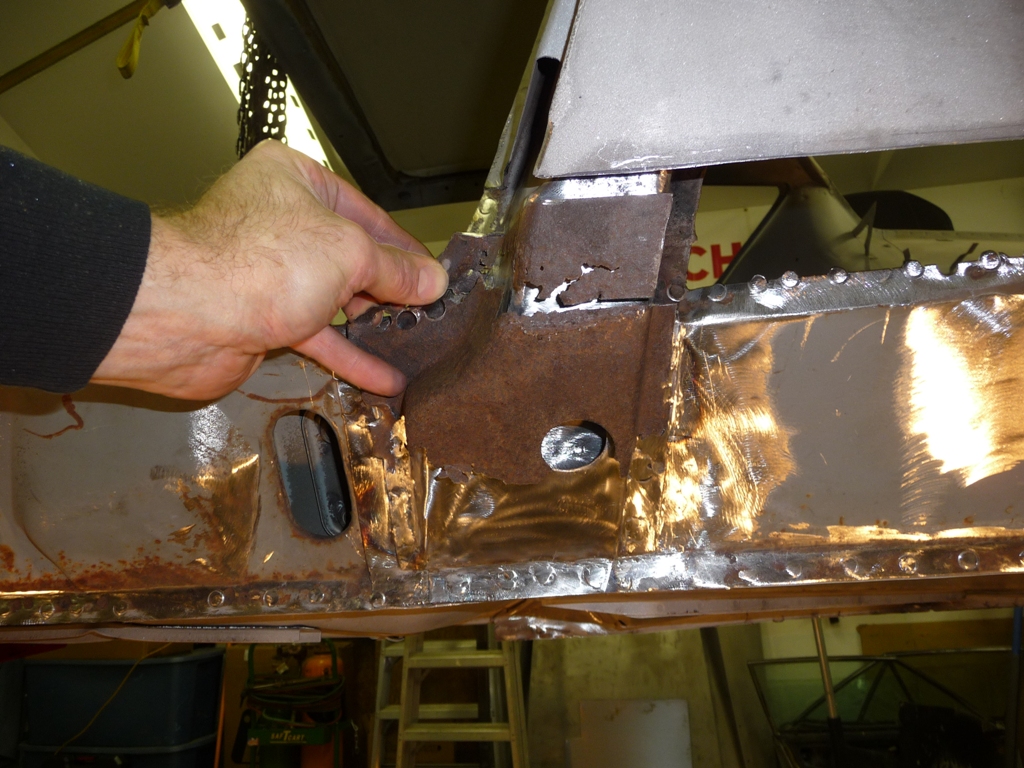
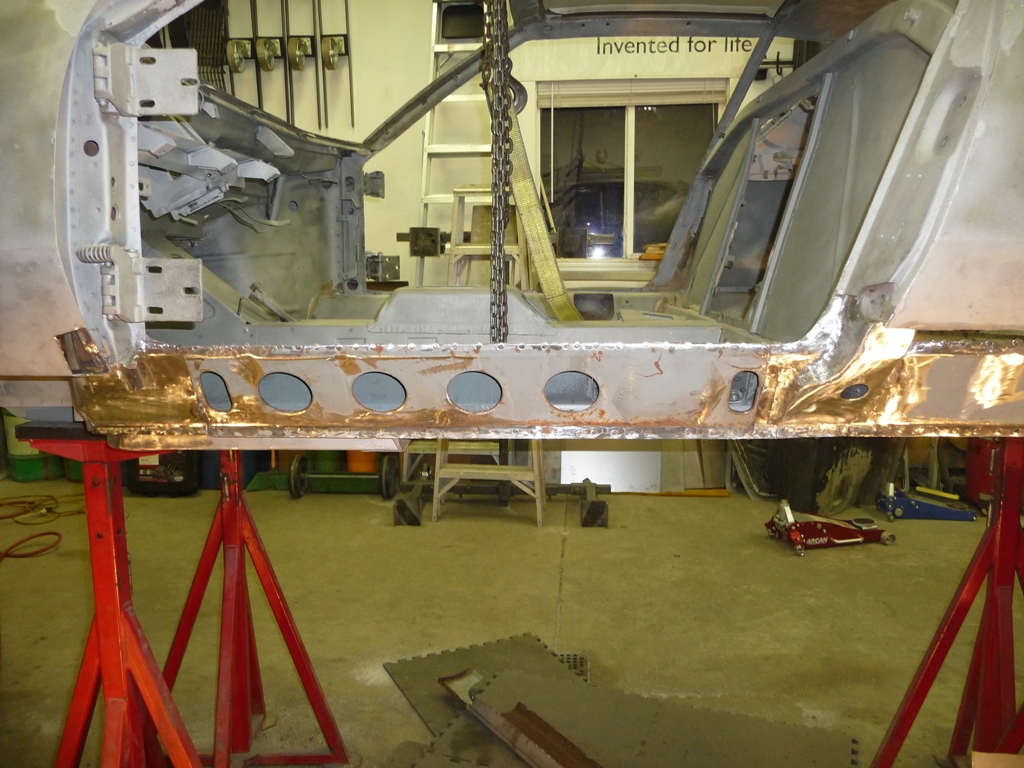
So... I managed a couple hrs this past Saturday and had an empty house for about 5 hrs on Sunday. Being the procrastinator that I am...I tackled the easy one first.
Cardboard template
Final fitment of patch
Tack welded, then I work around from each tack weld and add one more with each pass. I do this to try and avoid getting too much heat in the panel.
With all the gaps between the initial tack welds filled, I grind it clean.
Here is what it looks like from the inside of the rocker
Then the front piece....
same process...
Then...the hard one...
I decided the best approach would be to make a form, so I screwed a couple of 4x4s together and hogged out a form to hammer the metal into to try and get a near net piece to work with. It took the better part of Sunday...with OK/acceptable result for a sub structure.
Rob,
You may want to consider not closing off the bottoms of the A and B posts you repaired. They fill with dirt that filters through the construction holes from the upper structure, get moist just from the humidity and will rot the bottoms again. I am sure you're protecting the inside and the car will most likely never see weather again---I just prefer to have any dirt filter out through the rocker drain divots rather than get trapped.
Looking great!
Kirk
You may want to consider not closing off the bottoms of the A and B posts you repaired. They fill with dirt that filters through the construction holes from the upper structure, get moist just from the humidity and will rot the bottoms again. I am sure you're protecting the inside and the car will most likely never see weather again---I just prefer to have any dirt filter out through the rocker drain divots rather than get trapped.
Looking great!
Kirk
Hi Kirk....funny...I was pondering that very thing on my drive to work this morning. I was trying to decide on holes in the bottom corners or a hole bottom center. I think I've decided on bottom corners. Got an opinion? thx
Feb 9th weekend progress... got the driver's rocker hammered out...
Started with addressing the drain holes mentioned by Kirk above. Decided to make holes both at corners and center. What the heck...belt and suspenders...
Then tackled the bottom sub structure of the A pillar.
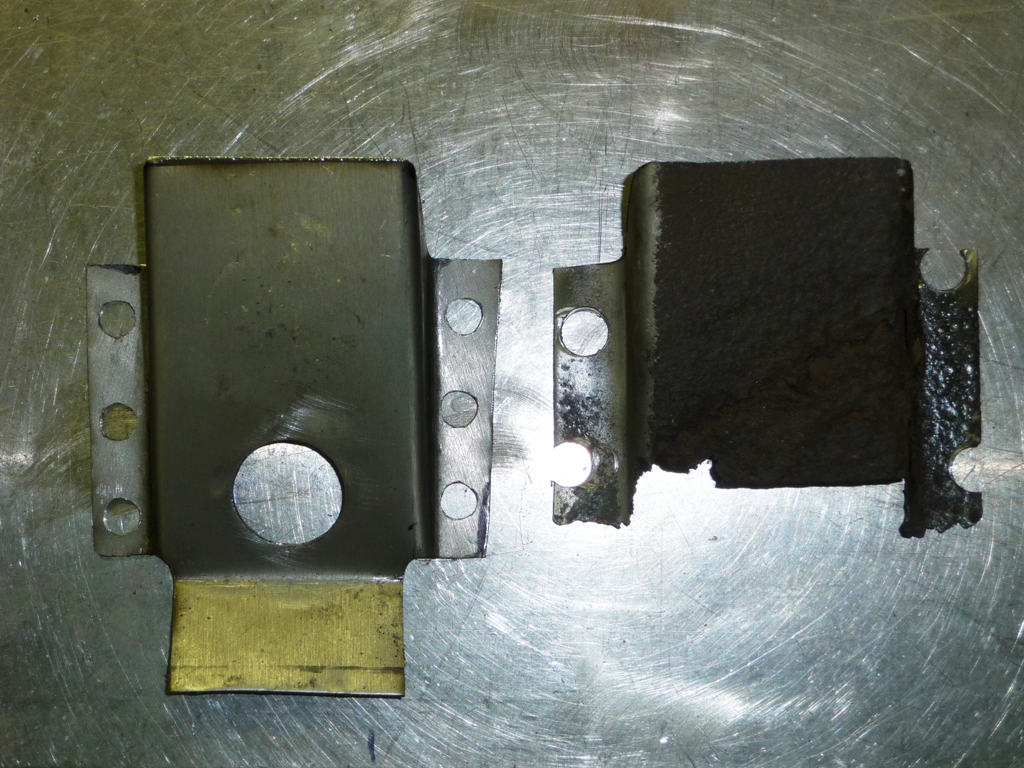
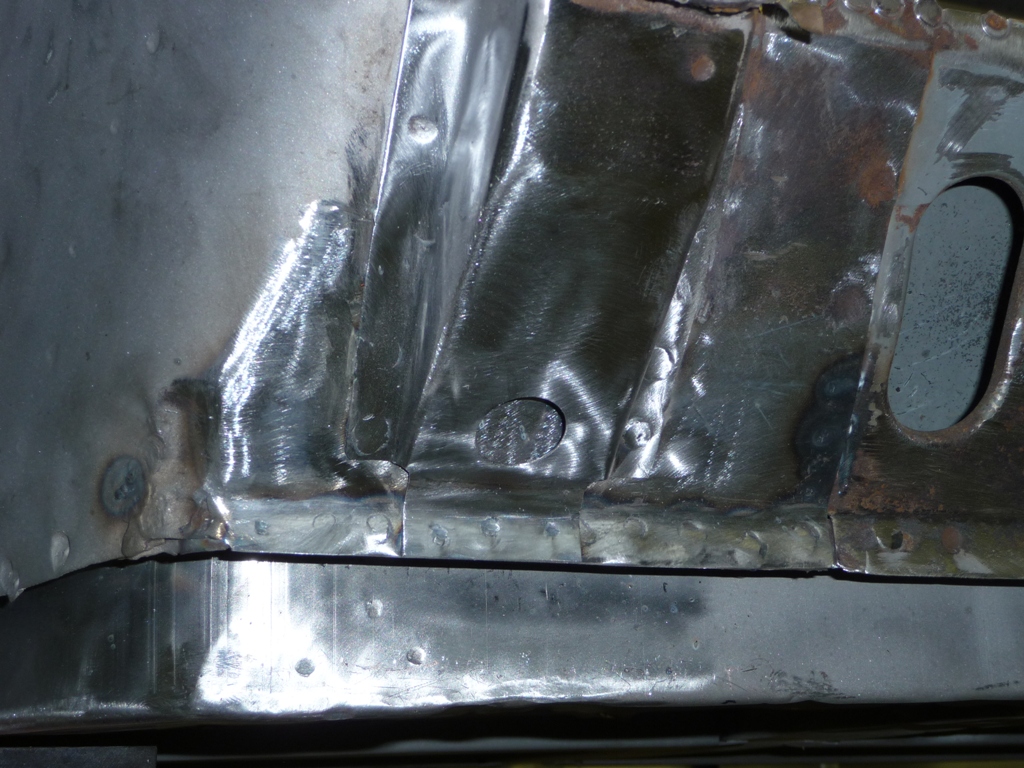
On this one, I planned ahead and incorporate the holes into the form.
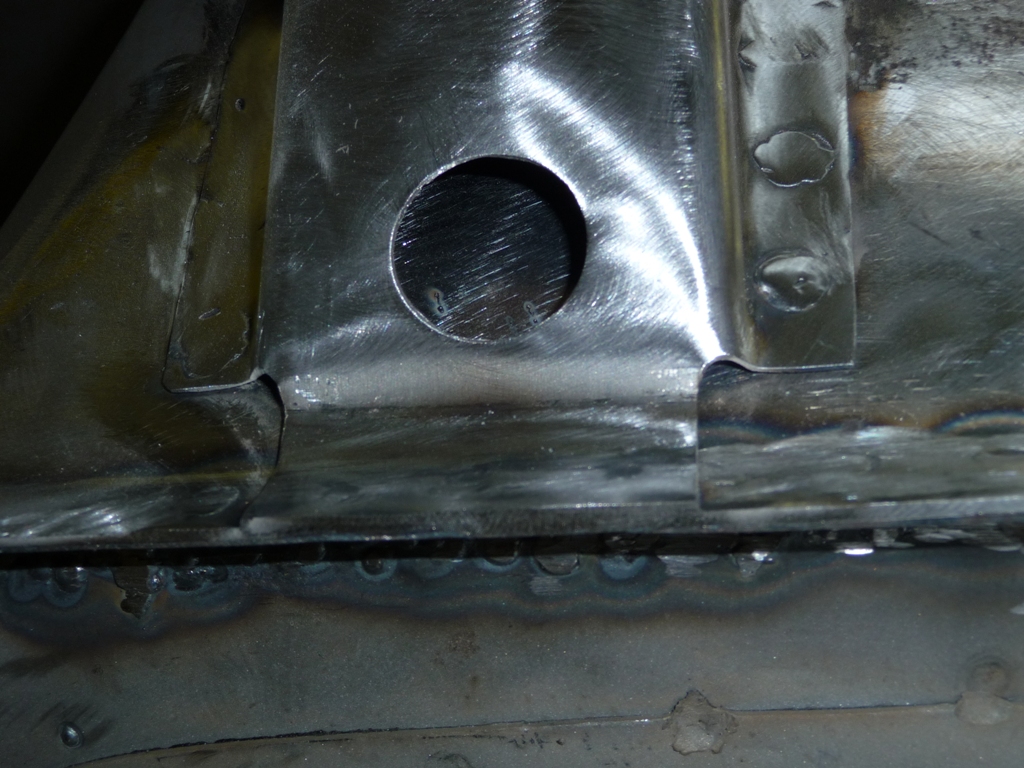
Then I tackled the rocker repair at the B pillar.
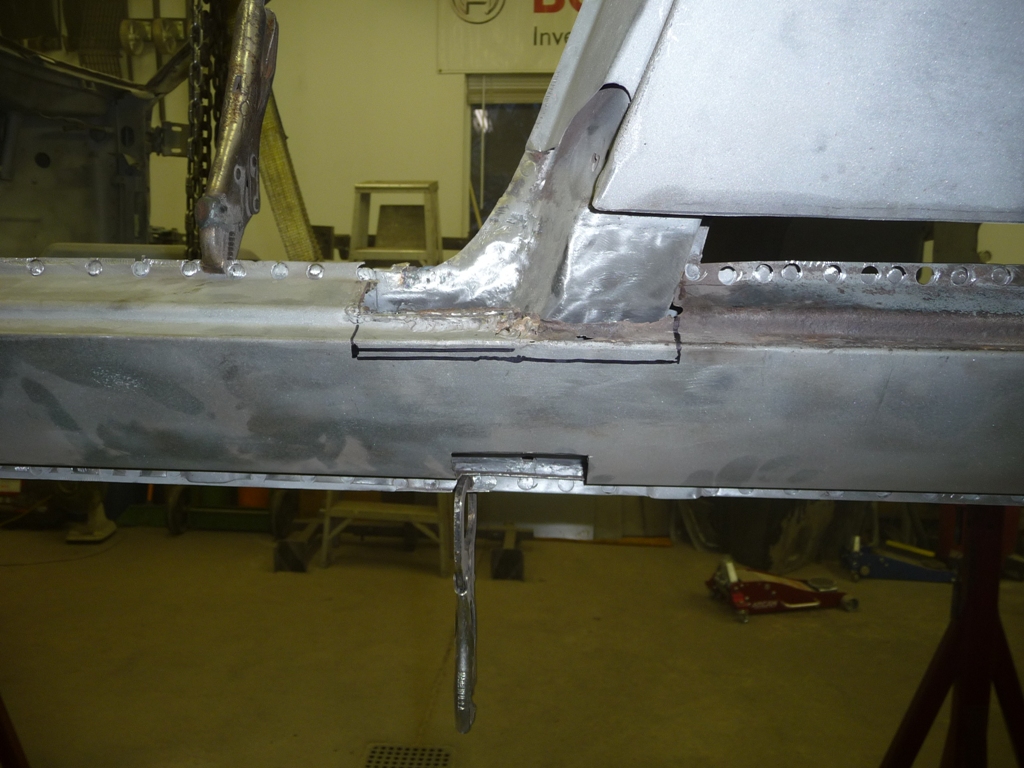
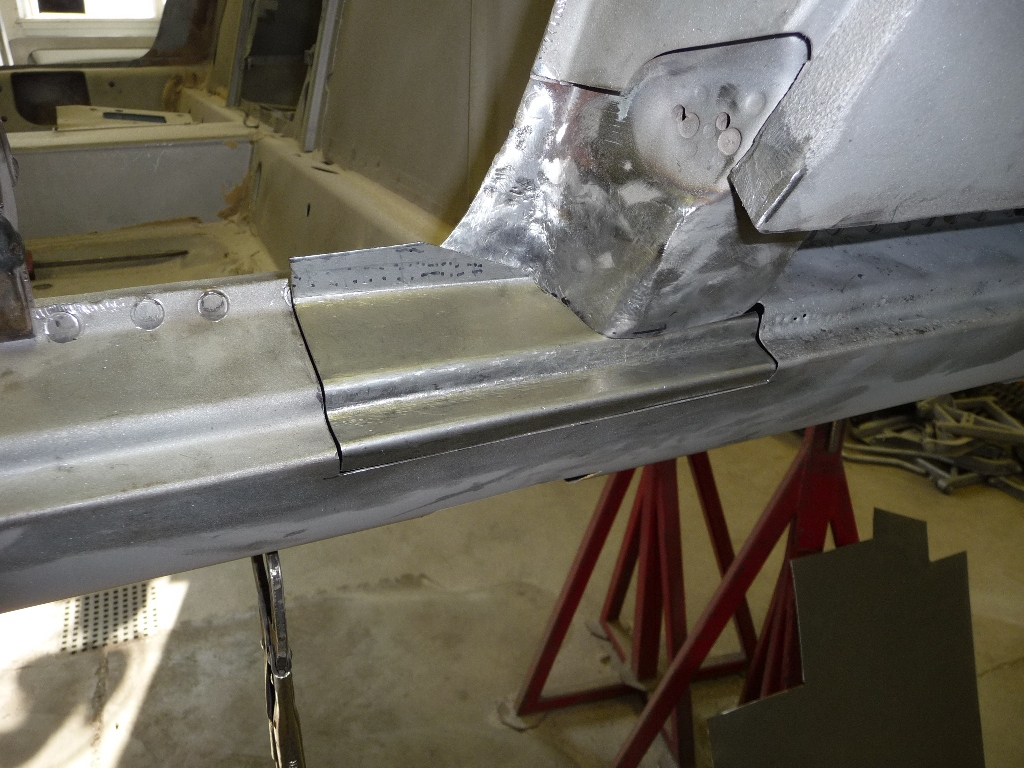
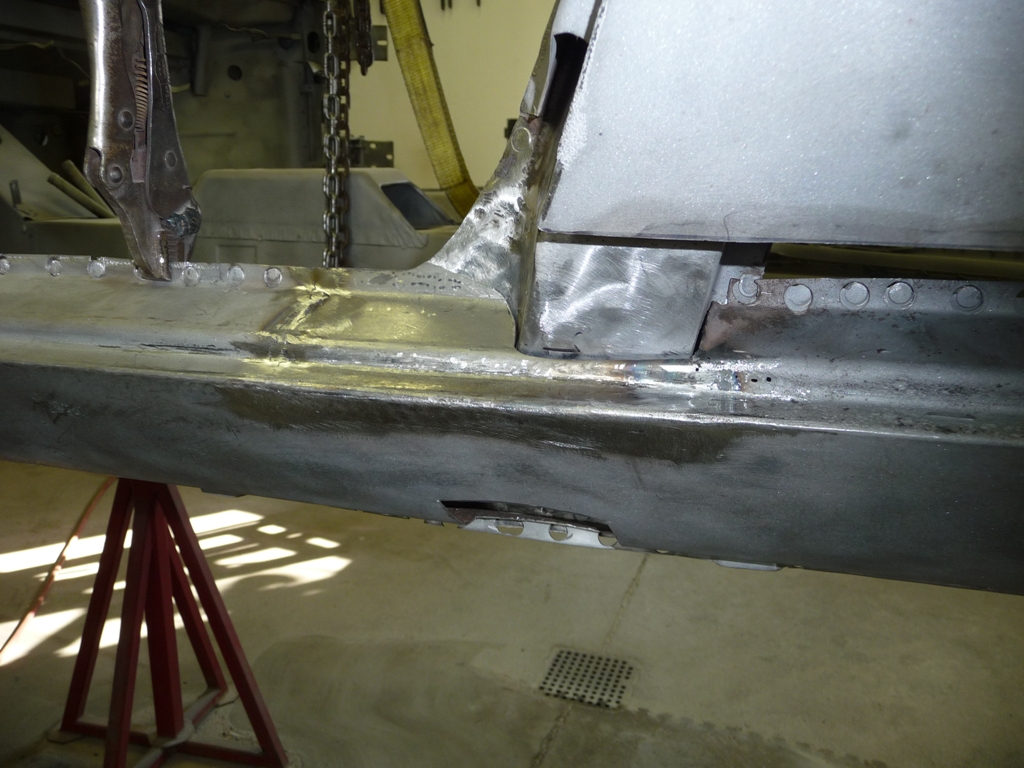
This line was kicking my butt.... Ultimately I had to call on my shop helper for another set of hands in order to get it. I figured with the door closed, this line runs parallel to the door bottom, so it had better be right.
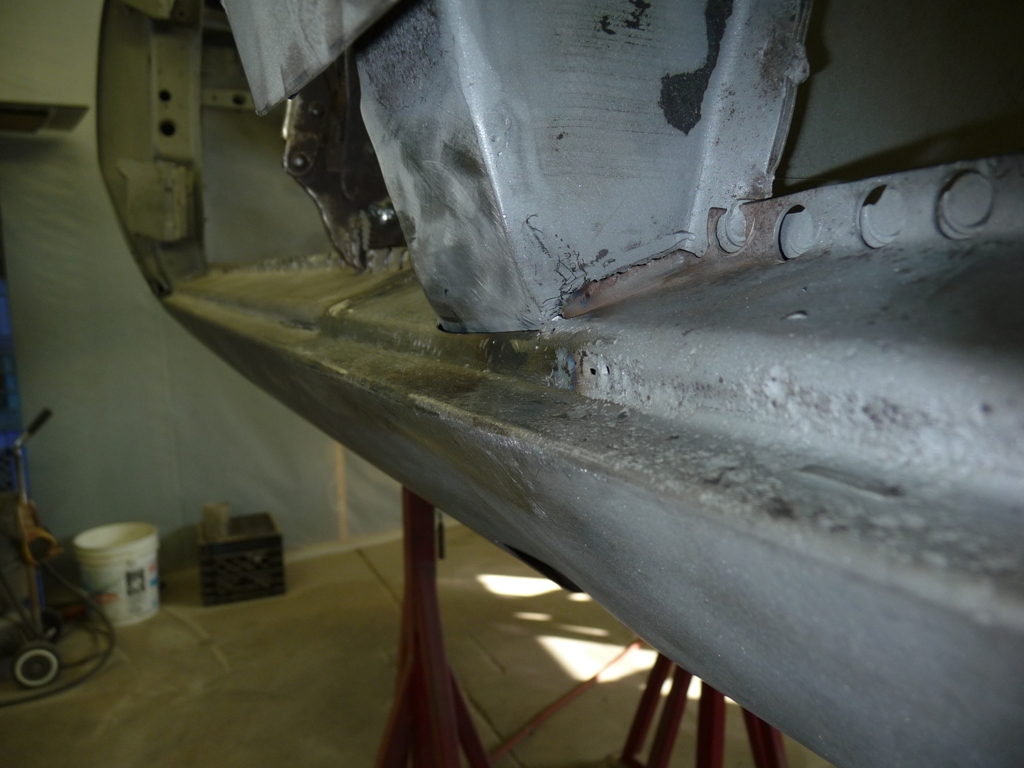
Then filled the bottom B pillar hole.
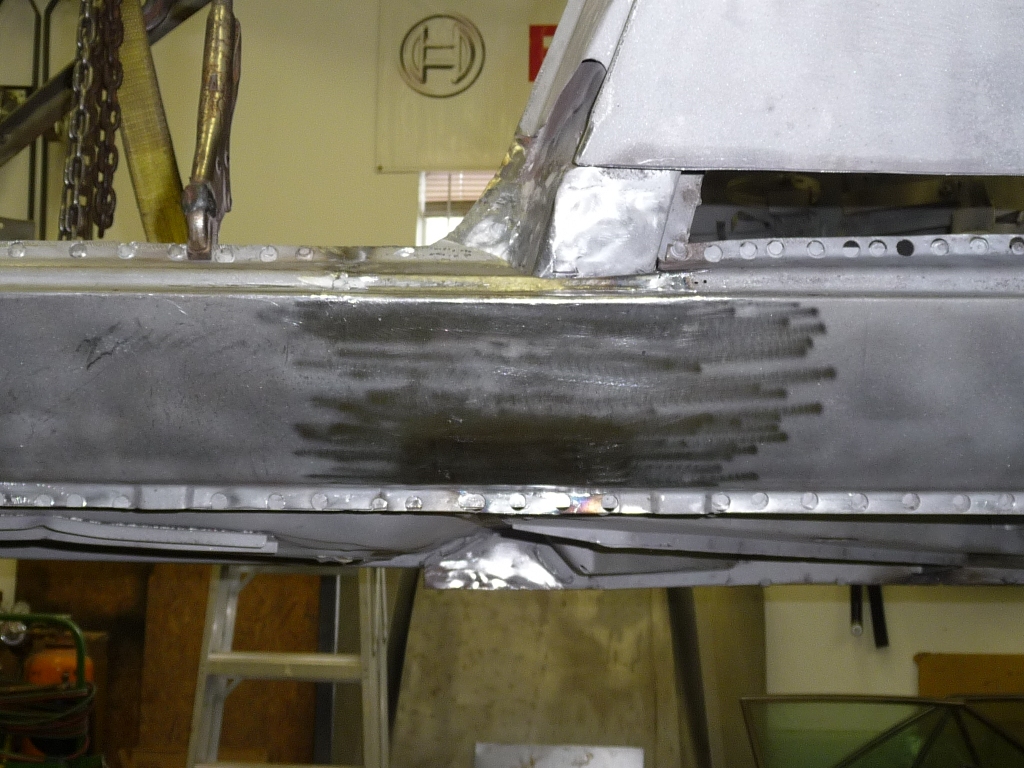
Then the A pillar hole.
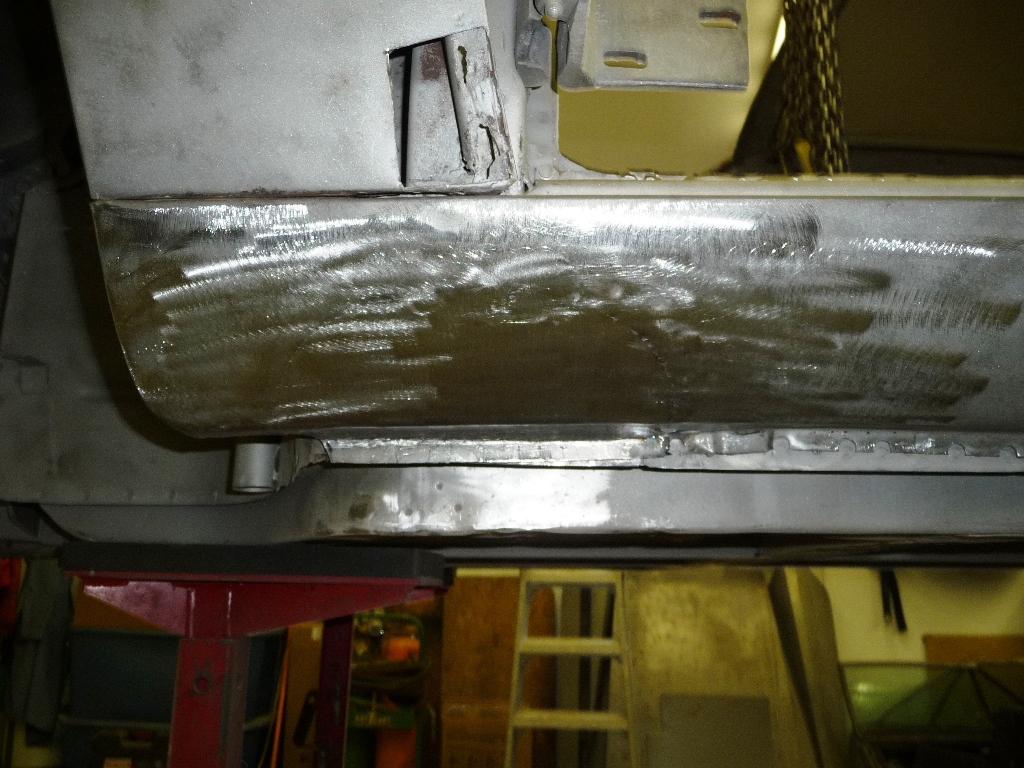
Then coated it all in the Eastwood "Internal Frame Coating".
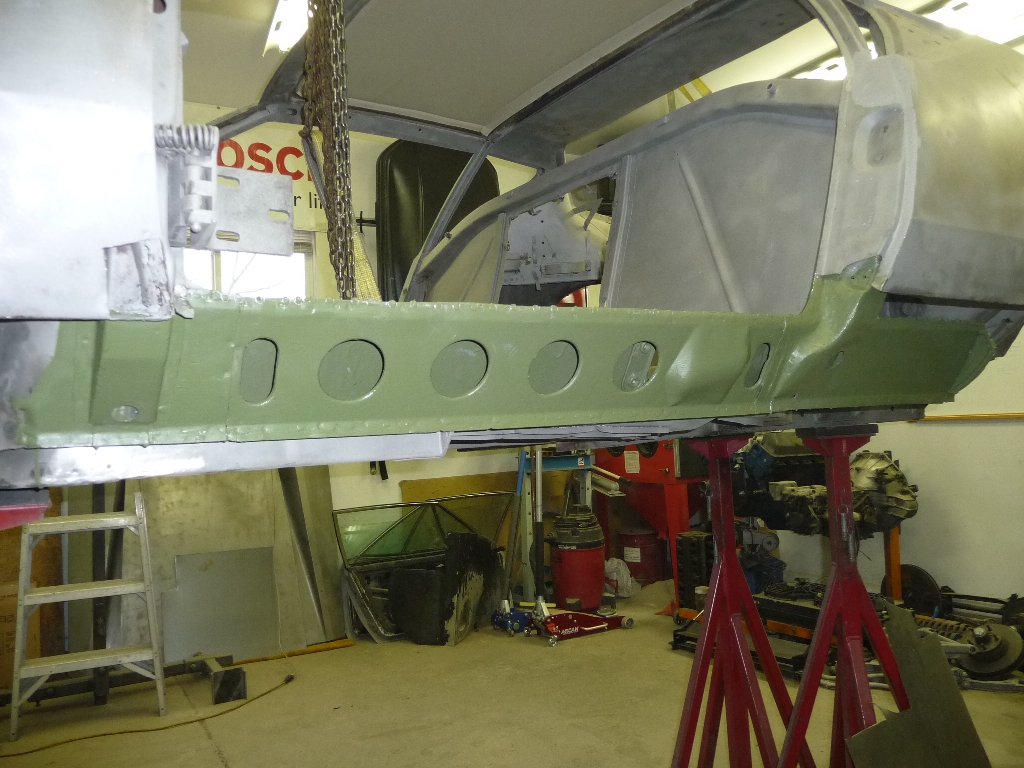
Here is the "before" again...

The driver's side is now ready for re-assembly.
Started with addressing the drain holes mentioned by Kirk above. Decided to make holes both at corners and center. What the heck...belt and suspenders...
Then tackled the bottom sub structure of the A pillar.
On this one, I planned ahead and incorporate the holes into the form.
Then I tackled the rocker repair at the B pillar.
This line was kicking my butt.... Ultimately I had to call on my shop helper for another set of hands in order to get it. I figured with the door closed, this line runs parallel to the door bottom, so it had better be right.
Then filled the bottom B pillar hole.
Then the A pillar hole.
Then coated it all in the Eastwood "Internal Frame Coating".
Here is the "before" again...
The driver's side is now ready for re-assembly.
I must say these pictures are an inspiration. I can weld, and I can do work like shown (almost), but I rarely have the patience to do it that great in a place where it can't be seen. I remember fixing a floor pan on my orig Camaro, spent more than one day bending to get the right profiles, and nobody will ever see it. Is it worth it? Not if you do it for a living, but if you have time to do it on your own pride and joy, that's great. 
One question. Some pictures indicate that you haven't fully welded on mating surfaces, only spot welded, or was it just WIP? I always weld fully, is there a reason not to, can it get too solid so it'll twist other things?
One question. Some pictures indicate that you haven't fully welded on mating surfaces, only spot welded, or was it just WIP? I always weld fully, is there a reason not to, can it get too solid so it'll twist other things?
Rob, it may be worth fitting the doors while you do some of the repair. My door jambs had a lot of lead in from the factory to correct for some sloppy metal work and poor fit. I removed most of the lead then cut-refit the door jambs to get the doors to fit a lot better. I don't want to inundate your thread with my pictures so here is a link:
http://www.rc-tech.net/pantera1/door/door.htm
http://www.rc-tech.net/pantera1/door/door.htm
BTW, here is a door hanger which made things much easier for me to put doors on and pull them off multiple times:
http://www.rc-tech.net/pantera1/dh/dh.htm
Great for painting too. The doors should be on the car for the paint color to flow correctly. I did the next best thing. I had them next to the car and ran the paint gun form one panel to the door to the next panel. It's a little ahead of you but just showing more value in the door hangers:
http://www.rc-tech.net/pantera1/paint3/done2b.jpg
http://www.rc-tech.net/pantera1/dh/dh.htm
Great for painting too. The doors should be on the car for the paint color to flow correctly. I did the next best thing. I had them next to the car and ran the paint gun form one panel to the door to the next panel. It's a little ahead of you but just showing more value in the door hangers:
http://www.rc-tech.net/pantera1/paint3/done2b.jpg
Well thanks Mikael. I've been called many things, but never inspirational.. 
Believe me... when it's taking 4 hours to bend up a single piece, I'm questioning it.... But if I do anything less, then I wouldn't feel proud of it. For me, that seems to be the main motivator. Just how my head works...no sense getting into an argument with myself about it... hell I always get confused about which side wins anyway...
No, I have not fully welded the sections I have worked on. In fact, I am trying to replicate the approximate spot weld count from original assembly also, as I don't know what I'm gonna have to do on the other side. This leads into a theory of mine that I'll share...My theory is that the chassis is a system, like many others in the complete vehicle. The chassis components/pieces as they are assembled must work in a balanced way (symmetrically). So, if I ever make a modification to one side, I make the same modification to the other side. In this case, I have no idea what's on the other side yet. I believe this philosophy ensures the foundation of a well balanced car. That blah blah blah said, I am restoring this car to be original (expect for some bolt on goodies of course...), so have no intention of doing any seem welding. My 69 mustang on the other hand, did receive a fairly comprehensive seem welding treatment. So I'm with you regarding the performance advantages.
Comp2...not a bad idea..! Especially when it comes to filling the quarter panel piece I cut out. That could save some heartache later.
Those door hangers look slick. They look like real back savers. I may just have to fab some of those up. You're not gonna ask for any royalties now....are you...?
Believe me... when it's taking 4 hours to bend up a single piece, I'm questioning it.... But if I do anything less, then I wouldn't feel proud of it. For me, that seems to be the main motivator. Just how my head works...no sense getting into an argument with myself about it... hell I always get confused about which side wins anyway...
No, I have not fully welded the sections I have worked on. In fact, I am trying to replicate the approximate spot weld count from original assembly also, as I don't know what I'm gonna have to do on the other side. This leads into a theory of mine that I'll share...My theory is that the chassis is a system, like many others in the complete vehicle. The chassis components/pieces as they are assembled must work in a balanced way (symmetrically). So, if I ever make a modification to one side, I make the same modification to the other side. In this case, I have no idea what's on the other side yet. I believe this philosophy ensures the foundation of a well balanced car. That blah blah blah said, I am restoring this car to be original (expect for some bolt on goodies of course...), so have no intention of doing any seem welding. My 69 mustang on the other hand, did receive a fairly comprehensive seem welding treatment. So I'm with you regarding the performance advantages.
Comp2...not a bad idea..! Especially when it comes to filling the quarter panel piece I cut out. That could save some heartache later.
Those door hangers look slick. They look like real back savers. I may just have to fab some of those up. You're not gonna ask for any royalties now....are you...?
LOL, no royalties. I think with the photos you could fab them up in about 30 min.
Gary
Gary
Great work Rob!
Were are you located in Michigan?
Tom
Were are you located in Michigan?
Tom
Thanks for all the photos Rob. Great job! I have always wished to be able to do that kind of metal work, but alas no talent. Thanks for sharing your work!!!
Excellent comp..I'm gonna have to fab some of those babies up.
Thanks Tom. I'm just north of Pontiac.
Thanks Rapid. Heck.....I'm faking my way through it..
OK, so didn't manage to get too much done this weekend, my back was acting up...so had to take it a little easy...
Decided to use a flexible shaft bore scope and inspect the passenger side rocker to see if dis-assembly to work on the bottom of the B pillar would be necessary. Upon inspection, I found a whole lot more left over sand blast media than I had anticipated. So, used some different sizes of rubber tubing on the vacuum and cleaned it out. Then used an old antenna shaft to slide down in the rocker with the scope to "flick" out any left over rocks that were jammed in. It was a cool task. It was like doing arthroscopic surgery on my car. The good news...the B pillar looks fine. It will survive. It has surface rust, but I'll coat it with the frame coating and it will pull through w/o surgery being needed.
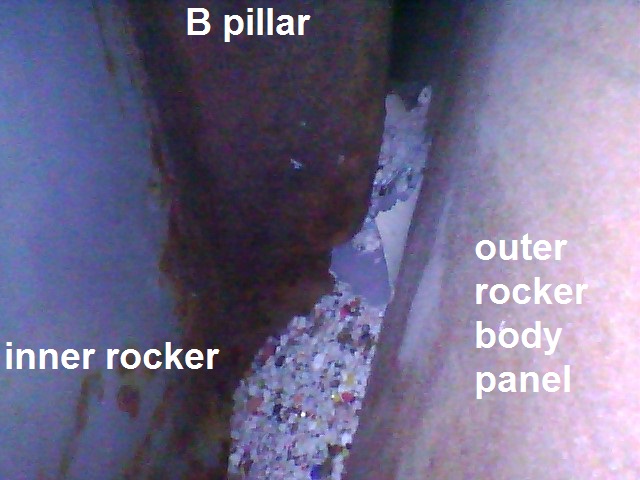
inside of B pillar...before..
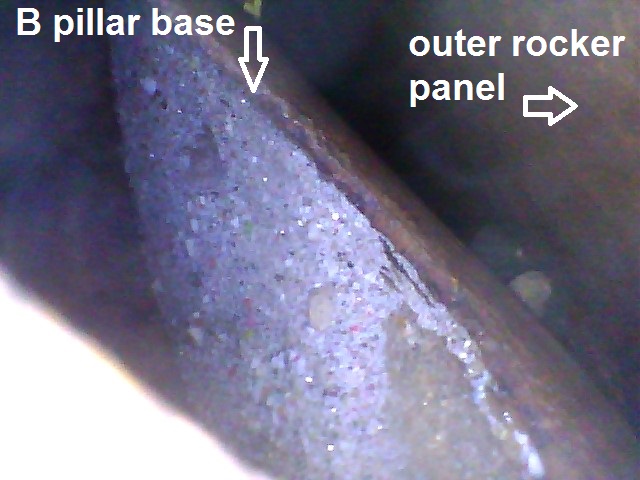
inside of B pillar...after.

After all cleaning, scraping..vacuuming... The upper piece is the B pillar, the lower is the out rocker skin (the camera rotated)
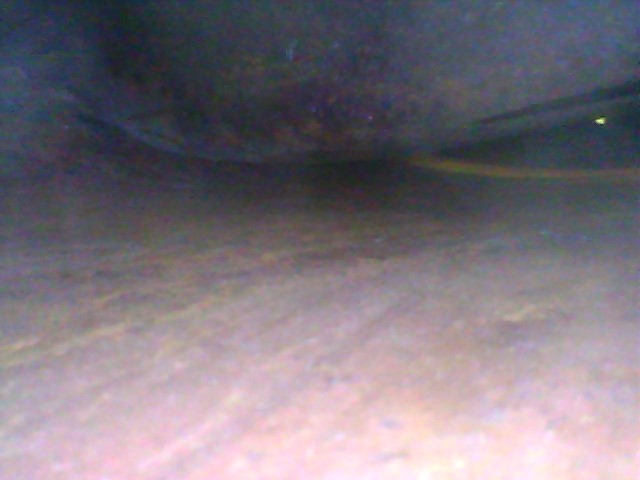
Then tackled the hole in the drivers front fender.
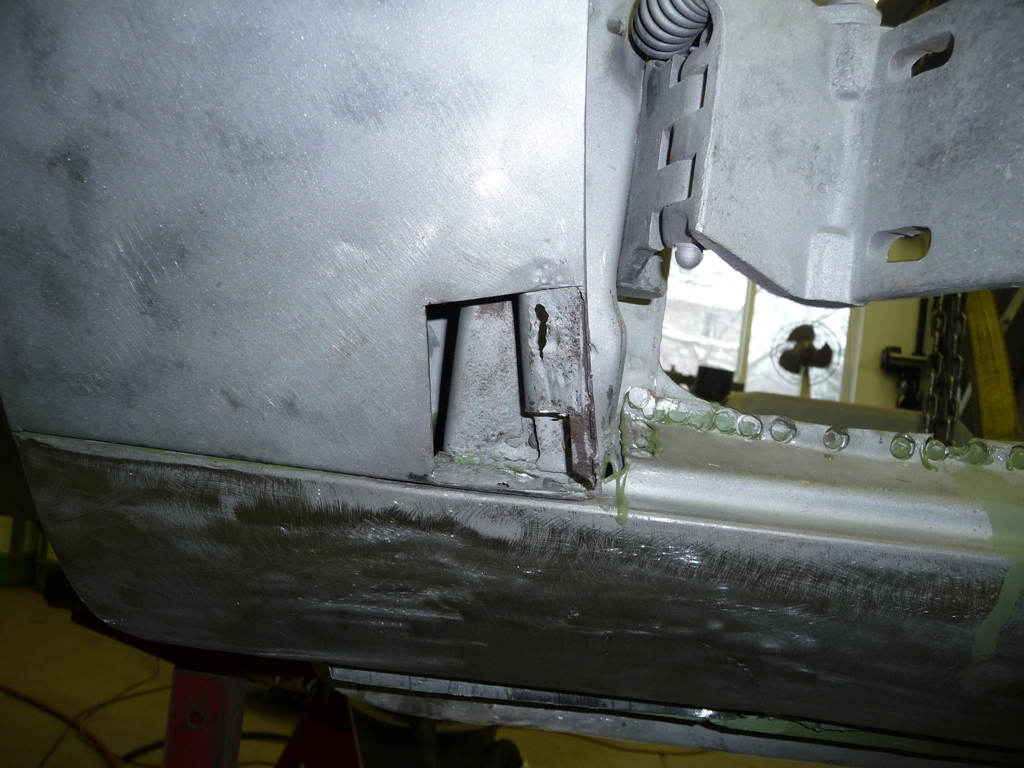


Then got started on the tedious task of welding the rocker back on. Got started...but long way from finished.
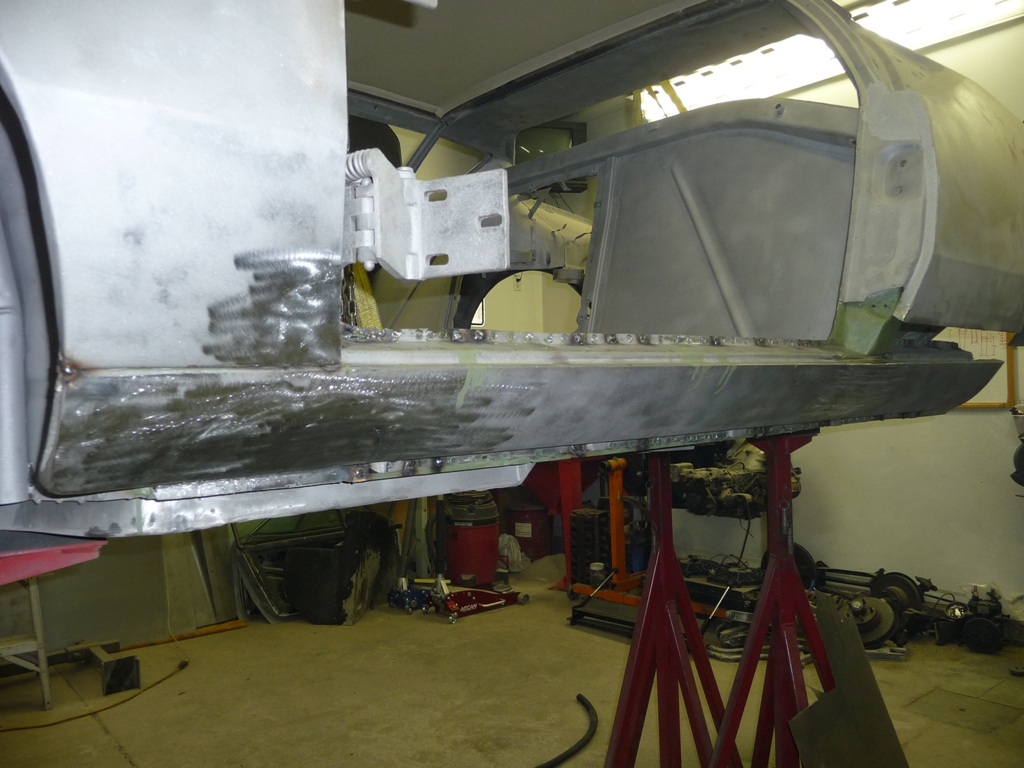
Thanks Tom. I'm just north of Pontiac.
Thanks Rapid. Heck.....I'm faking my way through it..
OK, so didn't manage to get too much done this weekend, my back was acting up...so had to take it a little easy...
Decided to use a flexible shaft bore scope and inspect the passenger side rocker to see if dis-assembly to work on the bottom of the B pillar would be necessary. Upon inspection, I found a whole lot more left over sand blast media than I had anticipated. So, used some different sizes of rubber tubing on the vacuum and cleaned it out. Then used an old antenna shaft to slide down in the rocker with the scope to "flick" out any left over rocks that were jammed in. It was a cool task. It was like doing arthroscopic surgery on my car. The good news...the B pillar looks fine. It will survive. It has surface rust, but I'll coat it with the frame coating and it will pull through w/o surgery being needed.
inside of B pillar...before..
inside of B pillar...after.
After all cleaning, scraping..vacuuming... The upper piece is the B pillar, the lower is the out rocker skin (the camera rotated)
Then tackled the hole in the drivers front fender.
Then got started on the tedious task of welding the rocker back on. Got started...but long way from finished.
Rob,
I am impressed and inspired with your work. Can you post a picture or two of how you grind down the welds to clean up the surface? What tools are you using for that process?
Steve
I am impressed and inspired with your work. Can you post a picture or two of how you grind down the welds to clean up the surface? What tools are you using for that process?
Steve
Thanks Steve.
Regarding your request.....here's how I do it. Of course this is just one guys approach /opinion....
I use this guy to cut my holes. This way I get nice clean edges. Symmetrical /squared off shapes are always easiest.
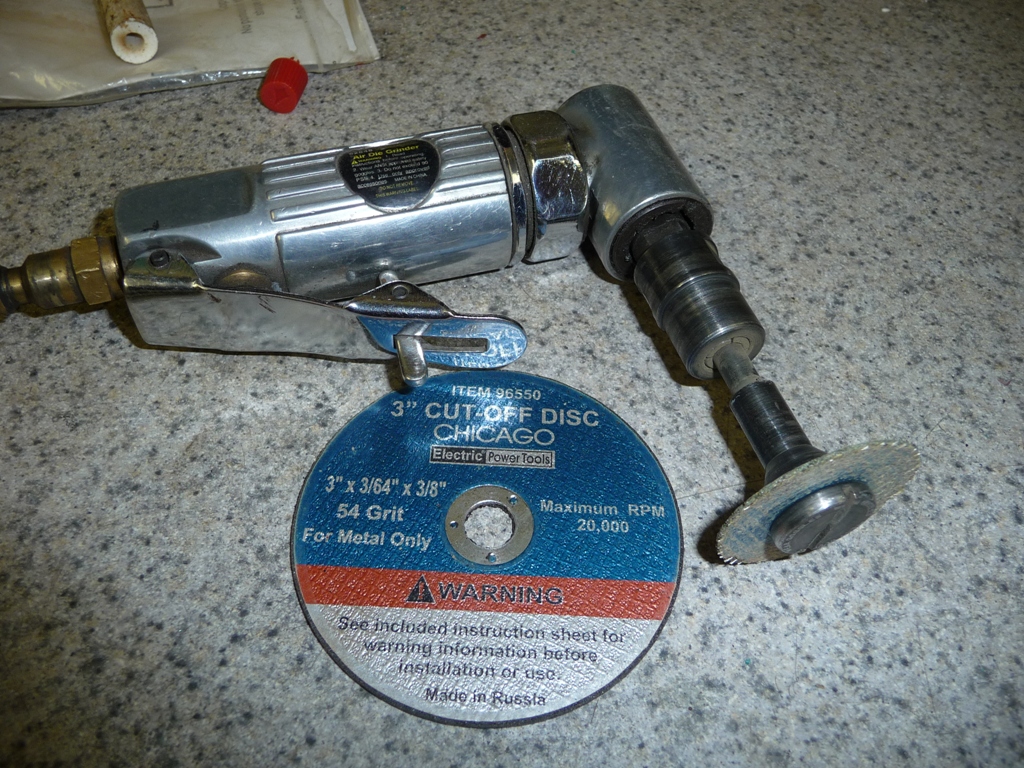
Then, as shown in many pics, I "ONLY" do tack/spot welds. This is so that you don't burn through (as much...;-) and so you don't get the panel too hot, as it can distort if it does. Then I go around filling in gaps..around and around, one spot with each pass until all gaps are filled and it's fully welded. If I see some spots that need a little extra I go back and hit them again. It's always easier to grind once, rather than grind a small area a second time.
Then, to grind, I use this guy. I only use 3M grinding discs (as shown). They are bloody expensive, but I think worth it. For each fresh repair I use a new disc. This sucks because of the cost, but it is necessary. This is because it is nice and stiff when new. With it being stiff, I can grind the high points with reducing how much the grinder runs on the body panels. I try my absolute best to only have the grinder running on the welds, as any running on the body panel thins it. This is also why I don't like going back and adding more weld later. It's really tough to grind a little spot w/o touching the surroundings.
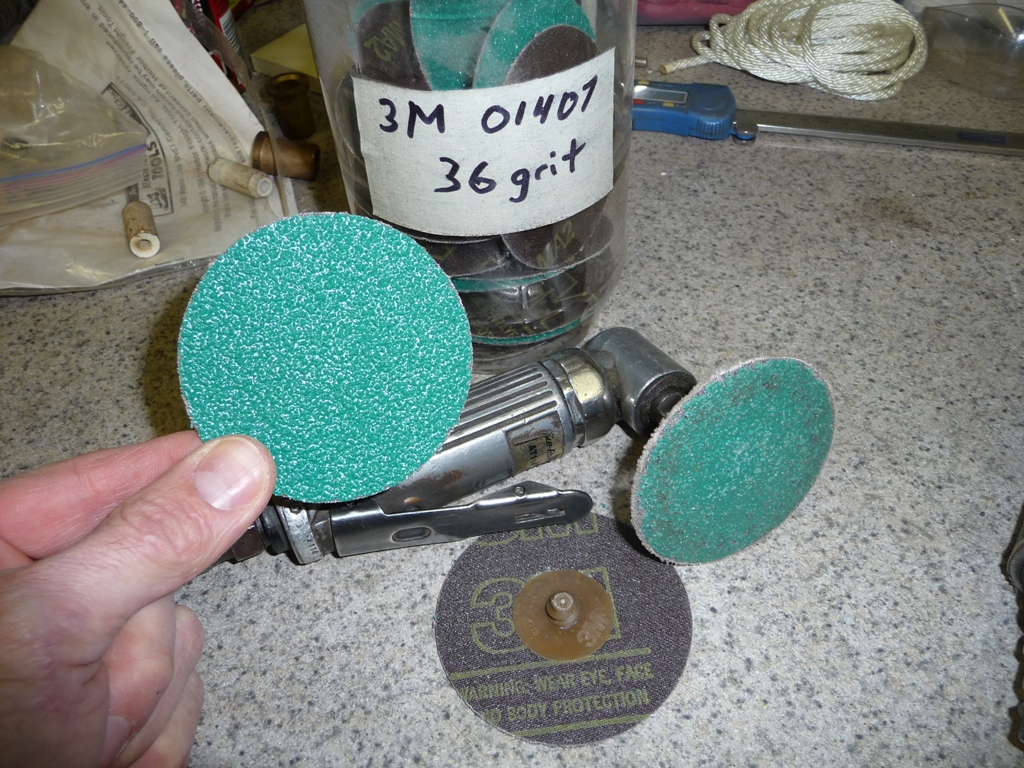
Then I do a quick run across with this guy to give the surface a uniform texture. Really no "need" to do this, it just blends the appearance. Which is totally irrelevant since they will get a skim coat of body filler...but I just like how it looks more in the mean time...
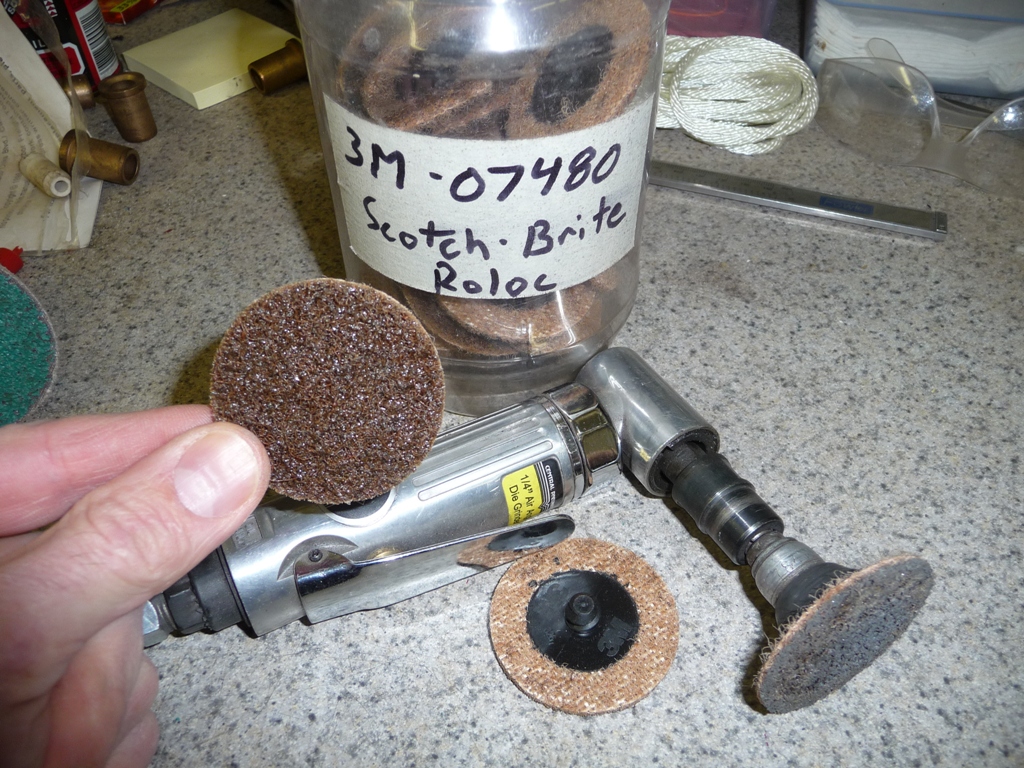
And that's that...not rocket science...just patience and care/attention. Hope this helped and answered your questions adequately. Rob
Regarding your request.....here's how I do it. Of course this is just one guys approach /opinion....
I use this guy to cut my holes. This way I get nice clean edges. Symmetrical /squared off shapes are always easiest.
Then, as shown in many pics, I "ONLY" do tack/spot welds. This is so that you don't burn through (as much...;-) and so you don't get the panel too hot, as it can distort if it does. Then I go around filling in gaps..around and around, one spot with each pass until all gaps are filled and it's fully welded. If I see some spots that need a little extra I go back and hit them again. It's always easier to grind once, rather than grind a small area a second time.
Then, to grind, I use this guy. I only use 3M grinding discs (as shown). They are bloody expensive, but I think worth it. For each fresh repair I use a new disc. This sucks because of the cost, but it is necessary. This is because it is nice and stiff when new. With it being stiff, I can grind the high points with reducing how much the grinder runs on the body panels. I try my absolute best to only have the grinder running on the welds, as any running on the body panel thins it. This is also why I don't like going back and adding more weld later. It's really tough to grind a little spot w/o touching the surroundings.
Then I do a quick run across with this guy to give the surface a uniform texture. Really no "need" to do this, it just blends the appearance. Which is totally irrelevant since they will get a skim coat of body filler...but I just like how it looks more in the mean time...
And that's that...not rocket science...just patience and care/attention. Hope this helped and answered your questions adequately. Rob
Thanks for sharing that!
That's great Rob. Thanks for the details. Keep it up.
Steve
Steve
Rob, thanks for posting all the great info....all of a sudden after seeing the pictures of your work and reading the tutorials it's not that daunting of a task to tackle some of the common problems we all seem to have. Do you buy any special metals when replacing rocker panels or doing body repair? Just curious if any special metal works better?
quote:Then, to grind, I use this guy. I only use 3M grinding discs (as shown). They are bloody expensive, but I think worth it.
Rob, if I may make a suggestion, just like the 3M grinding discs work great, so do the 3M green cutoff wheels. I use nothing else but those. More expensive, but worth it. Please give them a try and tell me how they compare to the Chicago ones. Thanks.
Rob, thanks for the very detailed description of the restoration process. I am about to start restoring my # 1685 and see what you find under the paint, gave me panic. (considering my Pantera is older and the base looks worse than what you had from the start) My idea is to make a sandblasting and correct whatever is necessary. I have some doubts: some of the blogs recommend do not remove the windshield. As I see in your photos, you don't remove the side windows, why? What do you recommend?
Please follow posting, for me will be an insuperable guide. thanks
Please follow posting, for me will be an insuperable guide. thanks
Attachments
Hi guys,
My pleasure...
Tom, no special metals. I match the gauge of the metal, but that's it. Only plain untreated steel though.
Firstpantera, yes..I can't disagree. Didn't mean to imply I had a preference with the wheels. I should probably have flipped it over so no brand showed. I find the 3M last longer, however Harbor Freight carries these Chicago ones in a really thin width, so the cut line is narrow and clean. I do like that aspect. Haven't found the 3M in such a narrow thickness. But again...I'm a big 3M fan when it comes to abrasives.
Banzai, One word of caution with sand blasting, it can warp your panels. I had my body panels chemically stripped first, then lightly blasted with plastic media. The rest of it was only media blasted. I would remove the windshield and the side glass. I only left mine in because I ran out of time to get them out before my scheduled date/time at the media blaster.
Ciao, Rob
My pleasure...
Tom, no special metals. I match the gauge of the metal, but that's it. Only plain untreated steel though.
Firstpantera, yes..I can't disagree. Didn't mean to imply I had a preference with the wheels. I should probably have flipped it over so no brand showed. I find the 3M last longer, however Harbor Freight carries these Chicago ones in a really thin width, so the cut line is narrow and clean. I do like that aspect. Haven't found the 3M in such a narrow thickness. But again...I'm a big 3M fan when it comes to abrasives.
Banzai, One word of caution with sand blasting, it can warp your panels. I had my body panels chemically stripped first, then lightly blasted with plastic media. The rest of it was only media blasted. I would remove the windshield and the side glass. I only left mine in because I ran out of time to get them out before my scheduled date/time at the media blaster.
Ciao, Rob
When I stripped our '72L to bare metal, I used Aircraft Stripper (sold in a gallon can). And I only chemically stripped to within 1" of all edges. Reason was, the chemical stripper can creep around corners and under panel overlaps. Then weeks or months later, after a repaint it bleeds back out.... I used a sanding disc much like was shown to remove the unstripped edges of old paint. There were three different colors in there.
Also found what looked like 'factory-bondo'; a light blue blob covered a huge oil-can dent on the front fender tops near the windshield. By legend, Panteras were shipped in the holds of freighters and stevedores routinely WALKED on the cars to get to the other side of the hold. The distributors in CA fixed things as fast & cheaply as possible so the brand new cars could be sold. Aircraft Stripper slowly removed the filler-blob, and a really hard punch with my fist popped the dent up into its original position with no filler at all needed. My knuckles healed up in a few days.
I was told by a pro that much the same thing happens with wholesale sandblasting of cars. If you escape panel-warping, the residual dust from blasting NEVER completely comes out of the nooks and crannies during cleaning. But some will come out during subsequent spray-painting and screw things up.
Also found what looked like 'factory-bondo'; a light blue blob covered a huge oil-can dent on the front fender tops near the windshield. By legend, Panteras were shipped in the holds of freighters and stevedores routinely WALKED on the cars to get to the other side of the hold. The distributors in CA fixed things as fast & cheaply as possible so the brand new cars could be sold. Aircraft Stripper slowly removed the filler-blob, and a really hard punch with my fist popped the dent up into its original position with no filler at all needed. My knuckles healed up in a few days.
I was told by a pro that much the same thing happens with wholesale sandblasting of cars. If you escape panel-warping, the residual dust from blasting NEVER completely comes out of the nooks and crannies during cleaning. But some will come out during subsequent spray-painting and screw things up.
All good points Bosswrench!
I'm currently trying to figure out a way to vibrate the chassis to shake out the sand. I need a paint shaker or something to mount to it....
Here's this weekend's progress...
Tackled the passenger side "A" pillar and rocker repair.
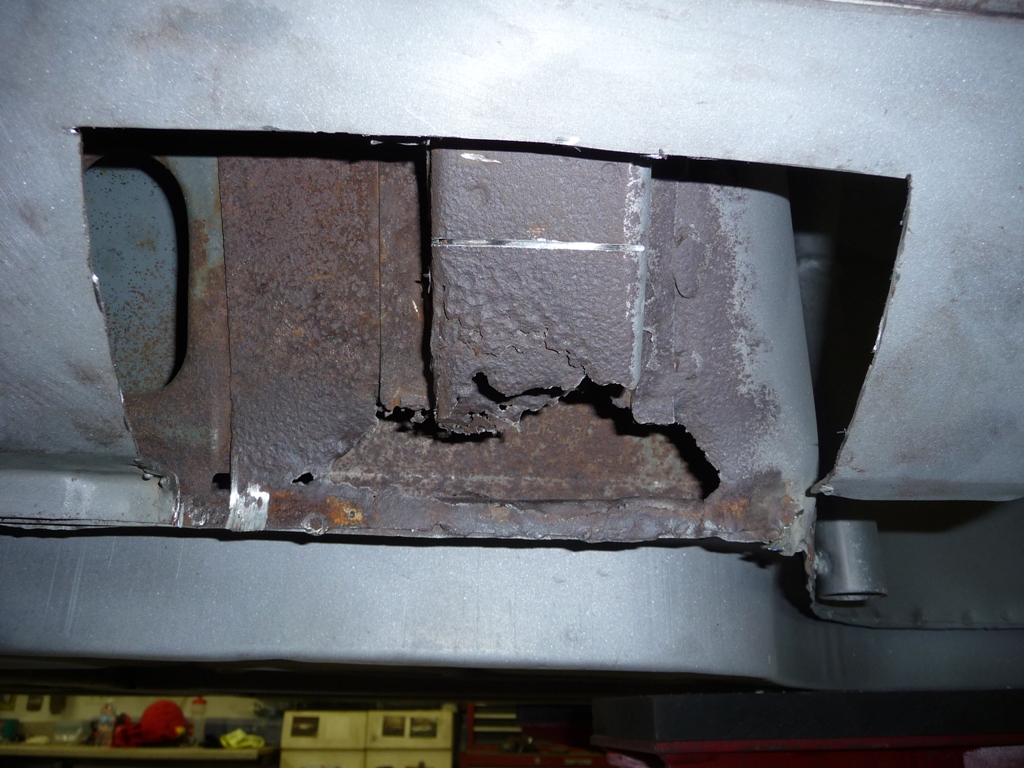
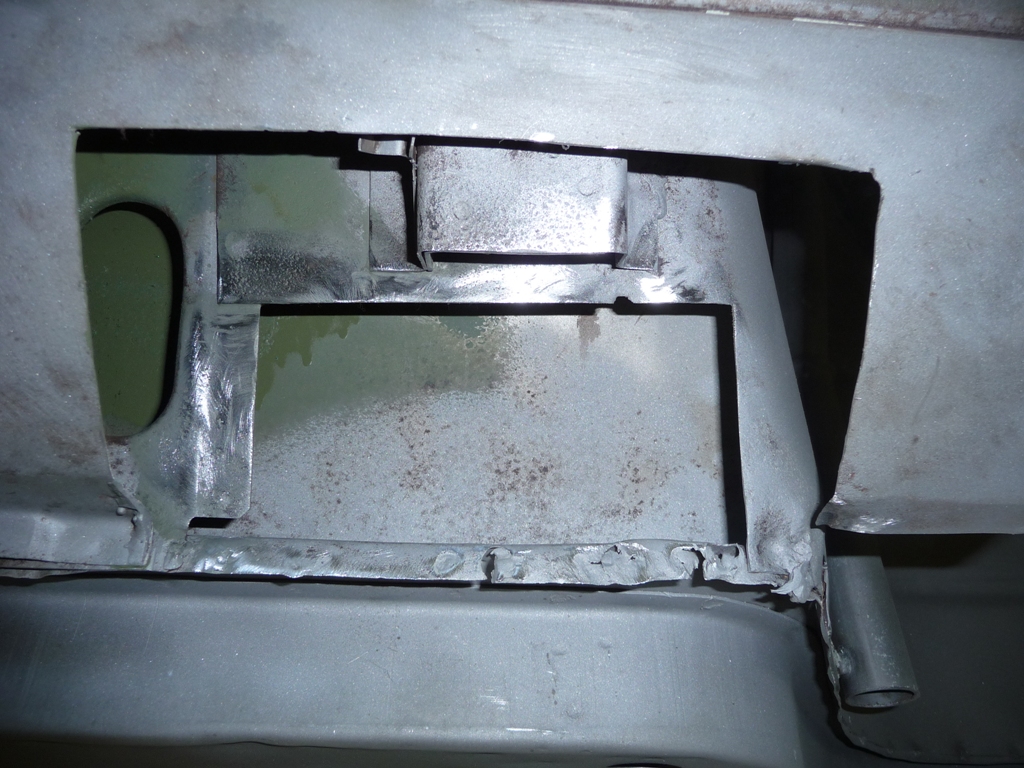
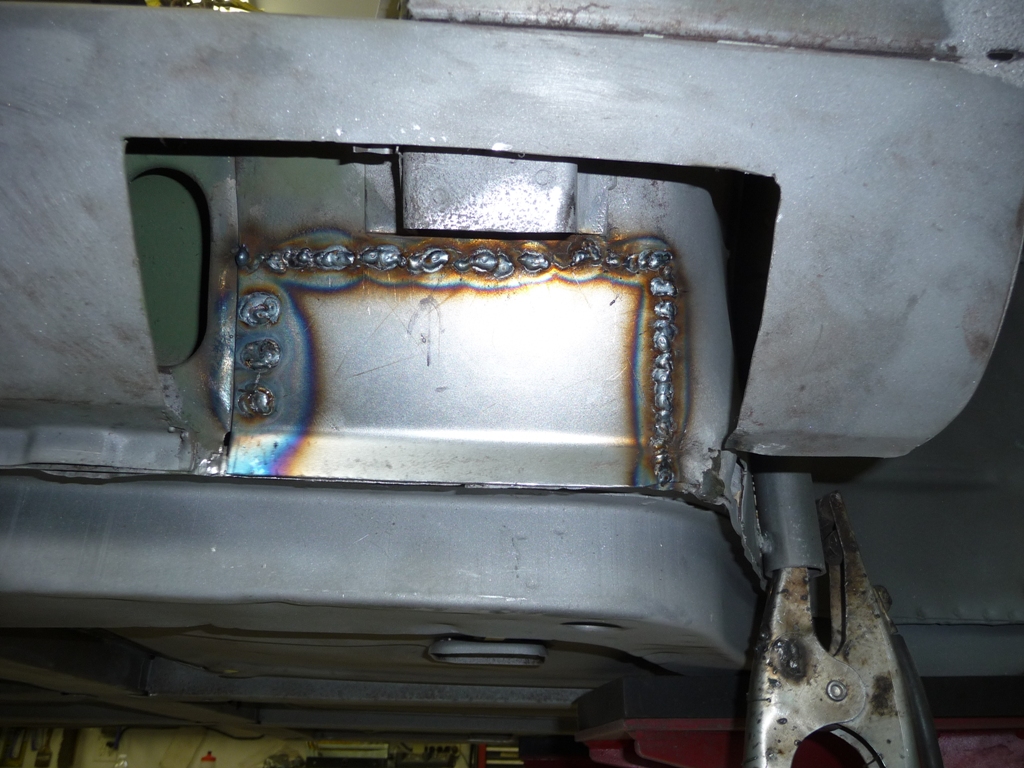
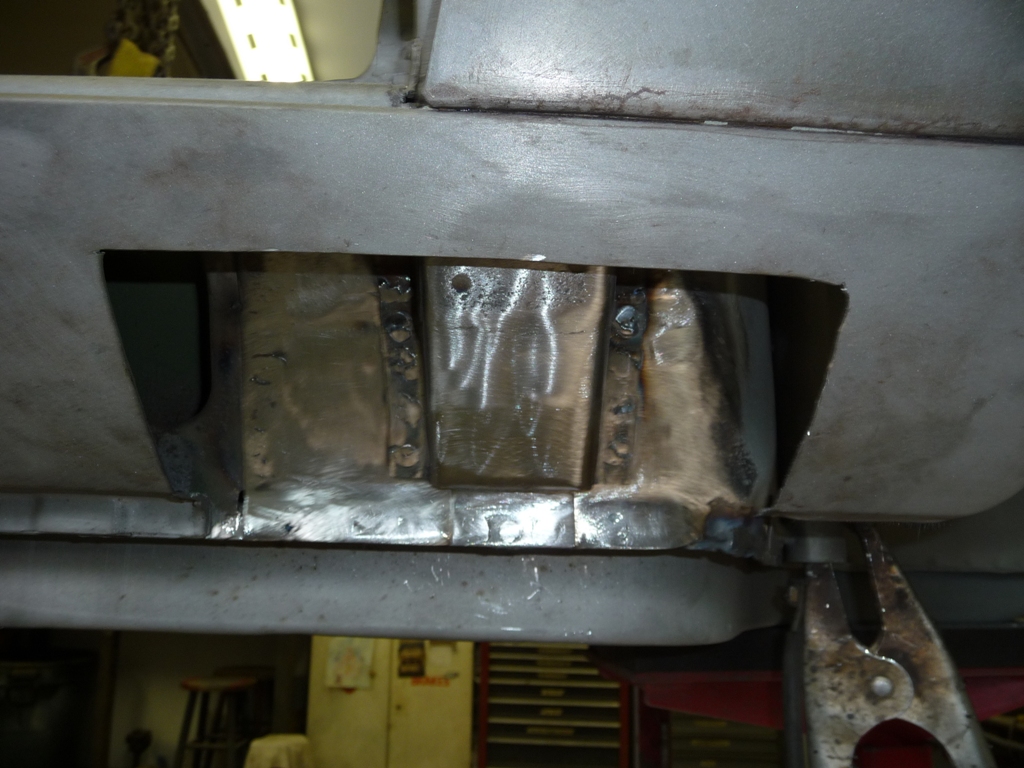
Designed in drainage...I like this one better than the others from the driver's side...
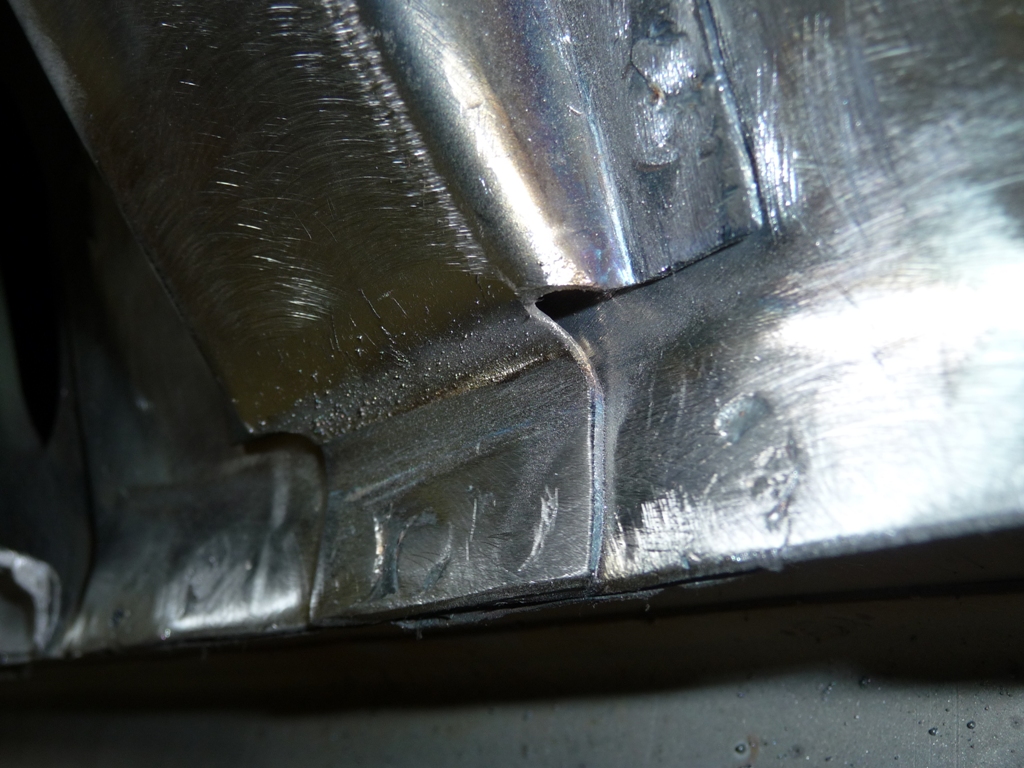
Gave a squirt of the frame coating before closing it up.
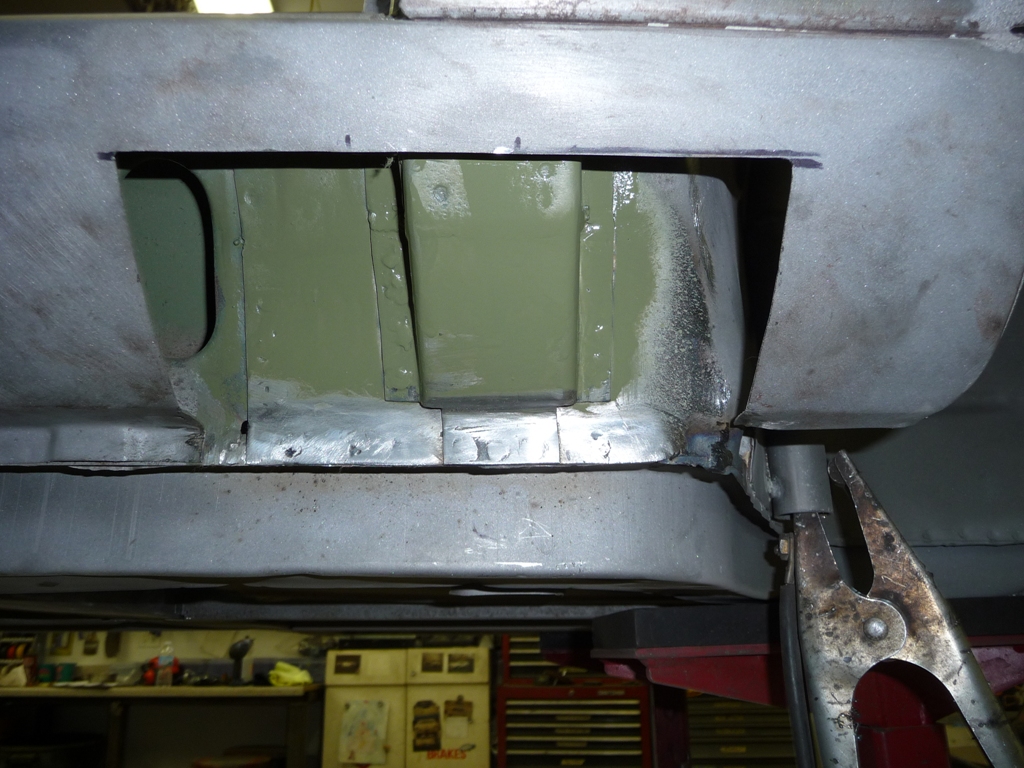
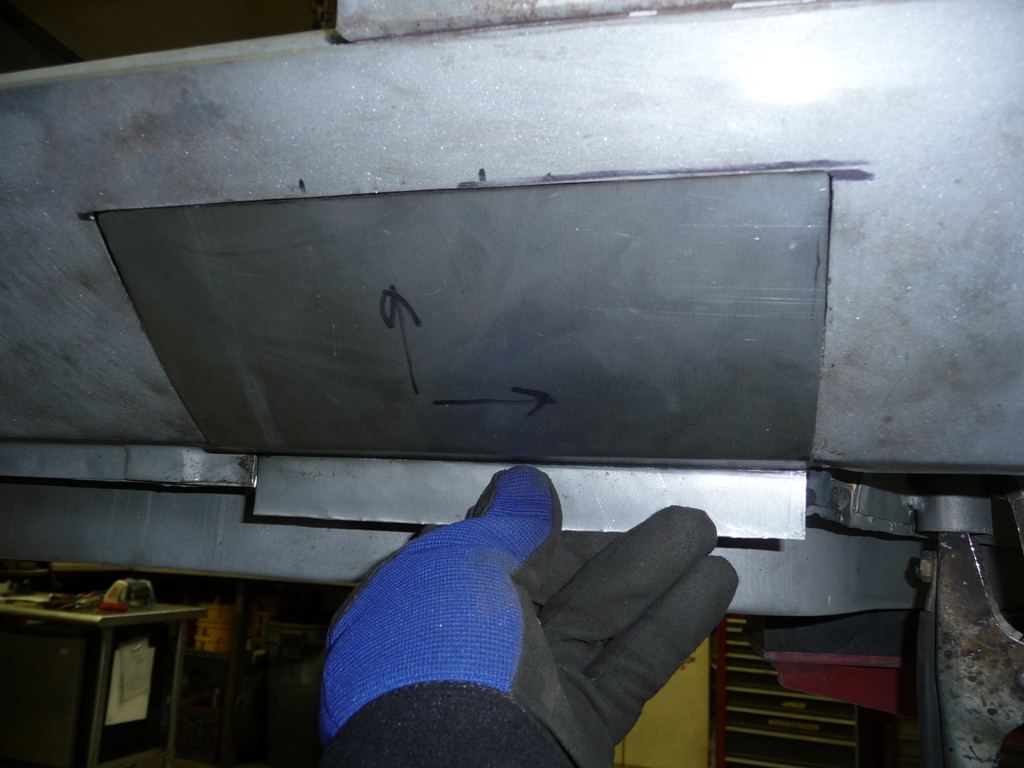
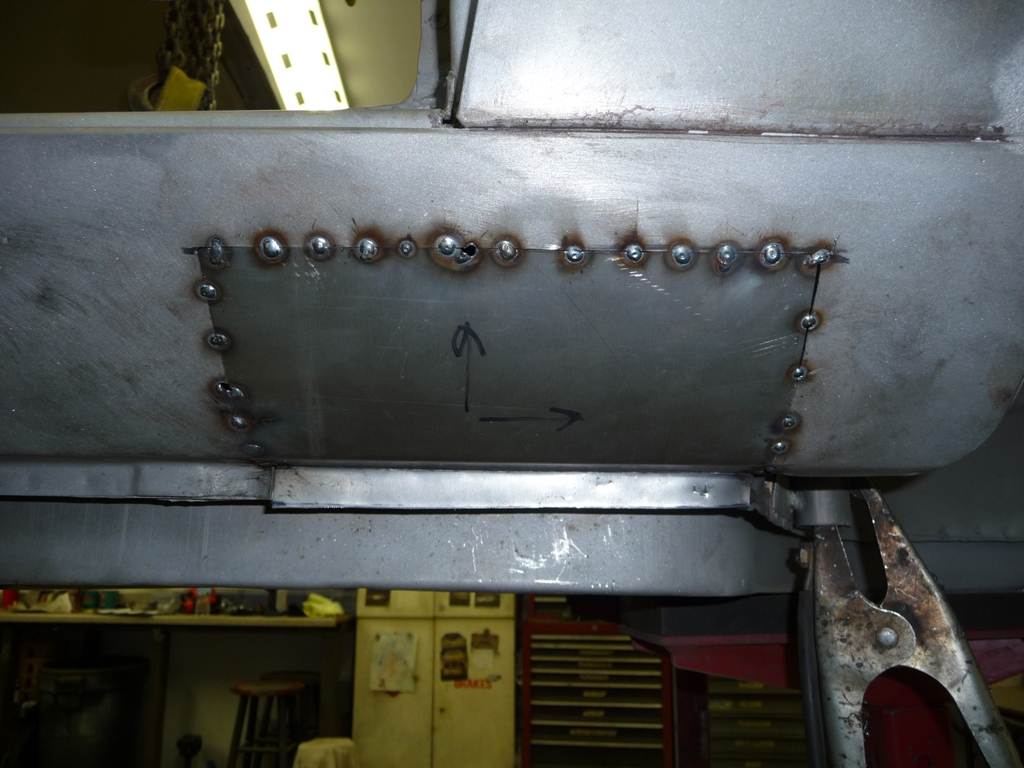
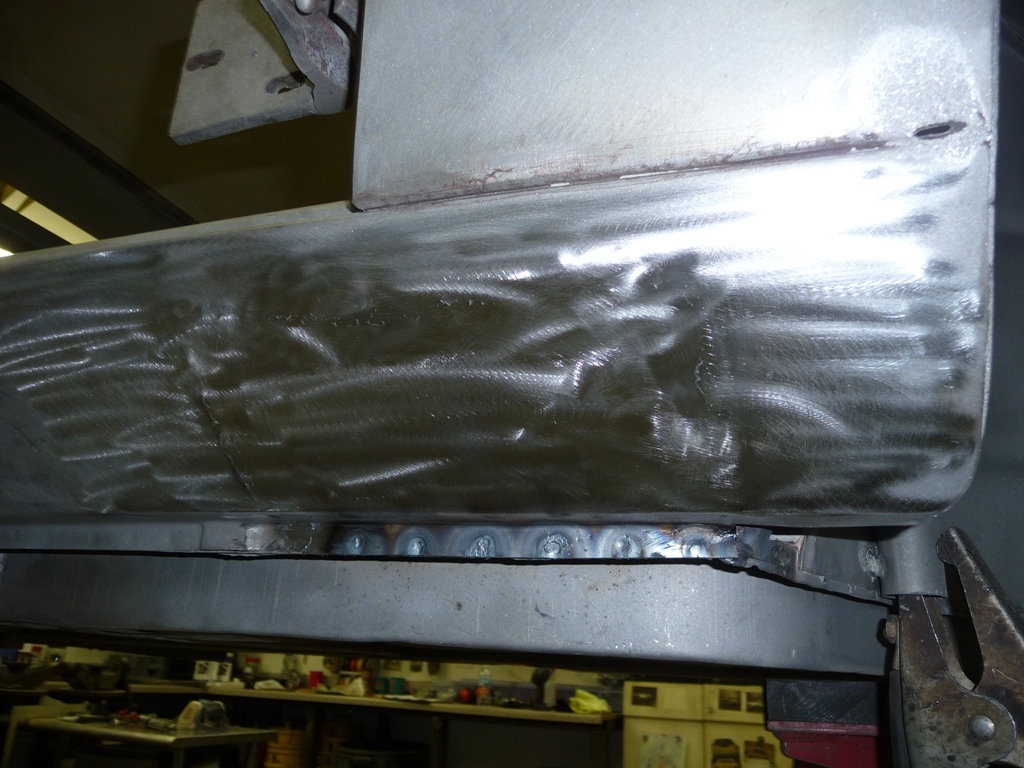

Disassembled the front valence...found some more ugliness to take care of...
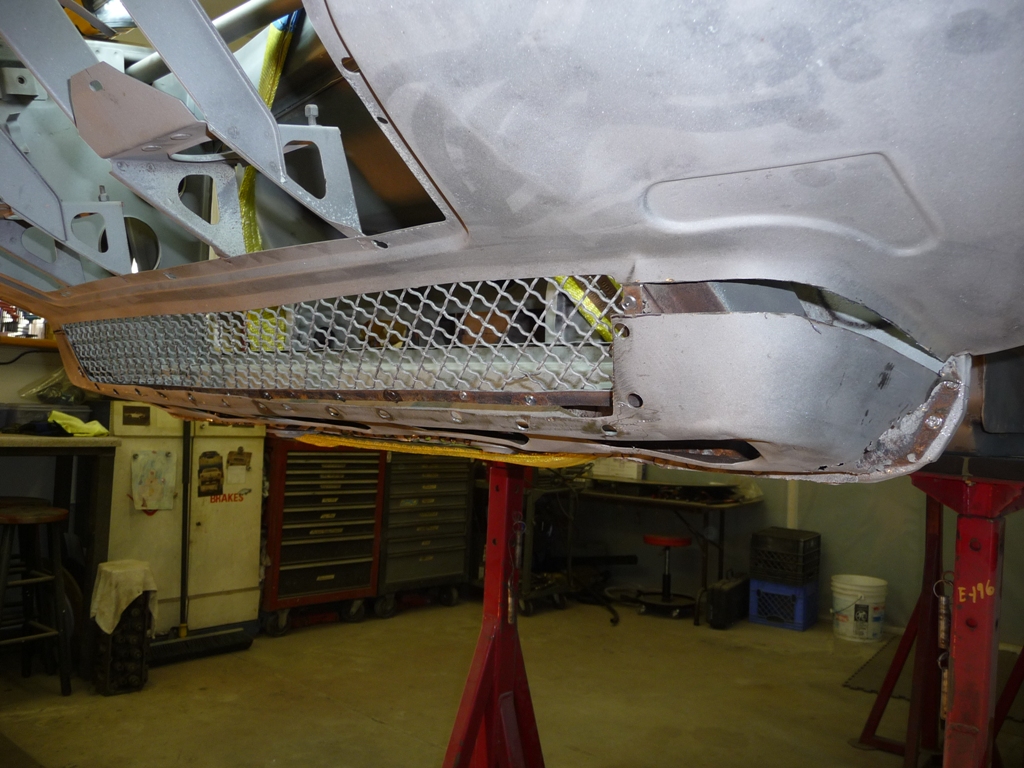
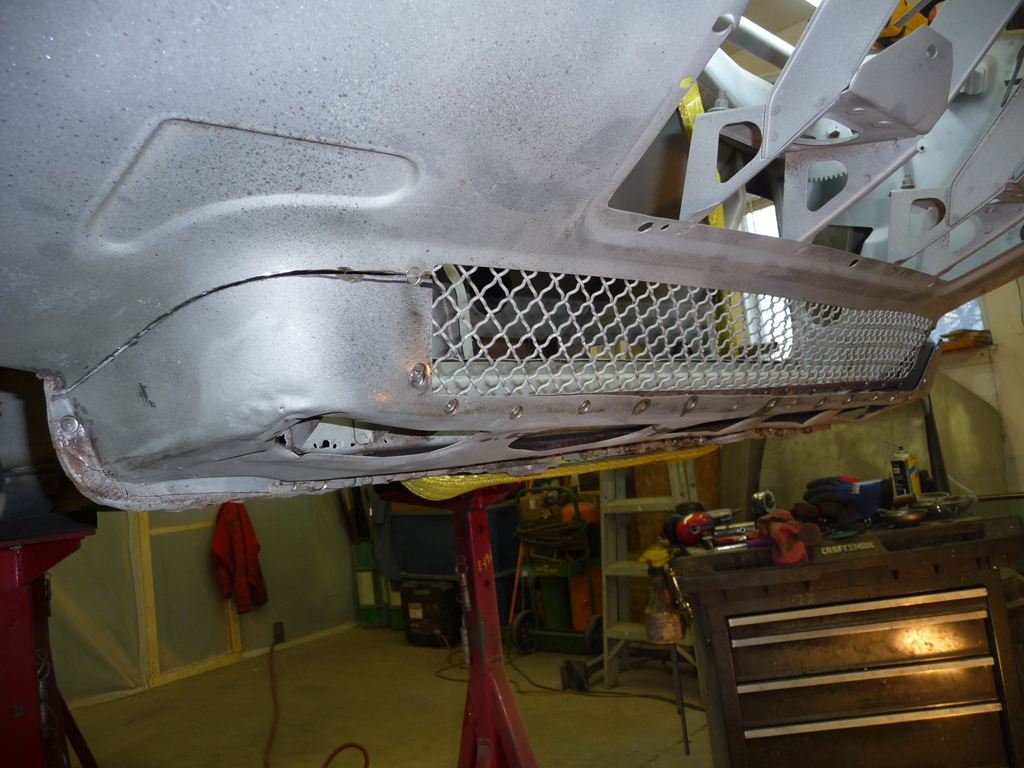
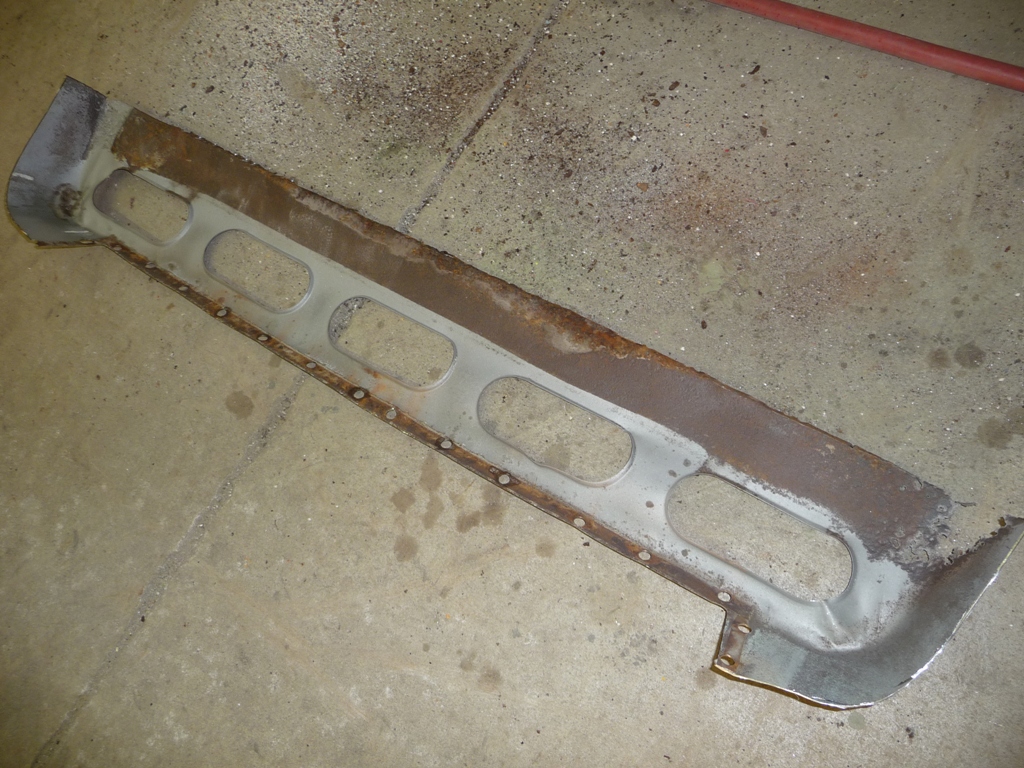
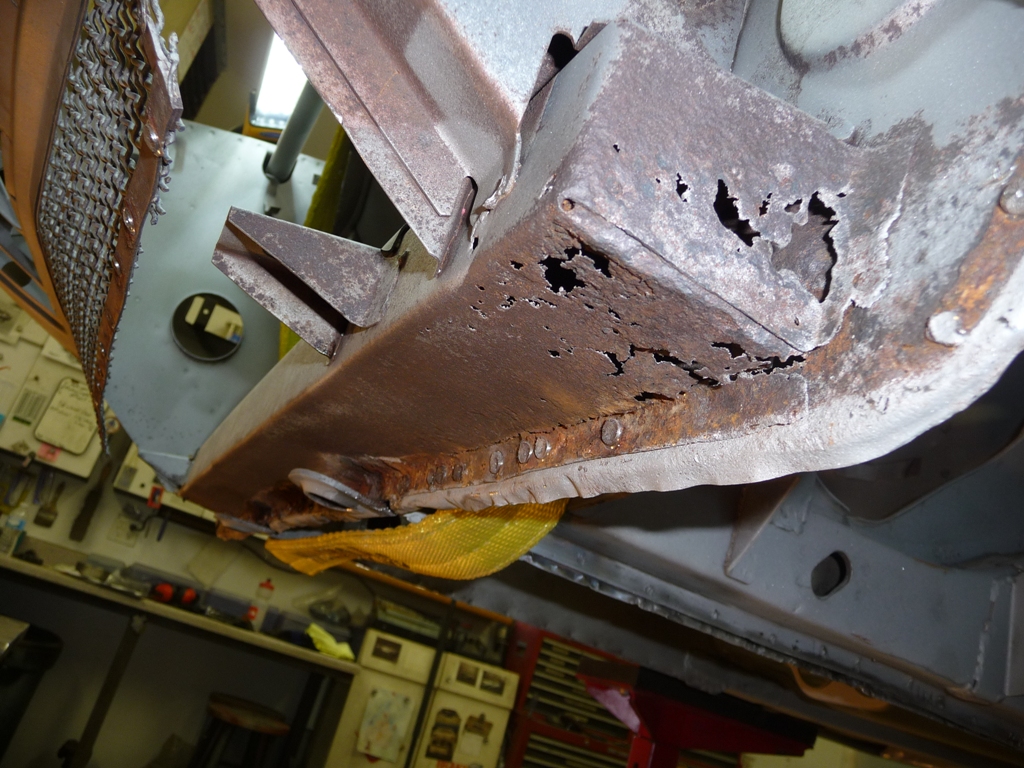
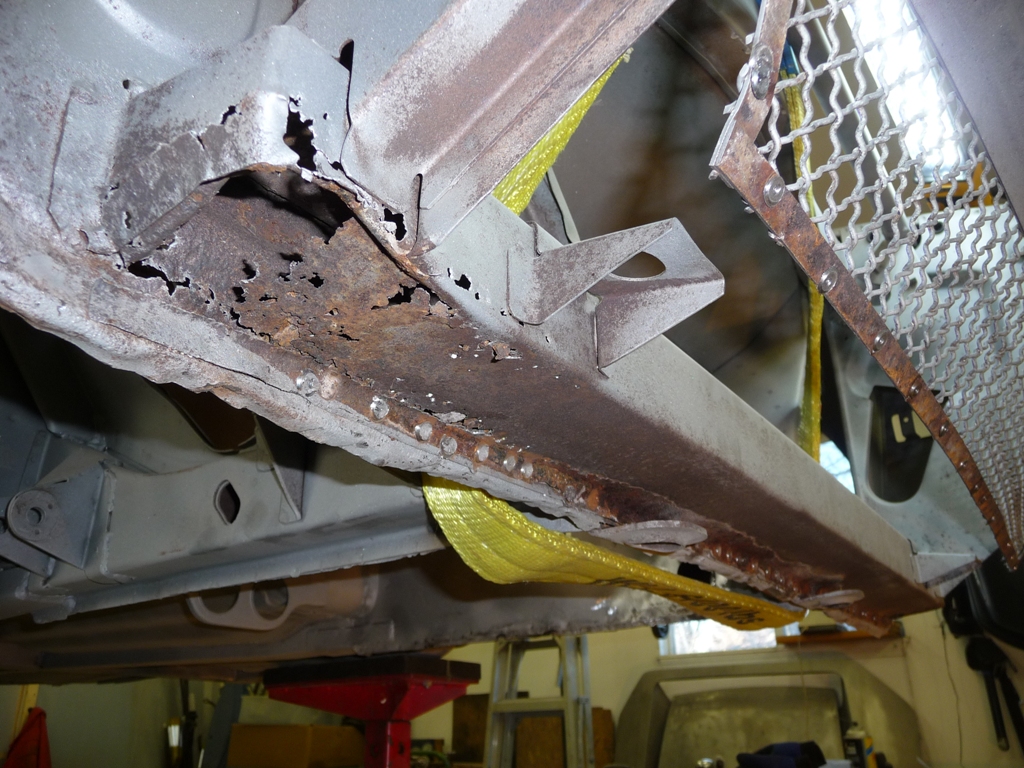
Time to call Johnny...
I'm currently trying to figure out a way to vibrate the chassis to shake out the sand. I need a paint shaker or something to mount to it....
Here's this weekend's progress...
Tackled the passenger side "A" pillar and rocker repair.
Designed in drainage...I like this one better than the others from the driver's side...
Gave a squirt of the frame coating before closing it up.
Disassembled the front valence...found some more ugliness to take care of...
Time to call Johnny...
Hi guys,
OK, so here's what I got done this past weekend.
Started with straightening the left front corner, which had a mild cave in at some point in it's life. It was surprisingly difficult to take pics that showed the benefit of 4 hours of hammering
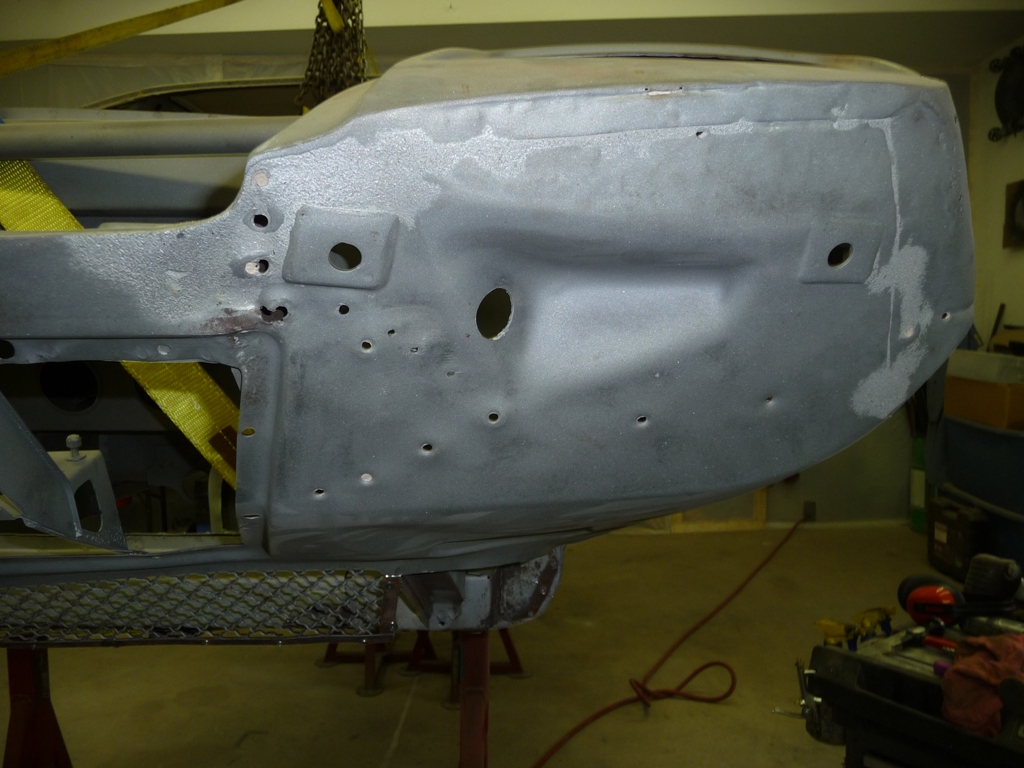
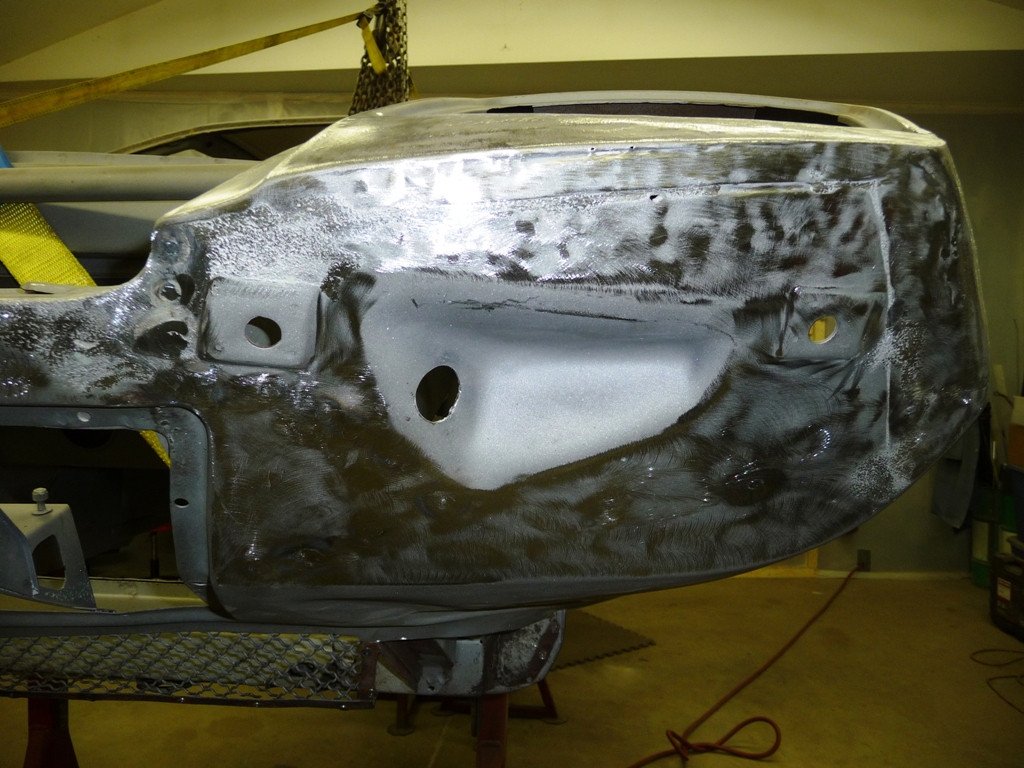
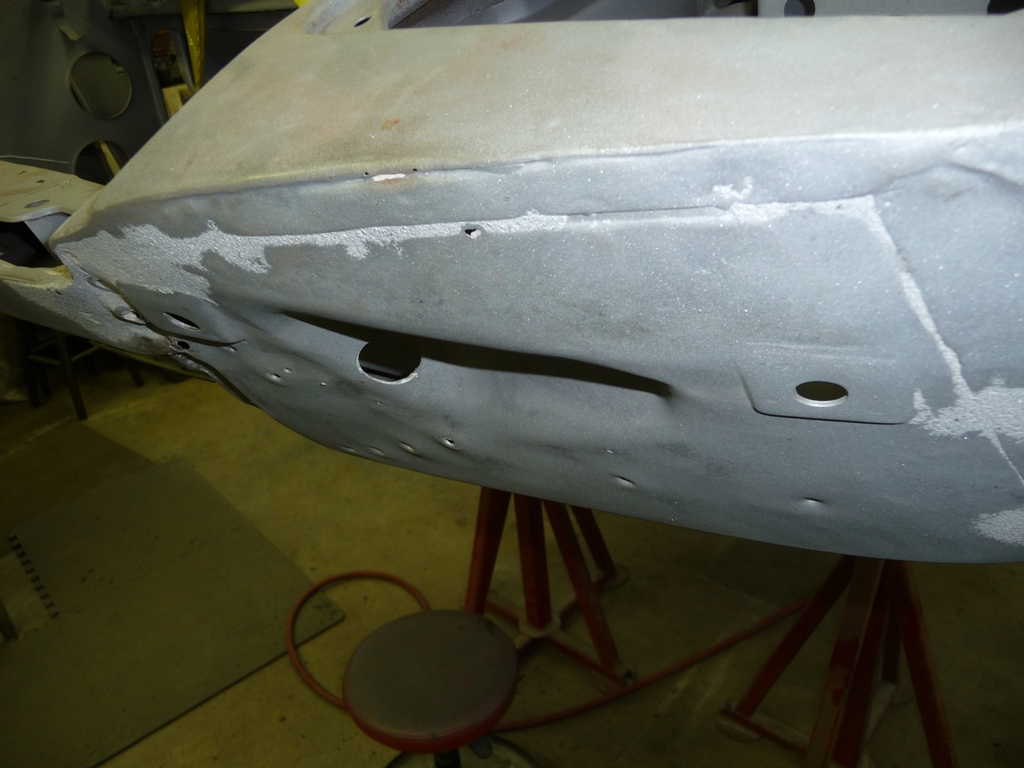
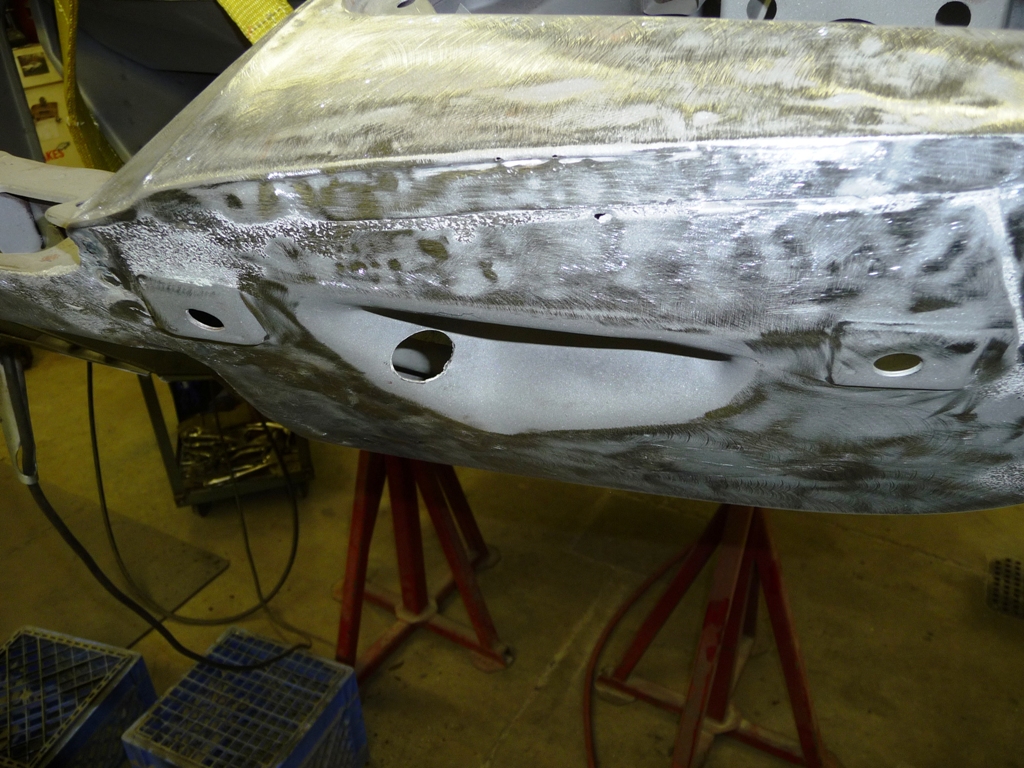

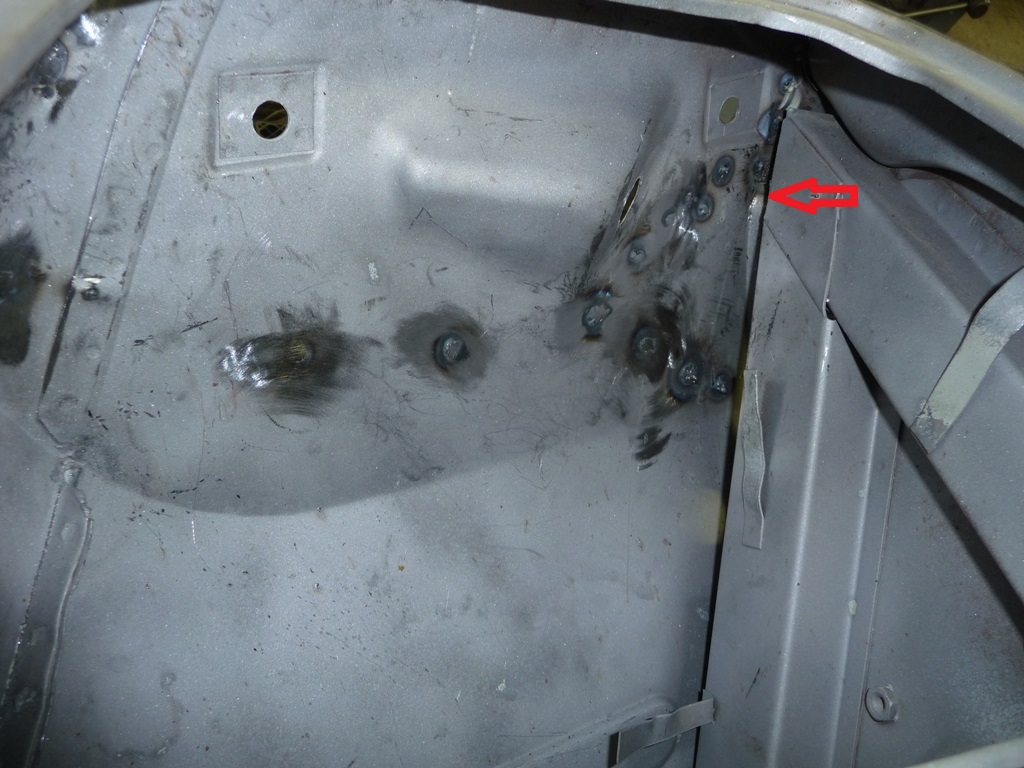
Then, I straightened the grill section. Added red lines for reference.
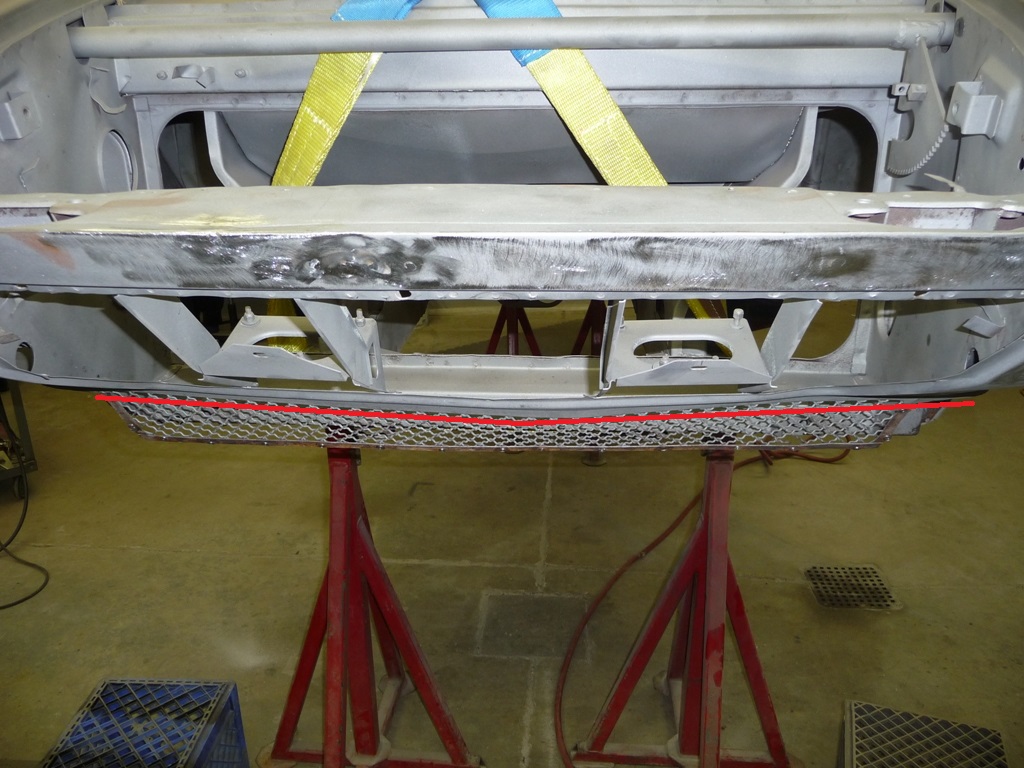

Then I tackled the front cross member...man that was ugliness.
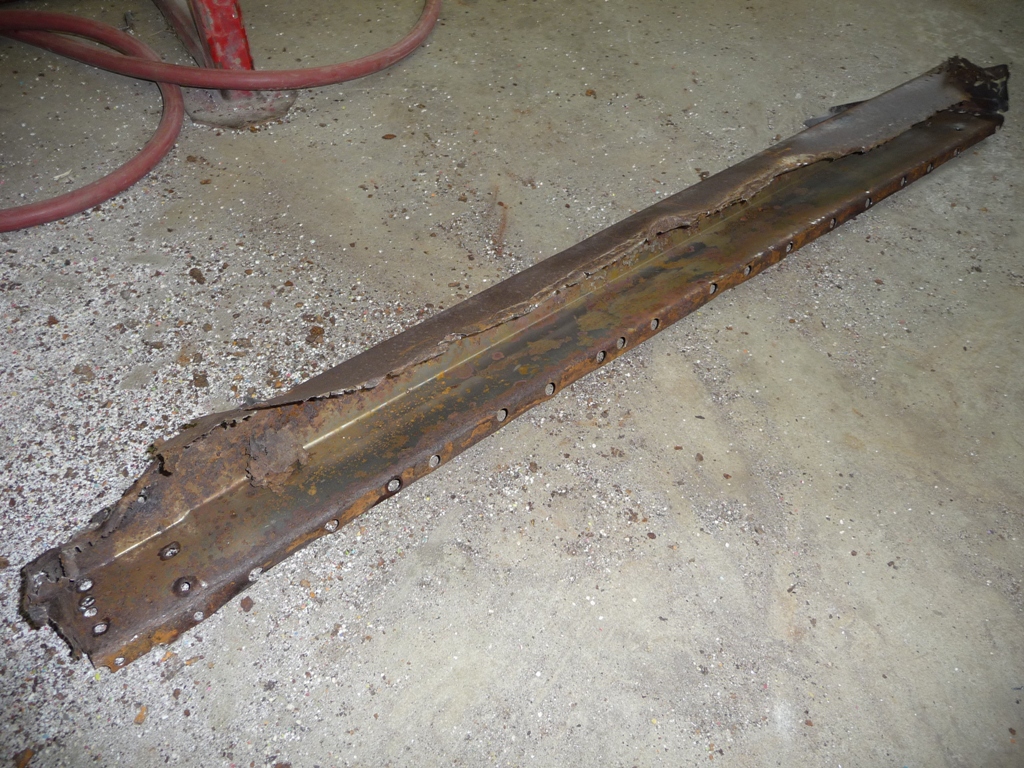
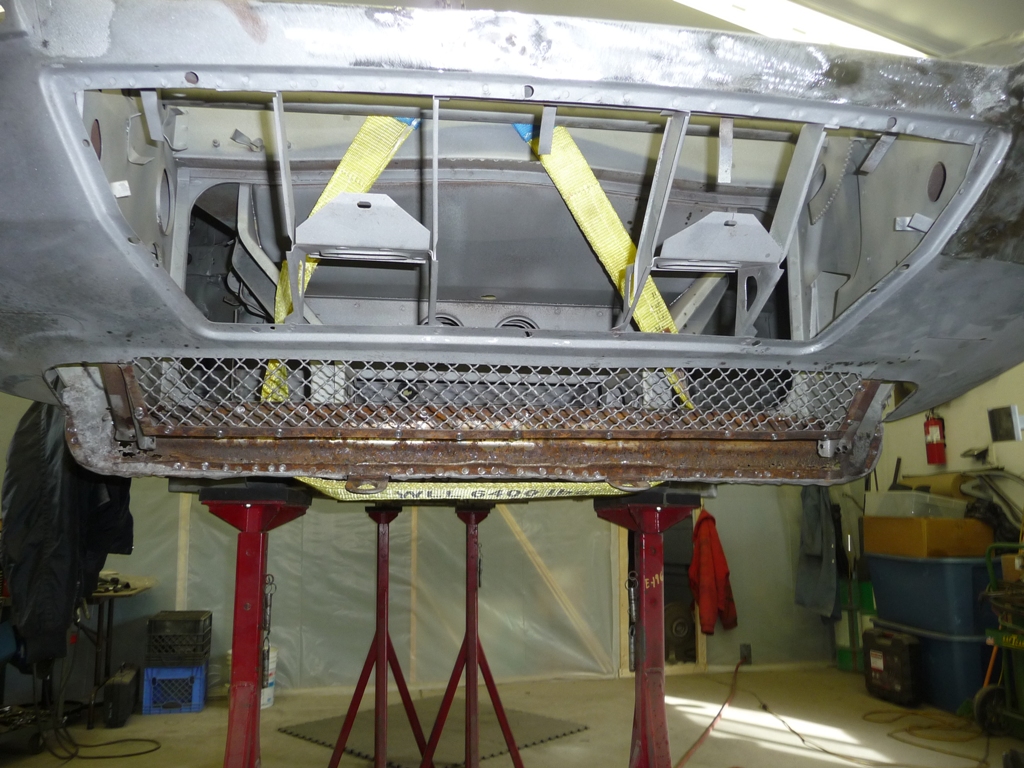
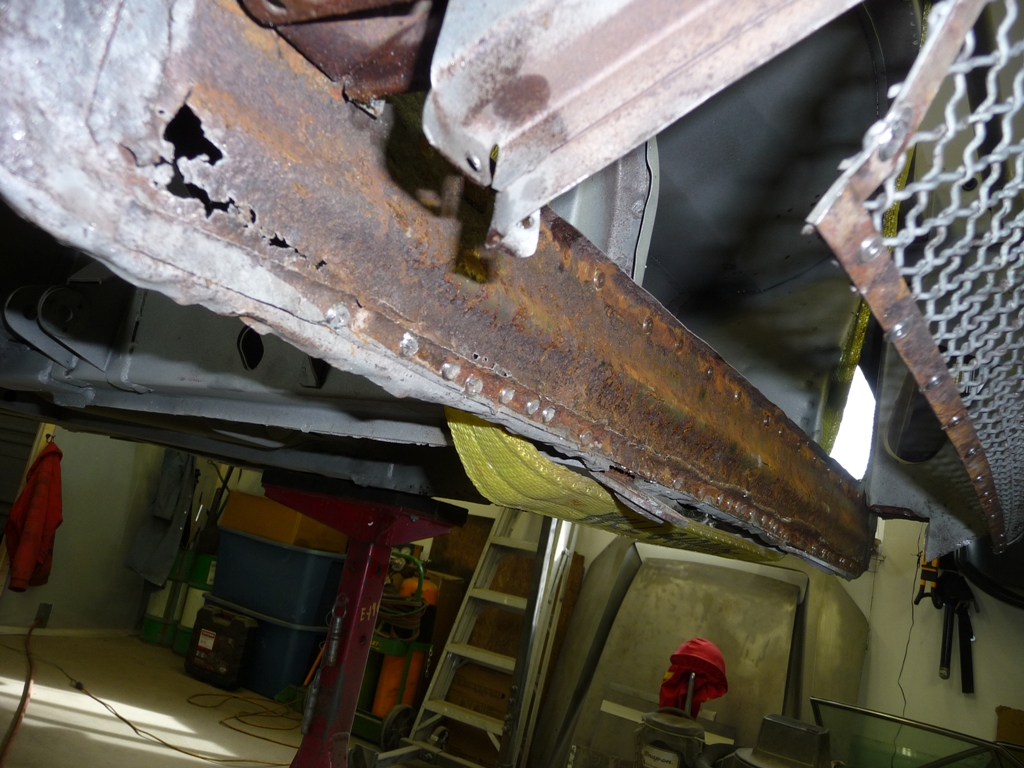
To address the rust in the radiator support behind the cross member, I decided to cut the bottom half off and rebuild it.
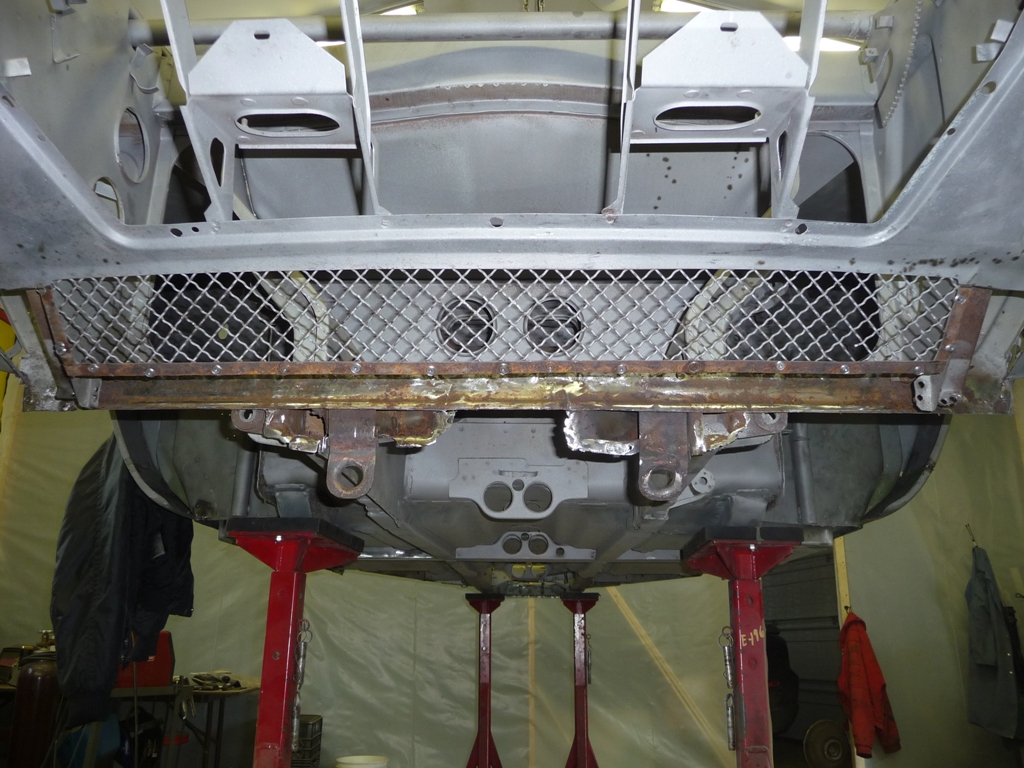
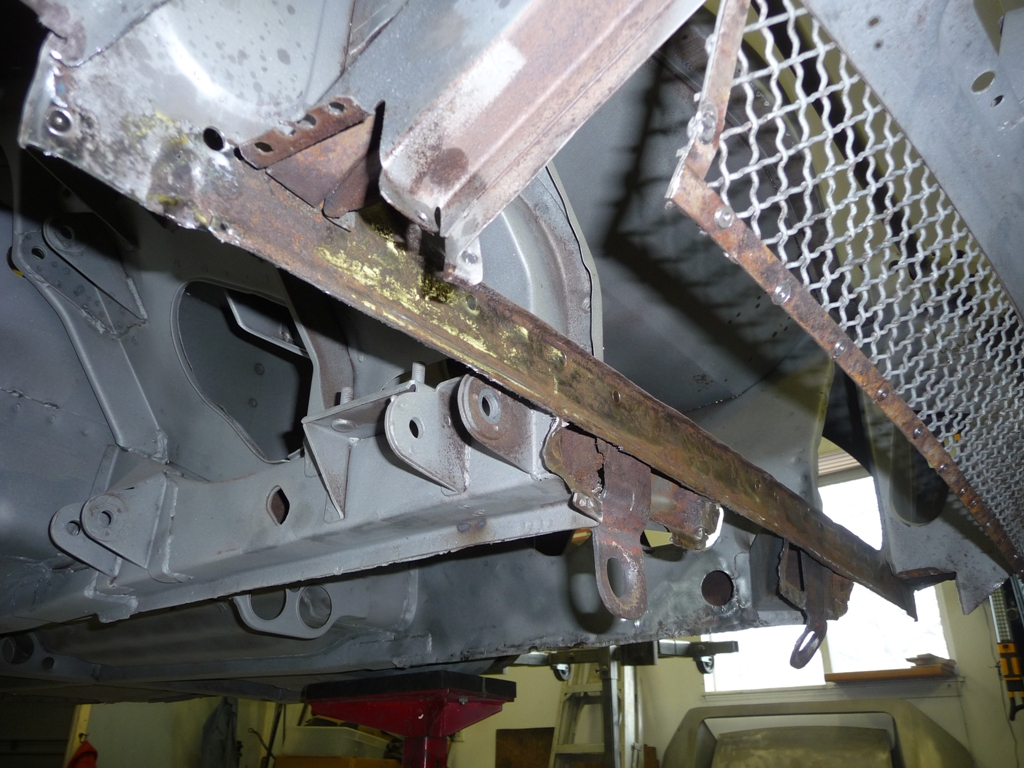
Now I just need to get my parts from Johnny at Woods Automotive, so I can start gluing it all back together again.
OK, so here's what I got done this past weekend.
Started with straightening the left front corner, which had a mild cave in at some point in it's life. It was surprisingly difficult to take pics that showed the benefit of 4 hours of hammering
Then, I straightened the grill section. Added red lines for reference.
Then I tackled the front cross member...man that was ugliness.
To address the rust in the radiator support behind the cross member, I decided to cut the bottom half off and rebuild it.
Now I just need to get my parts from Johnny at Woods Automotive, so I can start gluing it all back together again.
Nice work Rob. It will be a solid car when you're done. Have you considered cutting out the pusher fan supports and upgrading the radiator with a air plenum and pair of draw though fans?
Best,
K
Best,
K
Hi K, Thanks.
Honestly, I don't want to do any modifications from OE config other than bolt-ons. So, I don't want to cut them off. The down side...they will be visible through the grill. The car did have electric fans when I got it which I will reuse (or replace if deemed necessary after closer inspection). What do you mean by air plenum though? Is there some sort of plenum that it is suggested that I fabricate?
Thanks, Rob
Honestly, I don't want to do any modifications from OE config other than bolt-ons. So, I don't want to cut them off. The down side...they will be visible through the grill. The car did have electric fans when I got it which I will reuse (or replace if deemed necessary after closer inspection). What do you mean by air plenum though? Is there some sort of plenum that it is suggested that I fabricate?
Thanks, Rob
quote:Originally posted by Rob Borruso: What do you mean by air plenum though? Is there some sort of plenum that it is suggested that I fabricate? Thanks, Rob
It's just a shroud (plenum) mounted on the backside of the radiator core that the two sucker fans are mounted on so air is drawn more evenly through the core. Like below.
K
Attachments
Gottit K. I have a alum rad for it, and will have to fab something like that up. Thanks for sharing.
Add Reply
Sign In To Reply



